- Privacy Policy

Home » How To Write A Proposal – Step By Step Guide [With Template]

How To Write A Proposal – Step By Step Guide [With Template]
Table of Contents

How To Write A Proposal
Writing a Proposal involves several key steps to effectively communicate your ideas and intentions to a target audience. Here’s a detailed breakdown of each step:
Identify the Purpose and Audience
- Clearly define the purpose of your proposal: What problem are you addressing, what solution are you proposing, or what goal are you aiming to achieve?
- Identify your target audience: Who will be reading your proposal? Consider their background, interests, and any specific requirements they may have.
Conduct Research
- Gather relevant information: Conduct thorough research to support your proposal. This may involve studying existing literature, analyzing data, or conducting surveys/interviews to gather necessary facts and evidence.
- Understand the context: Familiarize yourself with the current situation or problem you’re addressing. Identify any relevant trends, challenges, or opportunities that may impact your proposal.
Develop an Outline
- Create a clear and logical structure: Divide your proposal into sections or headings that will guide your readers through the content.
- Introduction: Provide a concise overview of the problem, its significance, and the proposed solution.
- Background/Context: Offer relevant background information and context to help the readers understand the situation.
- Objectives/Goals: Clearly state the objectives or goals of your proposal.
- Methodology/Approach: Describe the approach or methodology you will use to address the problem.
- Timeline/Schedule: Present a detailed timeline or schedule outlining the key milestones or activities.
- Budget/Resources: Specify the financial and other resources required to implement your proposal.
- Evaluation/Success Metrics: Explain how you will measure the success or effectiveness of your proposal.
- Conclusion: Summarize the main points and restate the benefits of your proposal.
Write the Proposal
- Grab attention: Start with a compelling opening statement or a brief story that hooks the reader.
- Clearly state the problem: Clearly define the problem or issue you are addressing and explain its significance.
- Present your proposal: Introduce your proposed solution, project, or idea and explain why it is the best approach.
- State the objectives/goals: Clearly articulate the specific objectives or goals your proposal aims to achieve.
- Provide supporting information: Present evidence, data, or examples to support your claims and justify your proposal.
- Explain the methodology: Describe in detail the approach, methods, or strategies you will use to implement your proposal.
- Address potential concerns: Anticipate and address any potential objections or challenges the readers may have and provide counterarguments or mitigation strategies.
- Recap the main points: Summarize the key points you’ve discussed in the proposal.
- Reinforce the benefits: Emphasize the positive outcomes, benefits, or impact your proposal will have.
- Call to action: Clearly state what action you want the readers to take, such as approving the proposal, providing funding, or collaborating with you.
Review and Revise
- Proofread for clarity and coherence: Check for grammar, spelling, and punctuation errors.
- Ensure a logical flow: Read through your proposal to ensure the ideas are presented in a logical order and are easy to follow.
- Revise and refine: Fine-tune your proposal to make it concise, persuasive, and compelling.
Add Supplementary Materials
- Attach relevant documents: Include any supporting materials that strengthen your proposal, such as research findings, charts, graphs, or testimonials.
- Appendices: Add any additional information that might be useful but not essential to the main body of the proposal.
Formatting and Presentation
- Follow the guidelines: Adhere to any specific formatting guidelines provided by the organization or institution to which you are submitting the proposal.
- Use a professional tone and language: Ensure that your proposal is written in a clear, concise, and professional manner.
- Use headings and subheadings: Organize your proposal with clear headings and subheadings to improve readability.
- Pay attention to design: Use appropriate fonts, font sizes, and formatting styles to make your proposal visually appealing.
- Include a cover page: Create a cover page that includes the title of your proposal, your name or organization, the date, and any other required information.
Seek Feedback
- Share your proposal with trusted colleagues or mentors and ask for their feedback. Consider their suggestions for improvement and incorporate them into your proposal if necessary.
Finalize and Submit
- Make any final revisions based on the feedback received.
- Ensure that all required sections, attachments, and documentation are included.
- Double-check for any formatting, grammar, or spelling errors.
- Submit your proposal within the designated deadline and according to the submission guidelines provided.
Proposal Format
The format of a proposal can vary depending on the specific requirements of the organization or institution you are submitting it to. However, here is a general proposal format that you can follow:
1. Title Page:
- Include the title of your proposal, your name or organization’s name, the date, and any other relevant information specified by the guidelines.
2. Executive Summary:
- Provide a concise overview of your proposal, highlighting the key points and objectives.
- Summarize the problem, proposed solution, and anticipated benefits.
- Keep it brief and engaging, as this section is often read first and should capture the reader’s attention.
3. Introduction:
- State the problem or issue you are addressing and its significance.
- Provide background information to help the reader understand the context and importance of the problem.
- Clearly state the purpose and objectives of your proposal.
4. Problem Statement:
- Describe the problem in detail, highlighting its impact and consequences.
- Use data, statistics, or examples to support your claims and demonstrate the need for a solution.
5. Proposed Solution or Project Description:
- Explain your proposed solution or project in a clear and detailed manner.
- Describe how your solution addresses the problem and why it is the most effective approach.
- Include information on the methods, strategies, or activities you will undertake to implement your solution.
- Highlight any unique features, innovations, or advantages of your proposal.
6. Methodology:
- Provide a step-by-step explanation of the methodology or approach you will use to implement your proposal.
- Include a timeline or schedule that outlines the key milestones, tasks, and deliverables.
- Clearly describe the resources, personnel, or expertise required for each phase of the project.
7. Evaluation and Success Metrics:
- Explain how you will measure the success or effectiveness of your proposal.
- Identify specific metrics, indicators, or evaluation methods that will be used.
- Describe how you will track progress, gather feedback, and make adjustments as needed.
- Present a detailed budget that outlines the financial resources required for your proposal.
- Include all relevant costs, such as personnel, materials, equipment, and any other expenses.
- Provide a justification for each item in the budget.
9. Conclusion:
- Summarize the main points of your proposal.
- Reiterate the benefits and positive outcomes of implementing your proposal.
- Emphasize the value and impact it will have on the organization or community.
10. Appendices:
- Include any additional supporting materials, such as research findings, charts, graphs, or testimonials.
- Attach any relevant documents that provide further information but are not essential to the main body of the proposal.
Proposal Template
Here’s a basic proposal template that you can use as a starting point for creating your own proposal:
Dear [Recipient’s Name],
I am writing to submit a proposal for [briefly state the purpose of the proposal and its significance]. This proposal outlines a comprehensive solution to address [describe the problem or issue] and presents an actionable plan to achieve the desired objectives.
Thank you for considering this proposal. I believe that implementing this solution will significantly contribute to [organization’s or community’s goals]. I am available to discuss the proposal in more detail at your convenience. Please feel free to contact me at [your email address or phone number].
Yours sincerely,
Note: This template is a starting point and should be customized to meet the specific requirements and guidelines provided by the organization or institution to which you are submitting the proposal.
Proposal Sample
Here’s a sample proposal to give you an idea of how it could be structured and written:
Subject : Proposal for Implementation of Environmental Education Program
I am pleased to submit this proposal for your consideration, outlining a comprehensive plan for the implementation of an Environmental Education Program. This program aims to address the critical need for environmental awareness and education among the community, with the objective of fostering a sense of responsibility and sustainability.
Executive Summary: Our proposed Environmental Education Program is designed to provide engaging and interactive educational opportunities for individuals of all ages. By combining classroom learning, hands-on activities, and community engagement, we aim to create a long-lasting impact on environmental conservation practices and attitudes.
Introduction: The state of our environment is facing significant challenges, including climate change, habitat loss, and pollution. It is essential to equip individuals with the knowledge and skills to understand these issues and take action. This proposal seeks to bridge the gap in environmental education and inspire a sense of environmental stewardship among the community.
Problem Statement: The lack of environmental education programs has resulted in limited awareness and understanding of environmental issues. As a result, individuals are less likely to adopt sustainable practices or actively contribute to conservation efforts. Our program aims to address this gap and empower individuals to become environmentally conscious and responsible citizens.
Proposed Solution or Project Description: Our Environmental Education Program will comprise a range of activities, including workshops, field trips, and community initiatives. We will collaborate with local schools, community centers, and environmental organizations to ensure broad participation and maximum impact. By incorporating interactive learning experiences, such as nature walks, recycling drives, and eco-craft sessions, we aim to make environmental education engaging and enjoyable.
Methodology: Our program will be structured into modules that cover key environmental themes, such as biodiversity, climate change, waste management, and sustainable living. Each module will include a mix of classroom sessions, hands-on activities, and practical field experiences. We will also leverage technology, such as educational apps and online resources, to enhance learning outcomes.
Evaluation and Success Metrics: We will employ a combination of quantitative and qualitative measures to evaluate the effectiveness of the program. Pre- and post-assessments will gauge knowledge gain, while surveys and feedback forms will assess participant satisfaction and behavior change. We will also track the number of community engagement activities and the adoption of sustainable practices as indicators of success.
Budget: Please find attached a detailed budget breakdown for the implementation of the Environmental Education Program. The budget covers personnel costs, materials and supplies, transportation, and outreach expenses. We have ensured cost-effectiveness while maintaining the quality and impact of the program.
Conclusion: By implementing this Environmental Education Program, we have the opportunity to make a significant difference in our community’s environmental consciousness and practices. We are confident that this program will foster a generation of individuals who are passionate about protecting our environment and taking sustainable actions. We look forward to discussing the proposal further and working together to make a positive impact.
Thank you for your time and consideration. Should you have any questions or require additional information, please do not hesitate to contact me at [your email address or phone number].
About the author
Muhammad Hassan
Researcher, Academic Writer, Web developer
You may also like

Grant Proposal – Example, Template and Guide

Business Proposal – Templates, Examples and Guide

Proposal – Types, Examples, and Writing Guide

How to choose an Appropriate Method for Research?

How To Write A Business Proposal – Step-by-Step...

How To Write A Grant Proposal – Step-by-Step...

How to Write a Proposal and Get What You Want (Free Templates)
A proposal has a lot of different purposes, but there’s only one good way to write one: the way that pulls together all of the information in a concise and persuasive way and helps you get what you want … whether that’s a whole new software system, or just a tweak to your marketing strategy.
This Process Street article isn’t about a business proposal — also known as a quote — but instead about the document required when formally pitching an idea for action and execution by managers or department heads .
To explain how to write a proposal document and get what you want, we’ll go through the following:
Free proposal writing template
When are proposals necessary, why are proposals important, examples of proposals, how to write a proposal: step-by-step, last steps before submitting the proposal, more free proposal writing checklists, even more free proposal writing checklists, customize your proposal checklists with process street.
Let’s get started.
If you fancy taking a quick look at a free interactive template, that will help you write your proposals right away, feel free to dive straight into this!
Writing a Proposal: Step-by-Step Guide
There are more templates, like this one, further down in this post, so stick around.
Any project you don’t have the clearance or authority to start without a higher-up’s approval, you need to submit a proposal for.
According to SSWM , a proposal is “a detailed description of a series of activities aimed at solving a certain problem”.
That problem could be anything, from:
- Process improvement
- Cost reduction
- A new marketing strategy
If it’s an idea you need to ask permission to execute, or to get action on, it needs a proposal.
A proposal is a way to pitch an idea and state your requirements, so it’s important for supervisors because they can get information in writing (not casually in the elevator), and be able to act knowing the full implications of their decision.
They’re also a chance for you to make a structured, logical argument and lay down everything in favor of your idea. A well-written proposal shows your manager you care about the cause, and it’s not just a mid-meeting whim you blurted out.
To write a top proposal you need to scrutinize it before you present it.
It’s a broad topic, but it’s best explained with examples.
- Proposal for Process Improvement
- Proposal for Server Replacement
- Proposal for Cost Savings
Below is a simple proposal example with some basic sections.
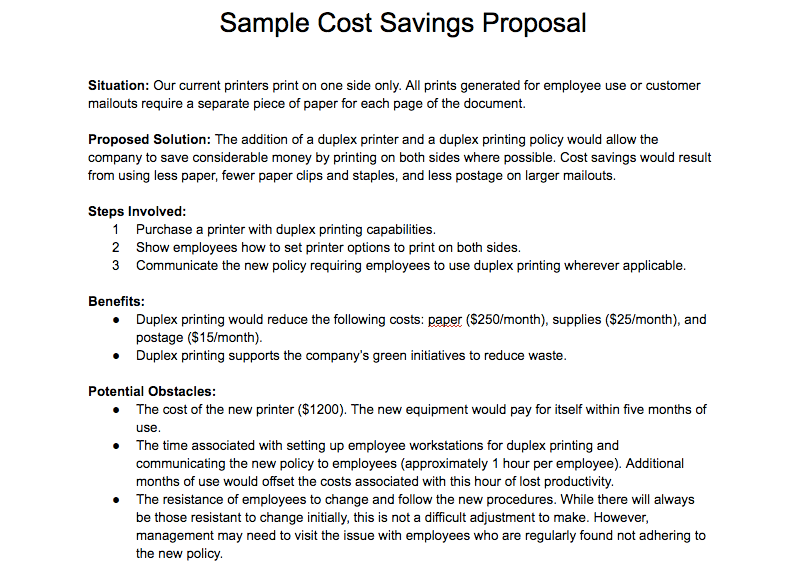
Now let’s take a look at how to write a proposal — whether it’s as simple as the one above, or more complex.
Here’s the general structure of a proposal:
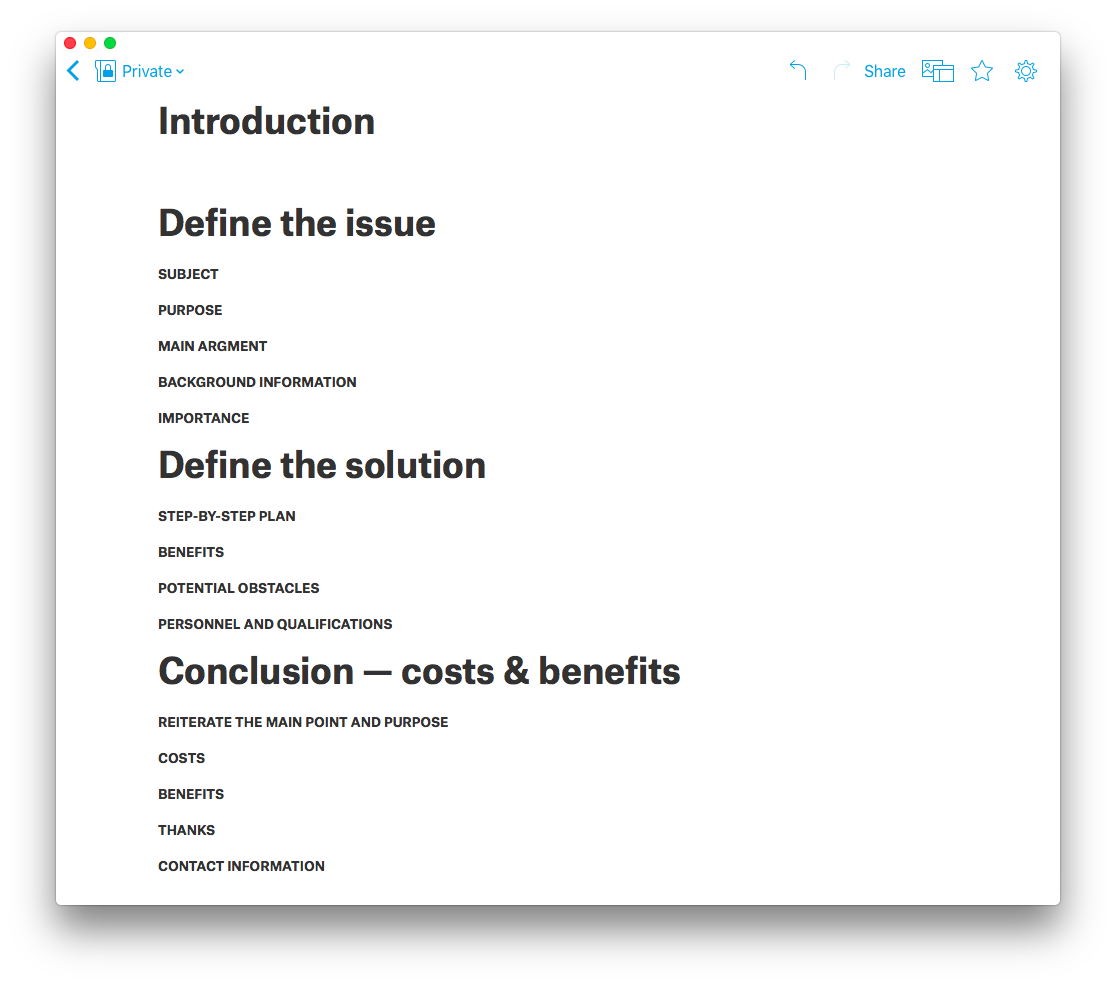
As you can see, a proposal generally consists of:
- Introduction : A brief overview of the problem, solution, costs, and benefits.
- Issue : The main definition of the issue, including subject, purpose, main argument, background information and importance.
- Solution : The main definition of the solution, including your step-by-step plan, the benefits, and how potential obstacles will be overcame.
- Qualifications : Overview of the personnel required, experience.
- Conclusion of the costs and benefits, and wrap-up : Balance the cost against the benefit, reinforce your point one last time.
1. Identify and define your reader
Just like with any kind of persuasion, it helps if you understand how to appeal to your audience. Who will be reading your proposal and deciding if it’s accepted or rejected? What do they care about? What kind of language and benefits would resonate with them? This is the first step because it’s an important thing to keep in mind as you go along and as information that informs the way you write from here on.
2. Define the problem your proposal will solve
Who : Who will the proposal affect?
What : What’s the reason for you to write the proposal in the first place? Explain the current situation and the problems that come with it.
3. Define the solution
How : How are you going to solve the problem? Explain step-by-step in detail.
Who : Identify the personnel you need, along with their prior experience to add persuasion to the proposal
4. Conclusion: costs, benefits and wrap-up
Reiterate : The purpose and main argument
Costs : Break down the projected costs involved for different elements of the project
Benefits : Break down the benefits to the organization, monetary and non-monetary, to persuade the reader there’ll be a return on investment
Thanks : Thank the reader for their time.
Contact information : Where can the reader get in touch with you? Make sure to be crystal clear to make the details easily discoverable.
Clear writing is your best friend when you’re trying to write persuasively. For that reason, there are a few checks to run before you submit your proposal.
Remember, what’s clear to you might not always be clear to other people.
1 .Check for jargon (then destroy it)
Although jargon is popular in the business world, not everyone shares the equal love for it. It’s terms like right-size, blue sky (verb), turn-key, and synergize. They might mean something to you, or make you feel intelligent, but there are simpler alternatives that will help people understand what you mean !
2. Change the passive voice to the active voice
The passive voice is defined as :
“The noun or noun phrase that would be the object of an active sentence (such as Our troops defeated the enemy) appears as the subject of a sentence with passive voice (e.g. The enemy was defeated by our troops).”.
It’s a long-winded way of expressing something that could be expressed in simple terms:

The passive voice sounds distant and even deceptive, and, since the reader might even just be skimming your proposal, you don’t want to add extra words to cloud your point.
3. Proofread the proposal
Install a tool like Grammarly and check the proposal in an online text editor. Grammarly will manage to pick up on anything that is grammatically incorrect and sometimes even flags up stylistically poor phrases. Poor spelling and grammar will only discredit the value of what you’re saying and could be a problem that leads to your proposal being rejected.
As promised, check out the below five templates that have each been designed by the team at Process Street — makers of the finest remote work software for processes around — to help you write winning proposals.
Proposal Template Checklist Process
This proposal template is a checklist that should be used alongside the proposal document you are planning to submit. Use it to make sure that all the elements have been considered, that the proposal contains everything it needs to and that it meets all set requirements.
Click here to access the Proposal Template Checklist Process!
Business Proposal Template Checklist
Whether your business proposal is solicited or unsolicited, use this business proposal template checklist to ensure you include all the required information in your proposal and cover key areas such as these the problem the organization is facing, the proposed solution, the budget, and a key CTA.
Click here to access the Business Proposal Template Checklist!
How to Write a Grant Proposal Checklist
Use this template to make sure your grant proposal includes all the relevant information, that it contains everything it needs to, and that it meets all stated RFP requirements.
Click here to access the How to Write a Grant Proposal Checklist!
Research Proposal Example Checklist
Use this template to convince others that you have a worthwhile research project and that you have the competence and the work-plan to complete it.
Click here to access the Research Proposal Example Checklist!
Project Proposal Template Checklist
Use this template, alongside the proposal document you are planning to submit, to set the project vision, define the project requirements, describe the deliverables, and specify the deadlines.
Click here to access the Project Proposal Template Checklist!
If you’re looking for more inspiration, give these alternative proposal writing templates a go too.
- Bid Proposal Template Checklist
- Budget Proposal Template
- Construction Proposal Template Checklist
- Consulting Proposal Template Checklist
- Continuation Project Proposal Template
- Contractor Proposal Template Checklist
- Event Proposal Template Checklist
- Marketing Proposal Template Checklist
- Project Proposal Template
- Renewal Project Proposal Template
- Simple Proposal Format Checklist
- Sponsorship Proposal Template Checklist
- Supplemental Project Proposal Template
- Website Proposal Template Checklist
If the above templates don’t quite fit your company, industry, or the proposal document you are writing, don’t worry!
Process Street to the rescue!
Process Street is super-powered checklists . We are a super-charged, state of the art BPM SaaS platform which allows you to create templates and run individual checklists from these. You can check tasks off as you work through them, set deadlines, request approvals, assign various tasks , and work through your proposal workflows with ease.
Watch this to get an idea about who we are and what we do:
To help you customize your proposal writing template, and make your proposal wriitng easier, you can use all these different types of Process Street features:
- Dynamic due dates
- Task permissions
- Conditional logic
- Approval tasks
- Embed widget
- Role assignments
You can also connect your templates to thousands of apps through Zapier , webhooks, or API access to automate your proposal processes and workflows.
If you’re unfamiliar with process automation, what it means, and the benefits it can bring to your business, watch this Process Street webinar on automation:
Remember, if you want to get access to any of our proposal writing checklists, just click the links above and they will be added to your Process Street account where you can use them over and over again. Or, if you haven’t yet signed up for a Process Street account, click here and start your free trial.
Has this guide helped you out? I’d love to hear about it in the comments.
Get our posts & product updates earlier by simply subscribing
Benjamin Brandall
Benjamin Brandall is a content marketer at Process Street .
Leave a Reply Cancel reply
Your email address will not be published. Required fields are marked *
Save my name, email, and website in this browser for the next time I comment.
Take control of your workflows today
- Contact sales
Start free trial
How to Write a Project Proposal (Examples & Template Included)

Table of Contents
What is a project proposal, types of project proposals, project proposal vs. project charter, project proposal vs. business case, project proposal vs. project plan, project proposal outline, how to write a project proposal, project proposal example, project proposal tips.
- ProjectManager & Project Proposals
A project proposal is a project management document that’s used to define the objectives and requirements of a project. It helps organizations and external project stakeholders agree on an initial project planning framework.
The main purpose of a project proposal is to get buy-in from decision-makers. That’s why a project proposal outlines your project’s core value proposition; it sells value to both internal and external project stakeholders. The intent of the proposal is to grab the attention of stakeholders and project sponsors. Then, the next step is getting them excited about the project summary.
Getting into the heads of the audience for which you’re writing the project proposal is vital: you need to think like the project’s stakeholders to deliver a proposal that meets their needs.
We’ve created a free project proposal template for Word to help structure documents, so you don’t have to remember the process each time.

Get your free
Project Proposal Template
Use this free Project Proposal Template for Word to manage your projects better.
In terms of types of project proposals, you can have one that’s formally solicited, informally solicited or a combination. There can also be renewal and supplemental proposals. Here’s a brief description of each of them.
- Solicited project proposal: This is sent as a response to a request for proposal (RFP) . Here, you’ll need to adhere to the RFP guidelines of the project owner.
- Unsolicited project proposal: You can send project proposals without having received a request for a proposal. This can happen in open bids for construction projects , where a project owner receives unsolicited project proposals from many contractors.
- Informal project proposal: This type of project proposal is created when a client asks for an informal proposal without an RFP.
- Renewal project proposal: You can use a renewal project proposal when you’re reaching out to past customers. The advantage is that you can highlight past positive results and future benefits.
- Continuation project proposal: A continuation project proposal is sent to investors and stakeholders to communicate project progress.
- Supplemental project proposal: This proposal is sent to investors to ask for additional resources during the project execution phase.
A project proposal is a detailed project document that’s used to convince the project sponsor that the project being proposed is worth the time, money and effort to deliver it. This is done by showing how the project will address a business problem or opportunity. It also outlines the work that will be done and how it will be done.
A project charter can seem like the same thing as a project proposal as it also defines the project in a document. It identifies the project objectives, scope, goals, stakeholders and team. But it’s done after the project has been agreed upon by all stakeholders and the project has been accepted. The project charter authorizes the project and documents its requirements to meet stakeholders’ needs.
A business case is used to explain why the proposed project is justified. It shows that the project is worth the investment of time and money. It’s more commonly used in larger companies in the decision-making process when prioritizing one project over another.
The business case answers the questions: what is the project, why should it be taken up, who will be involved and how much will it cost? It’s therefore related to a project proposal, but the project proposal comes before the business case and is usually part of the larger proposal.
Again, the project proposal and the project plan in this case are very similar documents. It’s understandable that there would be some confusion between these two project terms. They both show how the project will be run and what the results will be. However, they’re not the same.
The project proposal is a document that aims to get a project approved and funded. It’s used to convince stakeholders of the viability of the project and their investment. The project plan, on the other hand, is made during the planning phase of the project, once it’s been approved. It’s a detailed outline of how the project will be implemented, including schedule, budget, resources and more.
All the elements in the above project proposal outline are present in our template. This free project proposal template for Word will provide you with everything you need to write an excellent project proposal. It will help you with the executive summary, project process, deliverables, costs—even terms and conditions. Download your free template today.

There are several key operational and strategic questions to consider, including:
- Executive summary: This is the elevator pitch that outlines the project being proposed and why it makes business sense. While it also touches on the information that’ll follow in the project proposal, the executive summary should be brief and to the point.
- Project background: This is another short part of the proposal, usually only one page, which explains the problem you’ll solve or the opportunity you’re taking advantage of with the proposed project. Also, provide a short history of the business to put the company in context to the project and why it’s a good fit.
- Project vision & success criteria: State the goal of the project and how it aligns with the goals of the company. Be specific. Also, note the metrics used to measure the success of the project.
- Potential risks and mitigation strategies: There are always risks. Detail them here and what strategies you’ll employ to mitigate any negative impact as well as take advantage of any positive risk.
- Project scope & deliverables: Define the project scope, which is all the work that has to be done and how it will be done. Also, detail the various deliverables that the project will have.
- Set SMART goals: When setting goals, be SMART. That’s an acronym for specific, measurable, achievable, relevant and time-bound. All your goals would be defined by those five things.
- Project approach: Define the approach you’ll use for the contract. There are several different types of contracts used in construction , for example, such as lump sum, cost plus, time and materials, etc. This is also a good place to describe the delivery method you’ll use.
- Expected benefits: Outline the benefits that will come from the successful completion of the project.
- Project resource requirements: List the resources, such as labor, materials, equipment, etc., that you’ll need to execute the project if approved.
- Project costs & budget: Detail all the costs, including resources, that’ll be required to complete the project and set up a budget to show how those costs will be spent over the course of the project.
- Project timeline: Lay out the project timeline , which shows the project from start to finish, including the duration of each phase and the tasks within it, milestones, etc.
In addition to these elements, it’s advisable to use a cover letter, which is a one-page document that helps you introduce your project proposal and grab the attention of potential clients and stakeholders.
To make the best proposal possible, you’ll want to be thorough and hit on all the points we’ve listed above. Here’s a step-by-step guide to writing a persuasive priority proposal.
1. Write an Executive Summary
The executive summary provides a quick overview of the main elements of your project proposal, such as your project background, project objectives and project deliverables, among other things. The goal is to capture the attention of your audience and get them excited about the project you’re proposing. It’s essentially the “elevator pitch” for the project life cycle. It should be short and to the point.
The executive summary should be descriptive and paint a picture of what project success looks like for the client. Most importantly, it should motivate the project client; after all, the goal is getting them to sign on the dotted line to get the project moving!
2. Provide a Project Background
The project background is a one-page section of your project proposal that explains the problem that your project will solve. You should explain when this issue started, its current state and how your project will be the ideal solution.
- Historic data: The history section outlines previously successful projects and those that could have run more smoothly. By doing so, this section establishes precedents and how the next project can be more effective using information from previous projects.
- Solution: The solution section addresses how your project will solve the client’s problem. Accordingly, this section includes any project management techniques , skills and procedures your team will use to work efficiently.
3. Establish a Project Vision & Success Criteria
You’ll need to define your project vision. This is best done with a vision statement, which acts as the north star for your project. It’s not specific as much as it’s a way to describe the impact your company plans to make with the project.
It’s also important to set up success criteria to show that the project is in fact doing what it’s proposed to do. Three obvious project success criteria are the triple constraint of cost, scope and time. But you’ll need to set up a way to measure these metrics and respond to them if they’re not meeting your plan.
4. Identify Potential Risks and Mitigation Strategies
To reduce the impact of risk in your project, you need to identify what those risks might be and develop a plan to mitigate them . List all the risks, prioritize them, describe what you’ll do to mitigate or take advantage of them and who on the team is responsible for keeping an eye out for them and resolving them.
5. Define Your Project Scope and Project Deliverables
The project scope refers to all the work that’ll be executed. It defines the work items, work packages and deliverables that’ll be delivered during the execution phase of your project life cycle. It’s important to use a work breakdown structure (WBS) to define your tasks and subtasks and prioritize them.
6. Set SMART Goals for Your Project Proposal
The best mindset when developing goals and objectives for your project proposal is to use the SMART system :
- Specific – Make sure your goals and objectives are clear, concise and specific to the task at hand.
- Measurable – Ensure your goals and objectives are measurable so it’s obvious to see when things are on track and going well, and conversely, when things are off track and issues need to be addressed. Measurable goals make it easy to develop the milestones you’ll use to track the progress of the project and identify a reasonable date for completion and/or closure.
- Attainable – It’s important every project has a “reach” goal. Hitting this goal would mean an outstanding project that extends above and beyond expectations. However, it’s important that the project’s core goal is attainable, so morale stays high and the job gets done with time and resources to spare.
- Relevant – Make sure all of your goals are directly relevant to the project and address the scope within which you’re working.
- Time-Based – Timelines and specific dates should be at the core of all goals and objectives. This helps keep the project on track and ensures all project team members can manage the work that’s ahead of them.
7. Explain What’s Your Project Approach
Your project approach defines the project management methodology , tools and governance for your project. In simple terms, it allows project managers to explain to stakeholders how the project will be planned, executed and controlled successfully.
8. Outline The Expected Benefits of Your Project Proposal
If you want to convince internal stakeholders and external investors, you’ll need to show them the financial benefits that your project could bring to their organization. You can use cost-benefit analysis and projected financial statements to demonstrate why your project is profitable.
9. Identify Project Resource Requirements
Project resources are critical for the execution of your project. The project proposal briefly describes what resources are needed and how they’ll be used. Later, during the planning phase, you’ll need to create a resource management plan that’ll be an important element of your project plan. Project requirements are the items, materials and resources needed for the project. This section should cover both internal and external needs.
10. Estimate Project Costs and Project Budget
All the resources that you’ll need for your project have a price tag. That’s why you need to estimate those costs and create a project budget . The project budget needs to cover all your project expenses, and as a project manager, you’ll need to make sure that you adhere to the budget.
11. Define a Project Timeline
Once you’ve defined your project scope, you’ll need to estimate the duration of each task to create a project timeline. Later during the project planning phase , you’ll need to create a schedule baseline, which estimates the total length of your project. Once the project starts, you’ll compare your actual project schedule to the schedule baseline to monitor progress.
Now let’s explore some project proposal examples to get a better understanding of how a project proposal would work in the real world. For this example, let’s imagine a city that’s about to build a rapid transit system. The city government has the funds to invest but lacks the technical expertise and resources that are needed to build it, so it issues a request for proposal (RFP) document and sends it to potential builders.
Then, the construction companies that are interested in executing this rapid transit project will prepare a project proposal for the city government. Here are some of the key elements they should include.
- Project background: The construction firm will provide an explanation of the challenges that the project presents from a technical perspective, along with historical data from similar projects that have been completed successfully by the company.
- Project vision & success criteria: Write a vision statement and explain how you’ll track the triple constraint to ensure the successful delivery of the project.
- Potential risks and mitigation strategies: List all risks and how they’ll be mitigated, and be sure to prioritize them.
- Project scope & deliverables: The work that’ll be done is outlined in the scope, including all the deliverables that’ll be completed over the life cycle of the project.
- Set SMART goals: Use the SMART technique to define your project goals by whether they’re specific, measurable, achievable, relevant and time-bound.
- Project approach: Define the methodology that the project manager will employ to manage the project. Also, figure out what type of contract will be used to define the project.
- Expected benefits: Show how the project will deliver advantages to the company and define what these benefits are in a quantifiable way.
- Project resource requirements: List all the resources, such as labor, materials, equipment, etc., needed to execute the project.
- Project costs & budget: Estimate the cost of the project and lay that out in a project budget that covers everything from start to finish.
- Project timeline: Outline the project schedule, including phases, milestones and task duration on a visual timeline.
Whatever project proposal you’re working on, there are a few tips that apply as best practices for all. While above we suggested a project proposal template that would have a table of contents, meaning it would be many pages long, the best-case scenario is keeping the proposal to one or two pages max. Remember, you’re trying to win over stakeholders, not bore them.
Speaking of project stakeholders , do the research. You want to address the right ones. There’s no point in doing all the work necessary to write a great proposal only to have it directed to the wrong target audience. Whoever is going to read it, though, should be able to comprehend the proposal. Keep the language simple and direct.
When it comes to writing, get a professional. Even a business document like a project proposal, business case or executive summary will suffer if it’s poorly constructed or has typos. If you don’t want to hire a professional business writer, make sure you get someone on your project team to copy, edit and proof the document. The more eyes on it, the less likely mistakes will make it to the final edition.
While you want to keep the proposal short and sweet, it helps to sweeten the pot by adding customer testimonials to the attachments. Nothing sells a project plan better than a customer base looking for your product or service.
ProjectManager & Project Proposals
ProjectManager allows you to plan proposals within our software. You can update tasks for the project proposal to signify where things stand and what’s left to be done. The columns allow you to organize your proposal by section, creating a work breakdown structure (WBS) of sorts.
When building a project proposal, it’s vital to remember your target audience. Your audience includes those who are excited about the project, and see completion as a gain for their organization. Conversely, others in your audience will see the project as a pain and something to which they aren’t looking forward. To keep both parties satisfied, it’s essential to keep language factual and concise.
Our online kanban boards help you think through that language and collaborate on it effectively with other team members, if necessary. Each card shows the percentage completed so everyone in the project management team is aware of the work done and what’s left to be done.

As you can see from the kanban board above, work has begun on tasks such as product documentation and design. Tasks regarding stakeholder feedback, ideation, market research and more have been completed, and there’s a good start on the engineering drawings, 3D rendering, supply chain sourcing and translation services.
A PDF is then attached to the card, and everyone added to the task receives an email notifying them of the change. This same process can be used throughout the life-cycle of the project to keep the team updated, collaborating, and producing a first-class project proposal. In addition to kanban boards, you can also use other project management tools such as Gantt charts , project dashboards, task lists and project calendars to plan, schedule and track your projects.
Project proposals are just the first step in the project planning process. Once your project is approved, you’ll have to solidify the plan, allocate and manage resources, monitor the project, and finally hand in your deliverables. This process requires a flexible, dynamic and robust project management software package. ProjectManager is online project management software that helps all your team members collaborate and manage this process in real-time. Try our award-winning software with this free 30-day trial .

Deliver your projects on time and on budget
Start planning your projects.
- Product overview
- All features
- App integrations
CAPABILITIES
- project icon Project management
- Project views
- Custom fields
- Status updates
- goal icon Goals and reporting
- Reporting dashboards
- workflow icon Workflows and automation
- portfolio icon Resource management
- Time tracking
- my-task icon Admin and security
- Admin console
- asana-intelligence icon Asana Intelligence
- list icon Personal
- premium icon Starter
- briefcase icon Advanced
- Goal management
- Organizational planning
- Campaign management
- Creative production
- Content calendars
- Marketing strategic planning
- Resource planning
- Project intake
- Product launches
- Employee onboarding
- View all uses arrow-right icon
- Project plans
- Team goals & objectives
- Team continuity
- Meeting agenda
- View all templates arrow-right icon
- Work management resources Discover best practices, watch webinars, get insights
- What's new Learn about the latest and greatest from Asana
- Customer stories See how the world's best organizations drive work innovation with Asana
- Help Center Get lots of tips, tricks, and advice to get the most from Asana
- Asana Academy Sign up for interactive courses and webinars to learn Asana
- Developers Learn more about building apps on the Asana platform
- Community programs Connect with and learn from Asana customers around the world
- Events Find out about upcoming events near you
- Partners Learn more about our partner programs
- Support Need help? Contact the Asana support team
- Asana for nonprofits Get more information on our nonprofit discount program, and apply.
Featured Reads

- Project planning |
- 6 steps for writing a persuasive projec ...
6 steps for writing a persuasive project proposal

A project proposal is a written document outlining everything stakeholders should know about a project, including the timeline, budget, objectives, and goals. Your project proposal should summarize your project details and sell your idea so stakeholders buy in to the initiative. In this guide, we’ll teach you how to write a project proposal so you can win approval and succeed at work.
All projects have creation stories, but they don’t start with someone declaring, “Let there be resources!” To move forward with a project, teams must submit a proposal to decision-makers within their organization or to external stakeholders.
What is a project proposal?
A project proposal is a written document outlining everything stakeholders should know about a project, including the timeline, budget, objectives , and goals. Your project proposal should summarize your project details and sell your idea so stakeholders feel inclined to get involved in the initiative.
![proposal writing with example [inline illustration] What is a project proposal? (infographic)](https://assets.asana.biz/transform/c2b04f48-8d95-4e09-aa12-e7d5e0b8c89c/inline-project-planning-how-to-write-a-proposal-for-a-project-1-2x?io=transform:fill,width:2560&format=webp)
The goal of your project proposal is to:
Secure external funding
Allocate company resources to your project
Gain stakeholder buy-in
Build momentum and excitement
Project proposals vs. project charters vs. business cases
Project proposals and project charters serve different purposes in the project creation process, and it’s important to understand the difference between the two. While a project proposal takes place in the initiation phase of the project, the project charter takes place in the planning phase.
As mentioned above, a project proposal is a persuasive document meant to convince stakeholders why the project should be carried out. A project charter is a reference document that defines project objectives, and it can’t be created until the project proposal is approved.
People also confuse the business case with the project proposal, but the business case also comes after the proposal. Once the project is approved through a proposal, a business case may be used to secure additional funding for the project.
Types of project proposals
There are six types of proposals you may encounter as a project manager, and understanding the different formats can be useful as you write yours. Each type has a different goal.
![proposal writing with example [inline illustration] Types of project proposals (infographic)](https://assets.asana.biz/transform/b89609ec-25cf-4fa6-a4af-0688f71a4ed6/inline-project-planning-how-to-write-a-proposal-for-a-project-3-2x?io=transform:fill,width:2560&format=webp)
Solicited: You’ll send solicited proposals in response to a Request for Proposal (RFP). An RFP announces a project in detail and asks for bids from qualified teams. Because you’re competing against other companies for this type of proposal, you must do thorough research and write persuasively.
Unsolicited: You’ll send unsolicited proposals without an RFP, meaning no one asked for your proposal. In this case, you won’t be up against other companies or teams, but you’ll still need to be persuasive because you have no knowledge of whether the stakeholder you’re pitching to needs you.
Informal: You may have a client send you an informal request for a project proposal, in which case you can respond with your project pitch. Because this isn’t an official RFP, the rules are less concrete.
Renewal: You’ll send renewals to existing clients in hopes that they’ll extend their services with your organization. In this type of project proposal, the goal is to emphasize past results your team has produced for the client and persuade them you can produce future results.
Continuation: You’ll send continuations as a reminder to a stakeholder letting them know the project is beginning. In this project proposal, you’ll simply provide information about the project instead of persuading the stakeholder.
Supplemental: Similar to a continuation proposal, you’ll send a supplemental proposal to a stakeholder already involved in your project. In this type of proposal, you’re letting the stakeholder know the project is beginning, while also asking for additional resources. You should persuade the stakeholder to contribute more to the project in this proposal.
The tone of voice and content of your project proposal will differ based on the type of proposal you’re sending. When you know your project goals, you can write your proposal accordingly.
How to write a project proposal
These step-by-step instructions apply to most project proposals, regardless of type. You’ll need to customize your proposal for the intended audience, but this project proposal outline can serve as a reference to ensure you’re including the key components in your document.
![proposal writing with example [inline illustration] How to write a project proposal (infographic)](https://assets.asana.biz/transform/ddf5a670-2fa4-4216-ac08-affdd7201741/inline-project-planning-how-to-write-a-proposal-for-a-project-2-2x?io=transform:fill,width:2560&format=webp)
1. Write an executive summary
The executive summary serves as the introduction to your project proposal. Similar to a report abstract or an essay introduction, this section should summarize what’s coming and persuade the stakeholder to continue reading. Depending on the complexity of your project, your executive summary may be one paragraph or a few paragraphs.
Your executive summary should include:
The problem your project plans to solve
The solution your project provides for that problem
The impact your project will have
You should only address these items briefly in your executive summary because you’ll discuss these topics in more detail later in your proposal.
2. Explain the project background
In this section, you’ll go into the background of the project. Use references and statistics to convince your reader that the problem you’re addressing is worthwhile.
Some questions to include are:
What is the problem your project addresses?
What is already known about this problem?
Who has addressed this problem before/what research is there?
Why is past research insufficient at addressing this problem?
You can also use this section to explain how the problem you hope to solve directly relates to your organization.
3. Present a solution
You just presented a problem in the project background section, so the next logical step in proposal writing is to present a solution. This section is your opportunity to outline your project approach in greater detail.
Some items to include are:
Your vision statement for the project
Your project schedule , including important milestones
Project team roles and responsibilities
A risk register showing how you’ll mitigate risk
The project deliverables
Reporting tools you’ll use throughout the project
You may not have all these items in your proposal format, but you can decide what to include based on the project scope . This section will likely be the longest and most detailed section of your proposal, as you’ll discuss everything involved in achieving your proposed solution.
4. Define project deliverables and goals
Defining your project deliverables is a crucial step in writing your project proposal. Stakeholders want to know what you’re going to produce at the end of your project, whether that’s a product, a program, an upgrade in technology, or something else. As the stakeholder reads through your vision, this will be the section where they say, “Aha, this is what they’ll use my resources for.”
When defining your deliverables, you should include:
The end product or final objective of your project
A project timeline for when deliverables will be ready
SMART goals that align with the deliverables you’re producing
While it’s important to show the problem and solution to your project, it’s often easier for stakeholders to visualize the project when you can define the deliverables.
5. List what resources you need
Now that you’ve outlined your problem, approach, solution, and deliverables, you can go into detail about what resources you need to accomplish your initiative.
In this section, you’ll include:
Project budget : The project budget involves everything from the supplies you’ll need to create a product to ad pricing and team salaries. You should include any budget items you need to deliver the project here.
Breakdown of costs: This section should include research on why you need specific resources for your project; that way, stakeholders can understand what their buy-in is being used for. This breakdown can also help you mitigate unexpected costs.
Resource allocation plan : You should include an overview of your resource allocation plan outlining where you plan to use the specific resources you need. For example, if you determine you need $50,000 to complete the project, do you plan to allocate this money to salaries, technology, materials, etc.
Hopefully, by this point in the proposal, you’ve convinced the stakeholders to get on board with your proposed project, which is why saving the required resources for the end of the document is a smart strategic move.
6. State your conclusion
Finally, wrap up your project proposal with a persuasive and confident conclusion. Like the executive summary, the conclusion should briefly summarize the problem your project addresses and your solution for solving that problem. You can emphasize the impact of your project in the conclusion but keep this section relevant, just like you would in a traditional essay.
Tips for writing an effective project proposal
Following the steps listed above will ensure your project proposal has all the right elements. But if you want to impress your readers and win their approval, your writing must shine. In addition to the above, a project proposal includes:
Know your audience
As you write your proposal, keep your audience (i.e. the stakeholders) in mind at all times. Remember that the goal of the proposal is to win your audience over, not just to present your project details. For example, if you’re creating a new editing tool for a children’s publishing house, can you determine whether your stakeholders are parents and appeal to their emotional side when persuading them to buy in to your product?
Be persuasive
Persuasion is important in a project proposal because you’re hoping your audience will read your proposal and do something for you in return. If your reader isn’t intrigued by your project, they won’t feel inclined to help you. If you describe your editing tool but don’t mention the many features it will offer, how it will benefit clients, and its positive impact in the industry, your audience will wonder, “Why should I care about this project?”
Keep it simple
While you should go into detail on your problem, approach, and solution, you shouldn’t make your project proposal overly complex. This means you can discuss the project plan for your proposed editing tool without discussing what codes the engineers will use to make each feature work.
Do your research
A successful project proposal includes thorough research. Be prepared to back up your problem—and solution—with reputable sources, case studies, statistics, or charts so you don’t leave your audience with questions. When writing your proposal, put yourself in the reader’s shoes and ask:
Why is this a problem?
How is this a solution to the problem?
Has anyone addressed this problem before?
What are the project costs?
If you can answer these questions, then you’ve likely done enough research to support your proposed initiative.
Use project management tools to strengthen your project proposal
Good project proposals require team collaboration . With the right management tools, your team can communicate, share information, and work together on one shared document.
When you store all your project information in one place, it’s easy to access that data when you need it. Project proposals stem from well-organized and properly planned projects, which is why project management software is a key resource to effectively write a project proposal. Ready to get started? Try Asana .
Related resources

Cost control: How to monitor project spending to increase profitability

How to use a feasibility study in project management

How to track utilization rate and drive team profitability

How to accomplish big things with long-term goals
We use essential cookies to make Venngage work. By clicking “Accept All Cookies”, you agree to the storing of cookies on your device to enhance site navigation, analyze site usage, and assist in our marketing efforts.
Manage Cookies
Cookies and similar technologies collect certain information about how you’re using our website. Some of them are essential, and without them you wouldn’t be able to use Venngage. But others are optional, and you get to choose whether we use them or not.
Strictly Necessary Cookies
These cookies are always on, as they’re essential for making Venngage work, and making it safe. Without these cookies, services you’ve asked for can’t be provided.
Show cookie providers
- Google Login
Functionality Cookies
These cookies help us provide enhanced functionality and personalisation, and remember your settings. They may be set by us or by third party providers.
Performance Cookies
These cookies help us analyze how many people are using Venngage, where they come from and how they're using it. If you opt out of these cookies, we can’t get feedback to make Venngage better for you and all our users.
- Google Analytics
Targeting Cookies
These cookies are set by our advertising partners to track your activity and show you relevant Venngage ads on other sites as you browse the internet.
- Google Tag Manager
- Infographics
- Daily Infographics
- Popular Templates
- Accessibility
- Graphic Design
- Graphs and Charts
- Data Visualization
- Human Resources
- Beginner Guides
Blog Business How to Write Business Proposal (Examples + Free Templates)
How to Write Business Proposal (Examples + Free Templates)
Written by: Aditya Sheth Jan 25, 2024

The great Mark Cuban once said, “Sales cure all.” If a business doesn’t sell, it doesn’t make money and by extension the business fails. That’s why you need to write business proposals .
A well-written business proposal can often mean the difference between winning or losing a prospective client.
In this in-depth guide to creating business proposals, we show you how to close more deals, make more sales and crush your business goals — all by using easy-to-edit professional business proposal templates .
Here’s what this guide will cover (click to jump ahead):
What is a business proposal, what are the components of a business proposal.
- How to write a business proposal step by step
What should you include in a business proposal?
What are the types of business proposals, more business proposal examples + writing and design tips.
- FAQs about business proposals
Looking for a shortcut? Watch this quick video for an overview of everything to include in your business proposal:
A business proposal is a document designed to outline a business plan to convince potential client, investor or partner to engage in a business agreement with you or your company. It’s basically a sales pitch in writing to persuade potential clients to show them benefits of working with you or your company for their business success.
A business proposal outlines what your business does and what you can do for your client . It can be general like this business proposal example:

Or it can be more specific, like this business proposal template which focuses on proposing a project for the Newton Center Rail:

Or this business proposal sample, which presents a plan for a social media strategy and campaign:

To design a business proposal that holds the client’s attention, identify their pain points . Then provide your buyer with the right solution to alleviate those frustrations.
Working on a new project? These project proposal examples might come in handy for you.
The components of a business proposal can change depending on the field, company size and client needs. While details may differ, strong proposals typically introduce your company, explain the problem, offer a solution and its benefits, highlight your team’s skills, and outline timeline, cost and next steps.
How to write a business proposal step by step
Before you start creating your business proposal template, you need to understand the business proposal format. At a high level, your effective business proposal should include the following:
- Create a compelling business proposal title
- Build a table of contents
- Craft the executive summary
- Write a detailed problem statement
- Propose your solutions
- Showcase your team’s expertise
- Create a realistic timeline
- Present your payment structure
- Specify the terms and conditions
- Receiving the decision
Below, you can see business proposal examples that demonstrate how to include these 10 sections.
1. Create a compelling business proposal title
A compelling title could mean the difference between someone reading your proposal or ignoring it in favor of a competitor’s .
What makes a good title page? Here are the essential elements to include:
- Your name along with your company’s name
- The name of the prospect (or their business)
- The date you’re submitting the proposal

The gray business consulting proposal template above contains all the details a prospect would want to know. The title also offers a strong tangible benefit to the prospective buyer. Honestly, “Who doesn’t want to grow their business?”
2. Build a table of contents
The table of contents is a fundamental part of every winning business proposal template. It makes your proposal scannable and easy to read.
The people you will be pitching to are usually C-level executives. These are busy people who don’t have time to read your entire proposal in one go.
That’s why most of the business proposal examples in this list include a table of contents.
Adding a table of contents to your document makes it easy for them to go through it at their own pace. They can also skim through parts of the proposal that they deem more important. You can see how this abstract business proposal template uses the table of contents:

You can also make your business proposal template easier to navigate by adding hyperlinks to the document, particularly in the table of contents. This way your clients can jump to specific sections without having to scroll through the entire document. Ensuring your business plan format follows a clear structure can greatly enhance readability and comprehension for potential investors or partners.
It’s easy to add hyperlinks in the Venngage editor. Select the text you’d like to turn into a link, then click the link icon in the top bar. From there, select the page you want to link to! Then download your completed design as an Interactive PDF .

3. Craft the executive summary
The executive summary is a staple in all kinds of annual reports , leadership development plan , project plans and even marketing plans . It is a concise summary of the entire contents of your document. In other words, write a business proposal outline that is easy to glance over and that highlights your value proposition.
The goals of your executive summary are:
- Introduce your company to your buyer
- Provide an overview of your company goals
- Showcase your company’s milestones, overall vision and future plans
- Include any other relevant details
This gray business proposal example has a detailed yet short executive summary including some social proof in the form of clients they’ve worked with:

Take note of how precise this business proposal example is. You want to keep your executive summary concise and clear from the get-go. This sets the right tone for the rest of your proposal. It also gives your buyer a reason to continue reading your proposal.
Crafting an executive summary and keeping it concise and compelling can be challenging. but you can use an AI summarizer online to generate an executive summary. Such tools are trained on relevant AI models that can extract core points from a given text. You can get such a point either in bullet form or in abstract summary form.
Pro Tip: Try to write an executive summary such that, even if your prospective client doesn’t read the entire proposal (with a good executive summary, they most likely will), they should have a clear idea about what your company does and how you can help them.
4. Write a detailed problem statement
The point of writing a business proposal is to solve a buyer’s problem. Your goal is to outline the problem statement as clearly as possible. This develops a sense of urgency in your prospect. They will want to find a solution to the problem. And you have that solution.
A well-defined problem statement does two things:
- It shows the prospect you have done your homework instead of sending a generic pitch
- It creates an opportunity for you to point out a problem your prospect might not be aware they had in the first place.

This bold business proposal template above clearly outlines the problem at hand and also offers a ray of hope i.e. how you can solve your prospect’s problem. This brings me to…
5. P ropose your solutions
The good stuff. In the proposed solution section, you show how you can alleviate your prospective buyer’s pain points. This can fit onto the problem statement section but if you have a comprehensive solution or prefer to elaborate on the details, a separate section is a good idea.
Spare no details regarding the solution you will provide. When you write a business proposal, explain how you plan to deliver the solution. Include an estimated timeline of when they can expect your solution and other relevant details.
For inspiration, look at how this business proposal template quickly and succinctly outlines the project plan, deliverables and metrics :

6. Showcase your team’s expertise
At this point, the prospect you’re pitching your solution to likes what they’re reading. But they may not trust you to deliver on your promises. Why is this?
It’s because they don’t know you. Your job is to convince them that you can fix their problem. This section is important because it acts as social proof. You can highlight what your company does best and how qualified your team is when you write a business proposal for a potential client.

This free business proposal template showcases the company’s accolades, client testimonials, relevant case studies, and industry awards. You can also include other forms of social proof to establish yourself as a credible business. This makes it that much more likely that they will say yes!
Pro Tip: Attaching in-depth case studies of your work is a great way to build trust with a potential client by showcasing how you’ve solved similar problems for other clients in the past. Our case study examples post can show you how to do just that.
7. Create a realistic timeline
To further demonstrate just how prepared you are, it’s important to outline the next steps you will take should your buyer decide to work with you.
Provide a timeline of how and when you will complete all your deliverables. You can do this by designing a flow chart . Or add a roadmap with deadlines. Pitching a long-term project? A timeline infographic would be a better fit.
If you look at this abstract business proposal template below, even something as simple as a table can do the trick.

The timeline is not always set in stone, rather it’s an estimation. The goal is to clarify any questions your potential client might have about how you will deliver for the underlying B2B sales process.
8. Present your payment and terms
On this page, you can outline your fees, payment schedule, invoice payment terms , as well as legal aspects involved in this deal. You can even use the Excel Invoice Template to create professional-looking invoices (including brand logo and other elements) and add them to this page.
The adoption of invoice templates is beneficial for small businesses as it streamlines the invoicing process and maintains professionalism in financial dealings. Also, by utilizing small business invoice templates , you can efficiently manage invoicing tasks while upholding a polished and structured approach to financial transactions.
The key to good pricing is to provide your buyer with options. A pricing comparison table can help with this. You want to give your client some room to work with. Make sure you’re not scaring off your client with a high price, nor undervaluing yourself.
Breaking up your pricing in stages is another great way to make sure your potential client knows what he’s paying for. Look at how this simple business proposal template does this:

The legal aspects can slot right into the terms and conditions section. Alternatively, you can add them to the signature section of the proposal to keep things simple.
9. Specify the terms and conditions
Summarize everything you have promised to deliver so far. Include what you expect from your prospective buyer in return. Add the overall project timeline from start to end, as well as payment methods and payment schedule, incorporating these details into an online digital project management tool. This way, both of you will be clear on what is being agreed on.
This step is very important as it outlines all the legal aspects of the deal. That is why the terms and conditions section of your proposal needs to be as clear as possible.

I recommend consulting a lawyer or your legal team when working on this section of the business proposal. If you’re a business veteran and understand the legalities of your business, you can use the same terms and conditions across all your proposals.
10. Receiving the decision
The final step of this whole process. Your client has read your business proposal and they want to buy what you have to offer.
Add a small section at the end of your proposal to get the necessary signatures. This way, you and your client can sign the proposal and the partnership becomes official.
Be sure to also include your contact information in your business proposal template. It acts as a gentle prompt to your client to contact you in case they have any questions. A professional way of doig that would be to include an e-business card with your contact details, email i.d and any other social links you want to share. You can go through this article for the best digital business cards .

A business proposal usually aims to answer the following questions:
- Who you are and what your company does
- The problem your buyer is facing
- The solution your company offers to alleviate the problem
- How your company will implement this solution effectively
- An estimate of resources (time, money, etc) required to implement the solution
You can see how this sample business proposal template covers the above points.

Notice how this proposal template addresses the same project like in one of the previous templates, but uses a completely different design style (more retro, while the previous business proposal template is more modern and minimalistic).
Generally, there are three types of business proposals:
1. Formally solicited
A formally solicited business proposal is made when you respond to an official request to write a business proposal.
In this scenario, you know all the requirements and have more (if not all) information about a prospective buyer. You simply need to write the business proposal for your buyer to evaluate so you can begin the sales process .
2. Informally solicited
Informally solicited business proposals are written when there isn’t an official request for a proposal. A prospective buyer is interested in your services and asks for a proposal so they can evaluate it.
An informally solicited proposal requires a lot more research from your end. These types of proposals are usually created out of informal conversations. They are not based on official requests which often contain more detail.
3. Unsolicited
Think of this as a marketing brochure or a cold email . Unsolicited business proposals will often take a generic, one-size-fits-all approach to business proposals. Unsolicited proposals lack any understanding of the buyer or their requirements.
But with additional market research , personalization and identifying customer pain points , you can propose a customized solution based on your buyer’s needs. This can be a very persuasive approach, such as in this business proposal example:

Now that you know how to write a business proposal, let’s look at how you can optimize your proposal to deliver results!
Below you’ll find some winning business proposal templates and examples to get you started. I’ve also included some design tips to keep in mind when you’re creating your next business proposal:
1. Know your audience
If you have some clarity on who your ideal buyer is — their pain points, their budget, deadlines, among other things — you’ve already won half the battle.
If you are a business that helps clients with everything from running giveaways or helping grow their blog , identify which customers to pitch. This is a sure-shot way to close the deal.
Mapping user personas for your ideal buyer can help bring some clarity. It will also help you position your business proposal correctly. This improves the chance of your buyer moving your business proposal to the “Yes!” pile.
2. Put your brand front and center
If your company follows certain brand guidelines, incorporate them in your business proposal templates. Consider how business proposal examples like the one below highlight brand identity :

From the color palettes to the company logos , everything follows their brand guidelines. The result: a business proposal that’s consistent across the board.
Pro Tip: Switching this template to match your brand assets is actually pretty easy. Venngage’s My Brand Kit feature allows you to import your color palettes, logos as well as font choices. Any Venngage template can now be your template.
You can also consider this sample business proposal template:

App design companies sure do know their design. They did a phenomenal job keeping their brand colors consistent while opting for a black design. This unique color scheme also makes their white logo prominent throughout the proposal.
3. Try less text, more visuals
Have you ever read a proposal and thought to yourself, “Wow, this is all text and has no images, I love it!”? Yeah, me neither.
The free business proposal template below is a perfect example of the “less is more” principle. It does a phenomenal job of communicating what it needs to. By substituting some of the text with icons and visuals, you get a clean business proposal that’s much more scannable.

Want to keep things strictly professional? Instead of icons, you can always add your team’s headshots. This shows your buyer exactly who they’ll be working with.
Check out this formal business proposal format for some inspiration:

4. Switch up your business proposal designs
It doesn’t hurt to go above and beyond once in a while. Jazz up your business proposal template with some extra colors. This helps make your business proposal more engaging. It also helps your buyers retain information faster.

The business proposal example alternates between black, white and grey backgrounds. It still manages to maintain consistency in its branding . Just switching up your backgrounds once in a while can also bring in some variety to an otherwise standard business proposal.
This SEO business proposal sample proves that it’s possible to switch up the colors in every other page. But it still maintains the same color scheme across the entire proposal just like a professionally designed website :

Pro Tip: Not a color expert? Our guide on picking colors can help you pick the right color scheme for your proposals.
FAQ about business proposals
What is the purpose of a business proposal.
A business proposal aims to streamline the B2B sales process (which is often complex ) between you as a seller and a buyer.
It does this by serving the dual purpose of acting as a source of information. The proposal also acts as a sales pitch aimed at convincing your buyer why they should buy what you have to offer.
What are the best practices for business proposal design?
- Do a thorough spell-check. The goal of your business proposal is to convince your buyer why you’re the perfect person for the job. A proposal with typos or grammatical errors communicates the opposite. A thorough spell-check before you send your proposal is a must.
- Keep things clear and readable: Clarity is an important aspect that you have to ensure in your business proposal. If you want your proposal to hit home and make an impact on the buyer, you have to write it in an understandable way. To keep things clear and readable, there are a couple of things that you can do. You can, for one, take care to use easy wording and segmented sentences from the get-go. You can also try paraphrasing the hard parts of your proposal once you are done writing it.
- Let your brand shine. As discussed before, writing a business proposal is all about knowing your ideal buyer and focusing on their pain points. But that doesn’t mean your business proposal template has to be boring. Demonstrate how different you are compared to other companies. You can do this through your brand guidelines , by using more visuals, switching up your proposal design or showing off your personality in your writing .
- Create a business proposal PDF. Downloading your business proposal in PDF format allows you to attach other collaterals with your business proposal. These can include a company explainer video or case studies showcasing the work done with past clients. Also, who doesn’t love saving paper?
How long should your business proposal be?
The length depends on the scope of the work as well as the complexity of the project. Here is a one-page business proposal template:

Can your business proposal template really be one page? Yes, as long as you understand who your buyer is and their pain points. You should also have the ability to communicate everything your ideal buyer needs to know about your business in a succinct manner.
Or if you’re feeling adventurous how about just two pages? Often, clients prefer if you go straight to the point and avoid all the fluff.
For example, this green modern marketing proposal template wastes no time in getting down to brass tacks:

Need more inspiration? Check out this blog on the 5 marketing proposal examples that’ll help elevate your business.
There is no one size fits all approach when it comes to deciding how many pages you should include in your business proposal template. And at the end of the day, “the only rules are the ones you set for yourself”.
At the end of the day, writing winning business proposals that sell is all about you understanding your buyer, their potential pain points and positioning yourself as someone who can alleviate those pain points.
Now that you know how to write compelling business proposals, what are you waiting for?
Take action and start creating your own business proposals to close more deals and grow your business today!
More business communications templates + writing tips you might be interested in…
- 31 Consulting Proposal Templates to Close Deals
- 20+ Professional Business Letterhead Templates + Branding Tips
- How to Write a White Paper [Tips & Templates]
Discover popular designs

Infographic maker

Brochure maker

White paper online

Newsletter creator

Flyer maker

Timeline maker

Letterhead maker

Mind map maker

Ebook maker
10 Best Proposal Examples

Table of Contents
Types of project proposals, 1. digital marketing proposal, 2. financial services proposal, 3. web design proposal, 4. engineering services proposal, 5. crm implementation proposal, 6. freelance writing proposal, 7. sales proposal, 8. interior design proposal, 9. graphic design proposal, 10. project management proposal.
Earning more business starts most often with an effective proposal. Preparing a winning proposal means writing for the client and providing a clear, valuable solution to their problem.
Earning more business starts most often with an effective proposal. Writing a winning proposal means writing for the client and providing a clear, valuable solution to their problem. Each proposal must be planned out before a word is written. This planning assures a deep consideration of the audience, the most effective structure, and persuasive content. The proposal must be a tailored document that positions your company’s strengths with client needs. While the proposal development process can be intimidating, there are many proven examples to inspire you.
For every call for proposals by a potential client, there are good and bad submissions. To understand how to improve your bid, we have analyzed ten excellent proposal examples. In this article, we will review these examples highlighting both the best practices used and common mistakes to avoid.
The two main types of proposals are solicited or unsolicited proposals. When communicating with prospective customers, you must tailor your language to match the type of proposal you are writing.
Solicited proposals are submissions made in response to a request for proposal (RFP). A solicited proposal request may come from clients requesting a continuation project proposal. Potential clients may also request a solicited proposal.
Companies often use an RFP template to provide potential suppliers with details of their specific requirements, including deadlines and desired content. It allows the supplier to demonstrate their capabilities by proposing something that meets the customer’s need. The supplier can then go into more detail about why this proposal is the best solution.
On the other hand, unsolicited project proposals may not be sent at the request of any party and instead could be initiated by either customers or outside parties. In such cases, an individual or entity with a great idea or product will make a proposal without being asked to do so. This type of submission allows them to pitch an innovative concept that may offer better services than what is currently available in the market. As long as their ideas have merit and fit with the customer’s goals, it could potentially lead to them securing further business opportunities within that company.
.jpg?width=501&name=Digital-Marketing-Proposal%20(1).jpg)
The very first paragraph states the specific benefits to the client. “... we are confident we can significantly increase your site traffic, customer engagement, and on-site conversions.” The timeline and the budget, persuasively phrased as ‘Your Investment,’ are straightforward and easy for the client to understand and decide upon.
The most effective digital marketing proposal will address business goals that show the client you are listening to their concerns.
Critique: The case study placement is a bit distracting, as it could be included near the end with the About Us section.
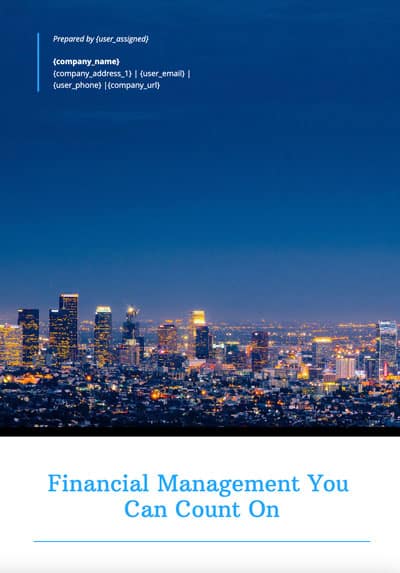
The flow and content of this proposal are strong, with one significant exception: the About Us section.
While the About Us and Team sections do add value, the client is most interested in the solution. If the solution is appropriate, then the people behind it are the next consideration. The first-page executive summary should be a convincing and specific overview for the reader. This section along with proposed service details, timelines, and budget is read in-depth. The About Us sections are simply skimmed.
Whether using software or your company’s template, present the client with the most important information first. Make it easy for the client to understand and see the value in your company's proposal.

This proposal clearly outlines the process and timeline for implementing the proposed services. The project is fully broken down so the client can understand all that they are getting for the price. Critique: There are no clear financials or pricing details, which is often what clients are looking for in a proposal.

The introduction or executive summary uses convincing language and bullet points to highlight the value. Highlighting your value well and early is an important part of a successful proposal, and this is a great example. Critique: It could be improved by shifting the language from general CRM best practices to how the company can specifically offer them based on this proposal. Again, the About Us section should come after the benefit-to-client details.
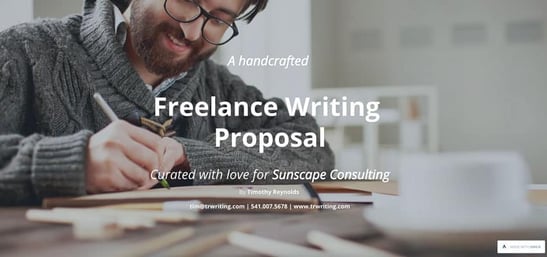
A sleek web-based proposal that includes specific offerings and clarification of the value. This proposal could be used not only by freelancers but any company that would benefit from a very visual proposal highlighting different services.
Critique: The Introductory letter and Executive Summary have strong, persuasive elements that refer to specific client needs. These two elements could be combined to strengthen the first section. Again, the About Me should be presented after the solution in every proposal.
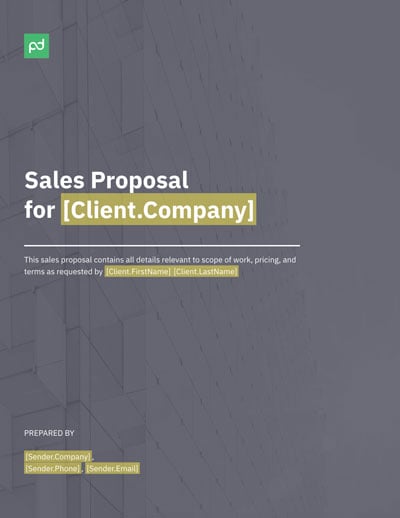
A brief proposal that covers a range of offerings. The nice overall use of white space allows the reader to skim and find the important information. It leaves a lot of room for additional information or sections if you need it. Critique: Remember what we said about About Us? (It's amazing how often companies talk about themselves first in a proposal. Break the habit!)
A visually compelling document suited for the industry. This is a great proposal for someone in interior design, organization, or a similar home-based service. Critique: Bumping up the Project Showcase section would improve proposal flow.
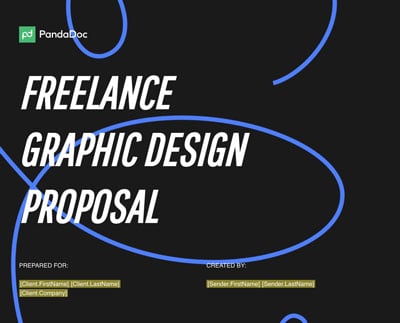
A thorough, understandable proposal that breaks down the process and pricing. The content highlights the company’s knowledge of client needs and its value proposition. This is another graphic proposal that could work well for other industries as well. Critique: The executive summary leaves much to be desired. Every sentence should be persuasive and specific, whereas this text is uninspiring and unclear.
For more information on writing proposals, read our blog, 8 Tools to Help You Create a Proposal.
Your proposal is your direct chance to win new business. Keep the client in mind in each step of proposal preparation. This strategy may mean revamping existing templates or starting fresh. Take the best parts of these examples, avoid the mistakes, and put your best foot forward to help your client.
R eady to level up your proposal writing? Check out our Business Proposal Writing Course.

Win more business with strong proposal writing skills.
Our Proposal Writing Course includes instructor feedback & coaching to review any proposal you write.
Related Articles
How to format a business proposal (with examples), 11 best proposal creation software tools, how long should a proposal be, get notified of new articles.

- Business Writing Skills (57)
- Business Grammar (52)
- Technical Writing (33)
- Business Writing Resources (26)
- Business Email Writing (17)
- Business Writing Training (12)
- Business Proposals (10)
- Business Report Writing (7)
- Business Proofreading (4)
- Sales Writing (3)
- Executive Summary Writing (2)
- Customer Support Writing (1)
- Bailey Lang (1)
- Elisabeth O'Quinn (14)
- Grace Cuddy (6)
- Haley Larsen (4)
- Kara Latz (10)
- Katie Almeida Spencer (31)
- Malcolm Stiefel (1)
- Mary Cullen (134)
- Samantha Taylor (6)
- Terrance Collins (1)
- Tom DuPuis (10)
How to Write an Successful Project Proposal
Learn how to create a compelling pitch for your next project and get it approved by the stakeholders.
Being able to successfully present your ideas is a vital skill for getting your projects approved.
Giving a convincing elevator pitch is often not enough – you need to create a formal, structured document that explains why your ideas are worth being executed and addresses the stakeholders' concerns before they had a chance to voice them.
Let's dive deeper into what a project proposal is and how to write it.
What is a project proposal?
Project proposal example, how to write a project proposal, project proposal template, tips for creating a persuasive project proposal.
A project proposal is a document that outlines your project’s core value proposition and sells it to the stakeholder. Simply put, it establishes what the project is, what you are aiming to achieve with it, how you plan to get there, and why it's a worthwhile endeavor. Writing it is the first step in the project management process .
A project proposal may include a list of activities or tasks that will be associated with the project, but it doesn't go into the same level of detail as a project plan .
There are many reasons why you might what to create a formal proposal for your project – to win a new client, to secure funding, to convince your manager to allocate resources to your initiative, and many more. In any case, a well-written, clear, and detailed document is usually the best way to approach it:
A project proposal helps you get a buy-in at your organization.
It creates clarity about the goals, priorities, and requirements of the project.
It forces the project initiator to think through the project details before pitching it.
After the project proposal is approved by all the stakeholders, it becomes the foundation of the project plan .
No two project proposals are alike, and depending on the nature of your project you may want to follow a different format. There are various types of project proposals:
Internal or external (intended to get buy-in from internal or external stakeholders)
Solicited or unsolicited (created in response to an official request for proposal or written ad-hoc)
Continuation (an update to an ongoing and already approved project)
Renewal (put forward to restart a terminated project)
Supplemental (used to request additional resources for an existing project)
The amount of detail in your project proposal can also vary significantly. In some cases, a simple and brief one-pager proposal would suffice, while in others, you would need to cover every point in great detail, creating an extensive document spanning many pages.
Here's what a project proposal example can look like in Nuclino :
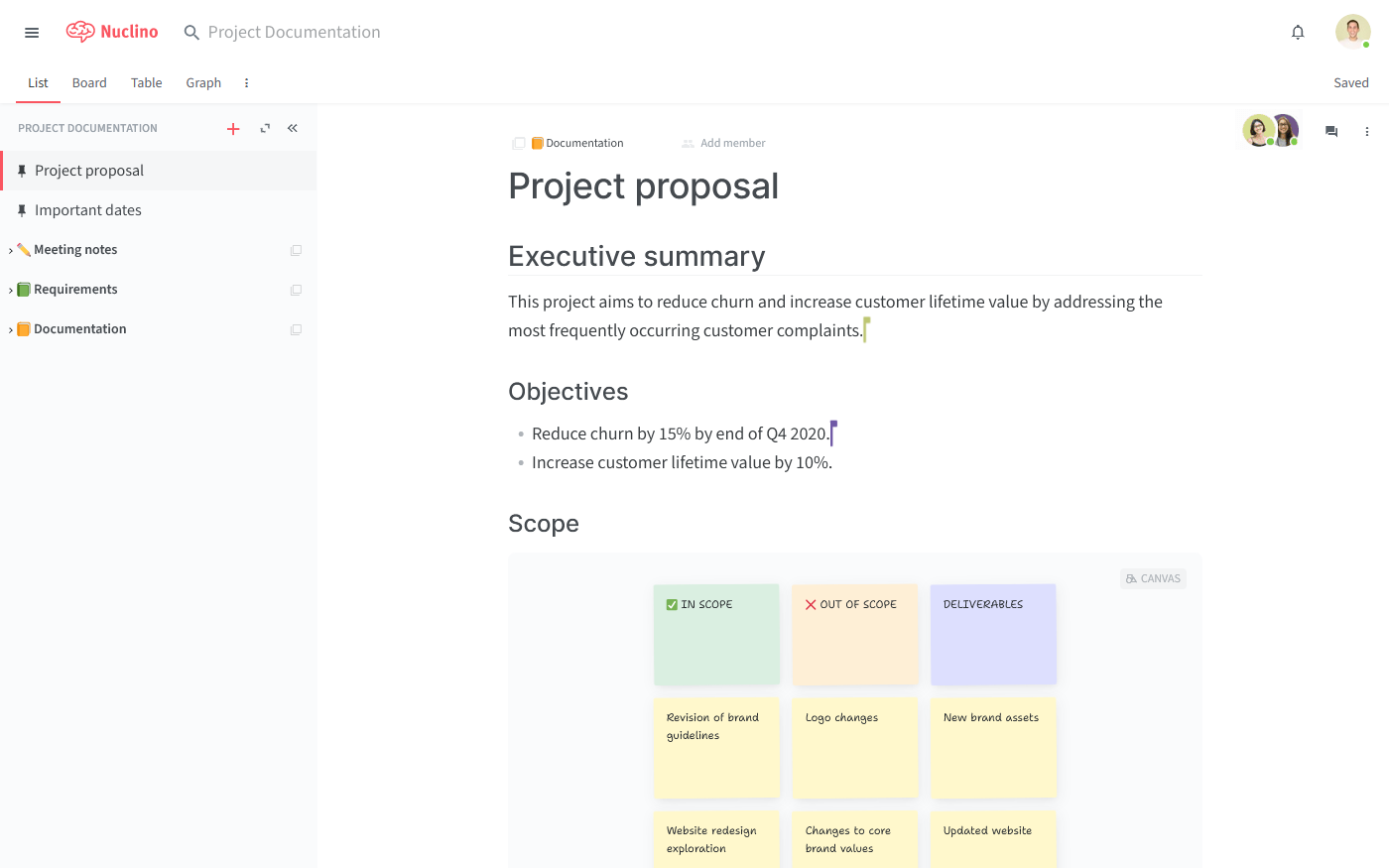
Nuclino is a unified workspace where you can not only manage your projects and collaborate on project documentation , but also build your internal knowledge base , onboard new employees , take meeting minutes , and more. It works like a collective brain, allowing you to bring all your team's work together in one place and collaborate without the chaos of files and folders, context switching, or silos.
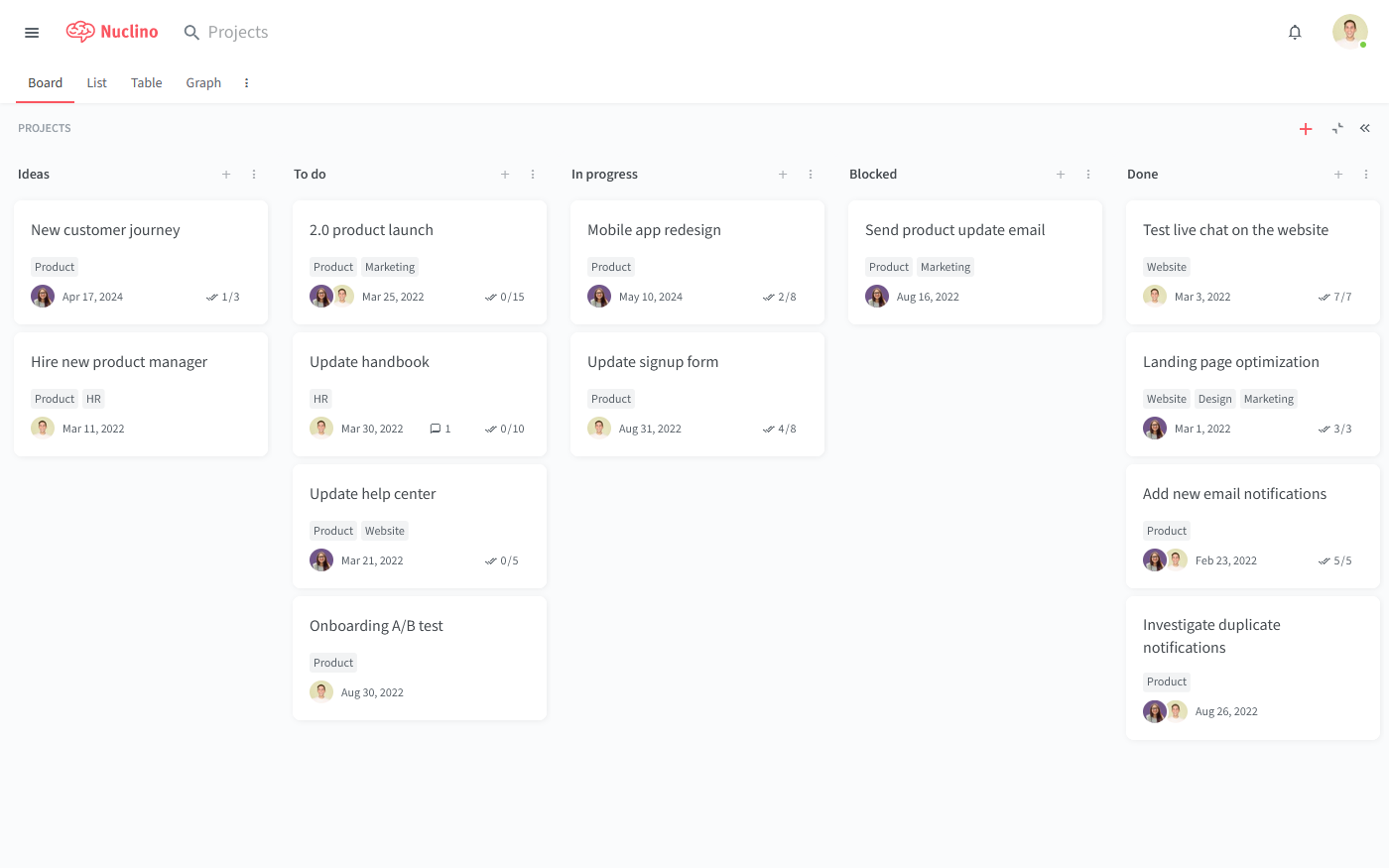
Nuclino also offers built-in visual collaboration and allows you to add an infinite collaborative canvas to any project document. You can use it to create diagrams and flowcharts, brainstorm ideas using sticky notes, build moodboards, and much more.
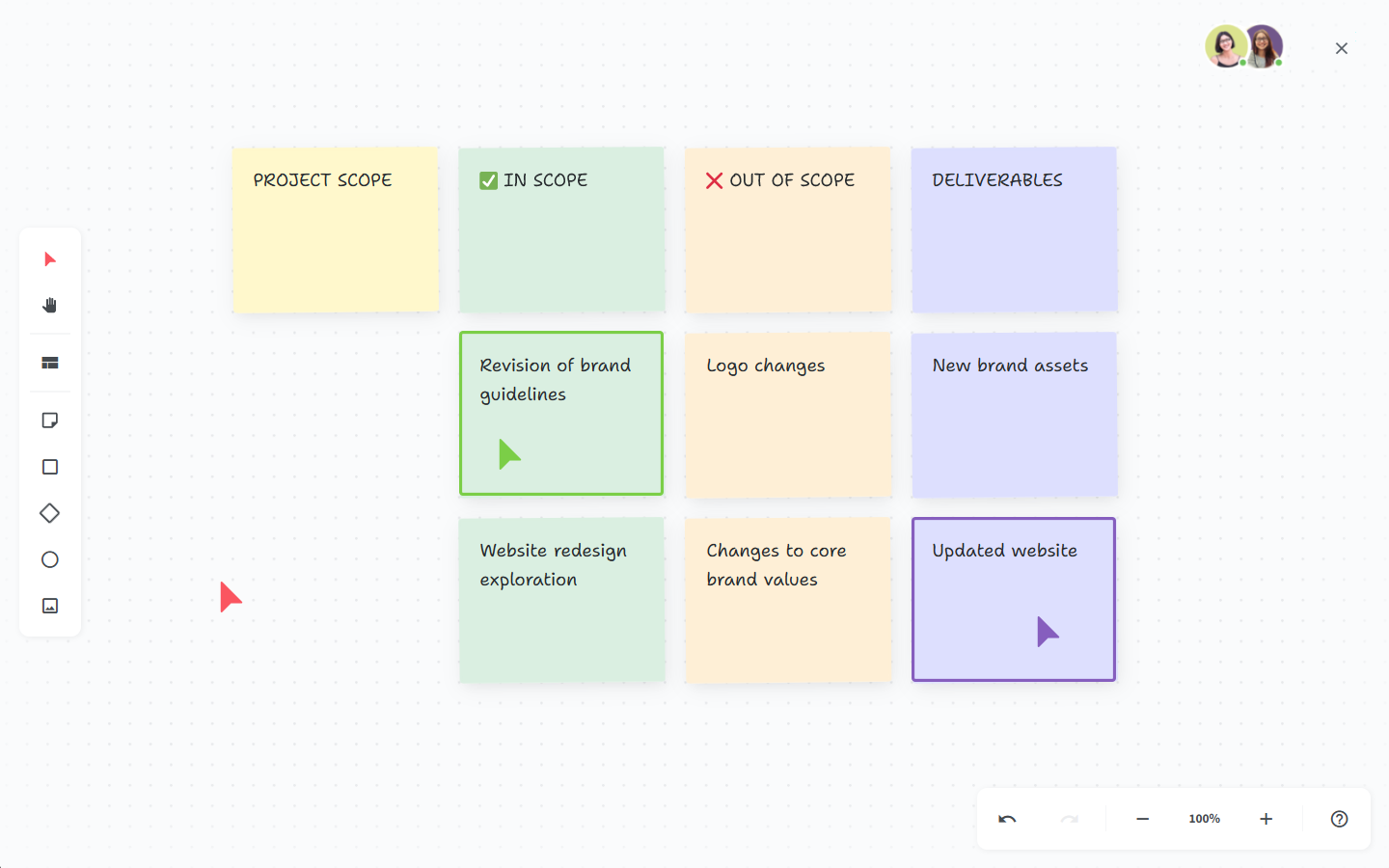
Include an executive summary
The executive summary is the first and most important part of your project proposal and should be written last. If it fails to capture the attention of your readers and make a compelling point, it may doom your proposal right then and there. Think of it as the elevator pitch for your project and focus on describing what success would look like.
Here are some guiding questions to help you get started:
What problem does your project aim to solve?
Why is it important to solve it?
How will it help solve it?
Include the project background
Include a section where you go into more detail about the problem you are solving. Prove to your readers why they should care about this project and back your claims with relevant references and statistics.
Consider providing answers to the following questions:
What is the history of the problem? How long has it existed?
How is solving it related to the business goals of your organization?
Explain your solution
After you have described the problem, it's time to lay out the proposed solution:
How will you solve the problem you described?
Why will the proposed solution be effective?
Why is the proposed solution better than alternatives?
What would it take to make it happen?
Define the deliverables and success criteria
Make it clear how the success of your proposed project will be measured:
What will be the project deliverables?
What are the SMART (specific, measurable, achievable, realistic, and time-bound) objectives of the project?
List the required resources
Be realistic and detailed when you estimate your project budget requirements. Include the supplies, tools, ad spend including cost per click , salaries , and whatever else would be required to successfully deliver the project.
A detailed financial breakdown will signal to the stakeholders that you've done your research and assure them that there wouldn't be many unexpected costs down the road. If you're working on a project for an external client, a good way to avoid any surprises would be to provide them with a formal cost estimate and get their approval.
You may want to conclude the document with a brief conclusion. Reiterate the points you made and remind your audience why they should approve your proposal, without introducing any new information.
As previously mentioned, there is no one-size-fits-all format. But this simple project proposal template can be a great starting point:
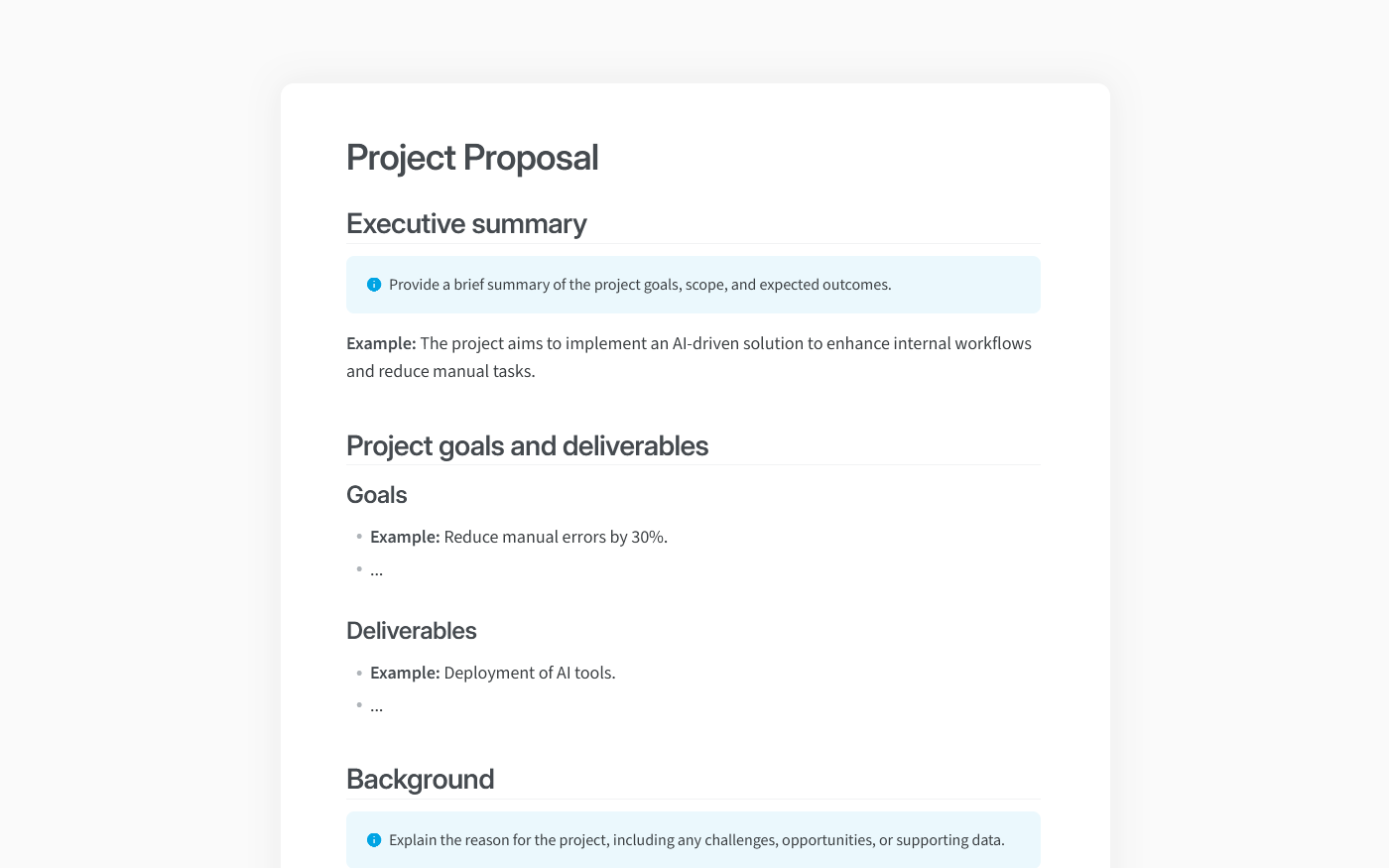
Using a good template does not guarantee the success of your project proposals. Following a clear structure is important, but that alone is not enough.
There are several noteworthy best practices that can help you make your proposal as compelling as possible.
Understand your audience and write for it
No matter how great and innovative your initiative is, it will fail to persuade your readers if you don't convey it in a way they would understand.
Try to answer the following questions as you write:
What is the background of your readers – specifically, the decision-makers? Would they understand specialized terminology or would it be better to use simpler language?
What would they find more convincing? Data? Visuals? User feedback?
What tone of voice is likely to resonate with them? Formal or informal?
Keep it brief and simple
There is probably a lot you can say about your project – you have likely been thinking about it a lot. But is all that information relevant to the point you are trying to make? Focus on what would strengthen your pitch and provide as much detail as needed, not as much as possible.
Make your solution SMART
Avoid vague goals such as "increase MRR" or "optimize a process". Make sure your proposal clearly defines the success criteria of your project and keeps it SMART (specific, measurable, achievable, realistic, and time-bound).
Anticipate questions and objections
Be prepared to defend your solution. Don't wait for the stakeholders to voice their objections – address them directly in your project proposal.
Writing formal project proposals may seem like a hassle, especially when you are confident in your idea. But not all great ideas get approved or funded – in many cases, whether your initiative sees the light of day depends on how effective and convincing your proposal is.
Nuclino : Your team's collective brain
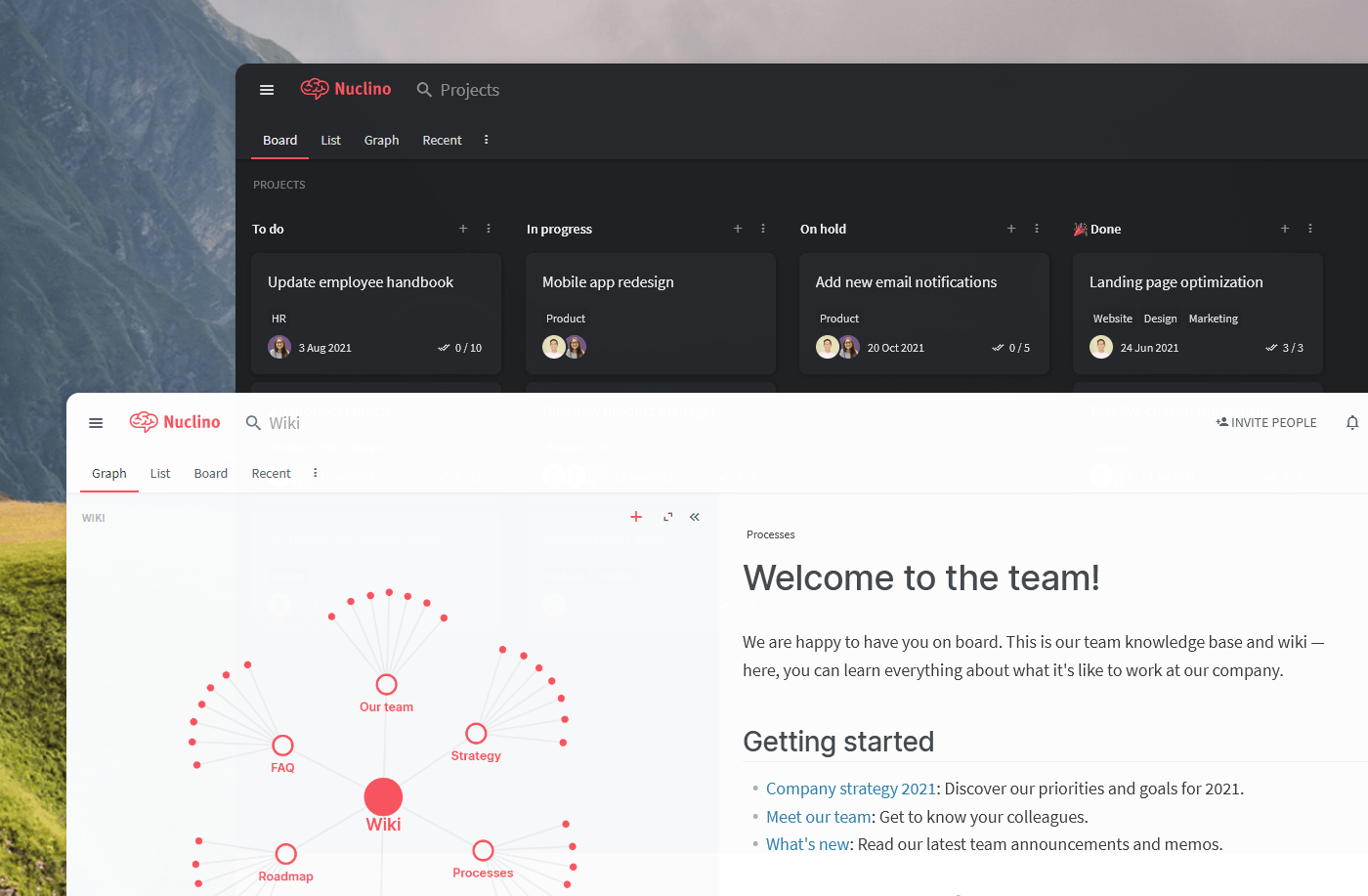
Nuclino brings all your team's knowledge, docs, and projects together in one place. It's a modern, simple, and blazingly fast way to collaborate, without the chaos of files and folders, context switching, or silos.
Create a central knowledge base and give your team a single source of truth.
Collaborate in real time or asynchronously and spend less time in meetings.
Manage and document your projects in one place without losing context.
Organize, sort, and filter all kinds of data with ease.
Integrate the tools you love , like Slack, Google Drive, Figma, Lucidchart, and more.
Ready to get started?
- Why Nuclino?
- Apps & Integrations
- Sidekick (AI)
❤ Learn how Nifty inspires productivity!
- Discussions
- Milestones (Gantt Chart)
- Docs & Files
- Time Tracking
- Project Home
- Project Portfolios
❤ Nifty is very flexible. Here are a few examples of how you can use it.
- Agile Development
- Client Management
- Digital Agencies
- Legal Case Management
- Marketing Teams
- Product Teams
- Integrations
- Help Center
- Got Clients?
- [siq_searchbox type="search-bar" placeholder="Search" post-types="post,page" width="150" placement="left"]
- Try for Free
- Log in arrow_right_alt
#ezw_tco-3 .ez-toc-widget-container ul.ez-toc-list li.active{ background-color: #ffffff; } Table of Contents
How to write a project proposal in 2023 (+ examples & templates).
Updated on April 26, 2024 by Jeffrey Kagan
Published on March 20, 2023 by Jeffrey Kagan
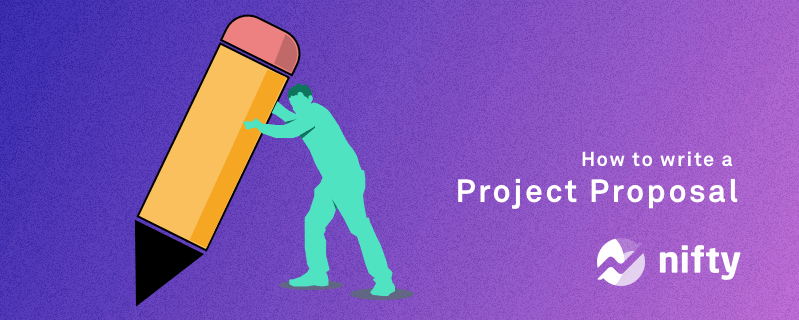
Coming up with a project and completing it successfully is hard work. This hard work does not happen overnight, either. It takes tons of careful planning and strategic implementation from ideation to completion. But it all starts with a project proposal .
Writing an effective project proposal can place any project in the fast lane toward success. But figuring out how to write a project proposal can be daunting. But it doesn’t have to be.
In this article, we’ll show you six types of project proposals, five key tips for writing one, and how to write a project proposal for project success. But let’s get the definition out of the way first.
What is a project proposal?
A project proposal is a document that describes a project, includes a timeline, budget, objectives, and goals, and answers every question that may arise concerning it.
The proposal outlines everything stakeholders need to know about the proposed project, including;
- Project goals or what the project aims to achieve
- Objectives or the problem(s) the project aims to solve
- Timeline within which the project will be implemented
- Budget of the resources to be used in project implementation
The project proposal gives the stakeholders a glimpse into what you intend to achieve through the project.
The goal of a project proposal can be to secure project funding, gain stakeholder buy-in, or build excitement and momentum for the project.
Here’s an example.
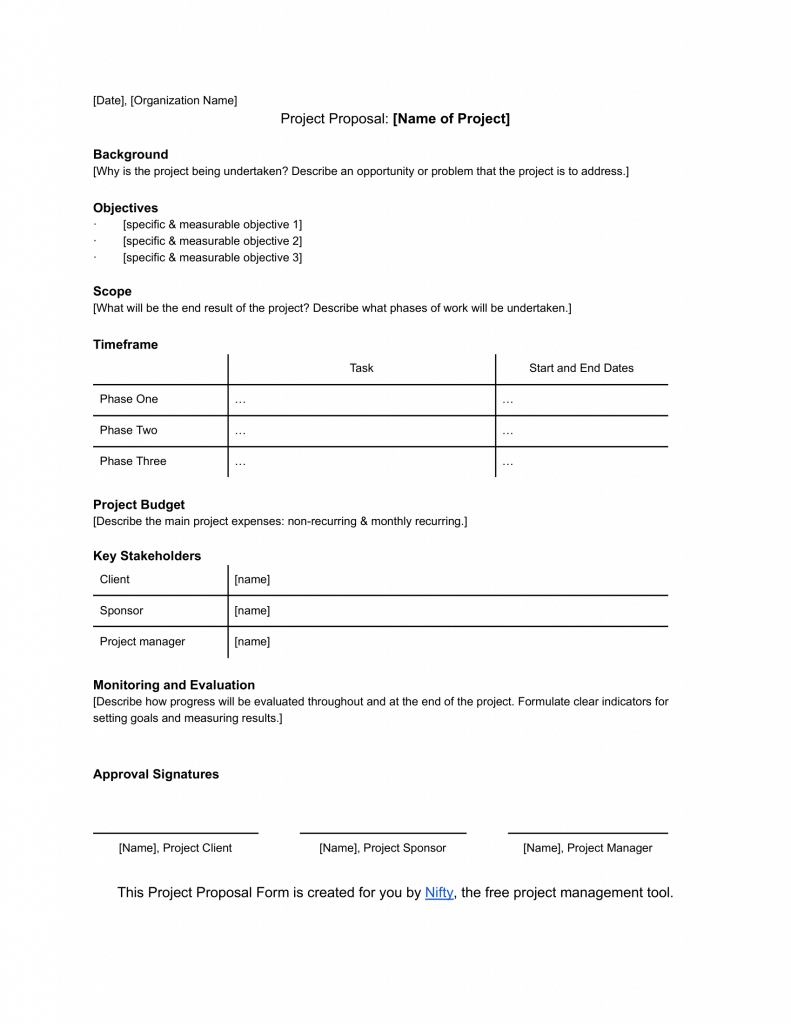
One of the best answers to “ how to write a project proposal ” is to write it clearly and confidently. That way, your confidence in the project will be transferred to the stakeholders.
If you’re not confident about your project, it will show in the proposal and compromise your desired outcome.
6 Types of project proposals
When creating a project proposal, you’ll come across six types of proposals. As a project manager, you need to understand each type.
1. Solicited
A solicited project proposal is written or prepared in response to a Request for Proposal (RFP) or a Request for Application (RFA). Sponsors and stakeholders use these requests to get proposals from businesses and other institutions.
A Request for Proposal is used to announce a project in detail for qualified teams to prepare proposals and bid for project funding.
Therefore, do in-depth research and write persuasively to win the bid. Keep in mind that you are competing against other companies for project funding.
2. Unsolicited
Unlike a solicited project proposal, an unsolicited proposal was not requested by the sponsors or stakeholders. It is defined as a proposal written to a government agency but not requested by the government.
It often proposes a public-private partnership submitted by a private company to enter an agreement with the government agency.
With unsolicited project proposals, you’re not under any competition with other companies. However, you must still be convincing enough to get the stakeholders you are pitching to interested in your project. It’s important to note that verifying the email of the stakeholders beforehand can also help ensure that your proposal reaches the right people and doesn’t end up in their spam folders.
3. Informal
This short document (only a few pages long) is formatted as a memo or a letter and gives general details concerning a project. It has fewer sections than a formal proposal.
These sections are the introduction, background, plan, project team structure , budget, and authorization.
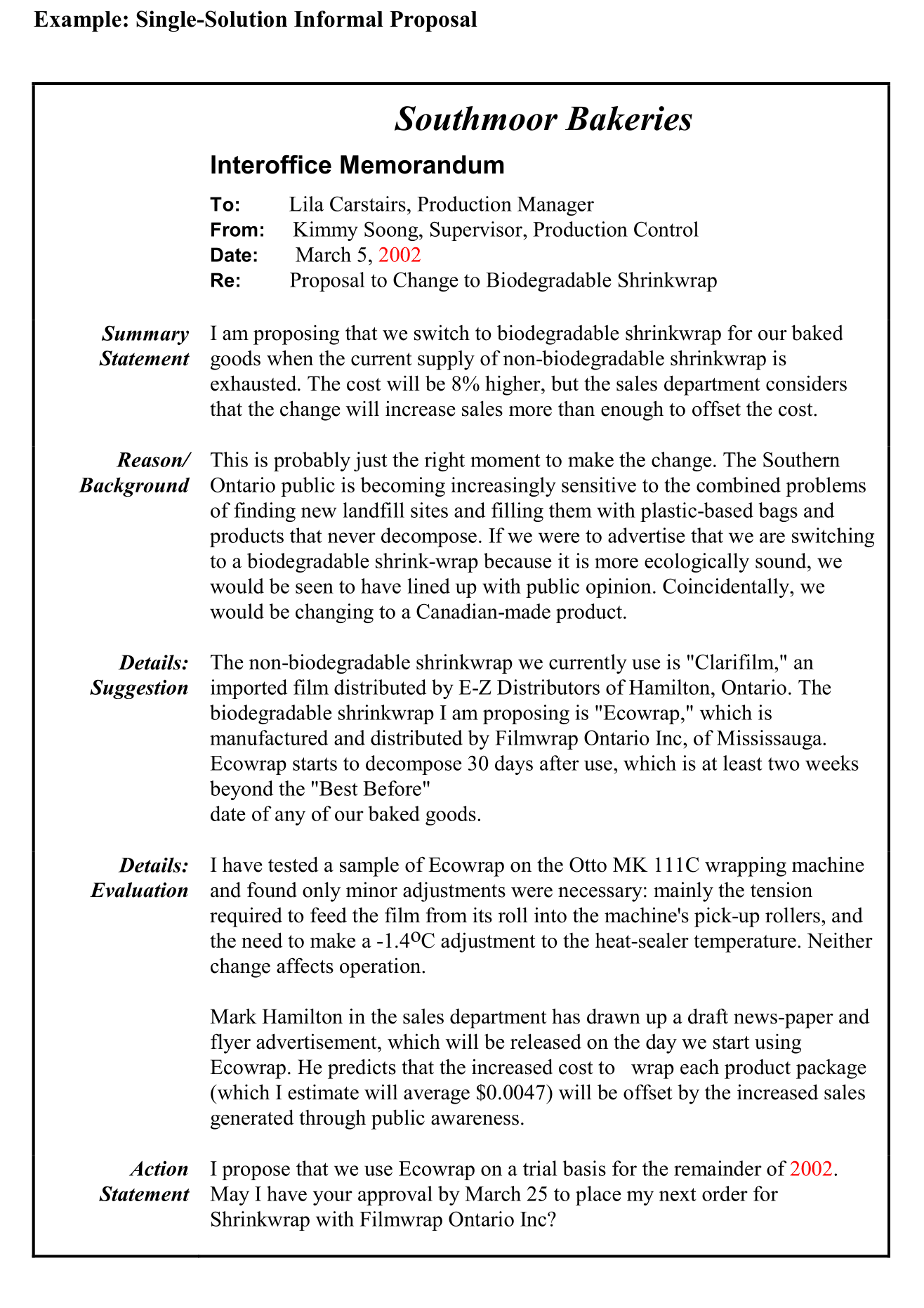
Your client can send you an informal request for a proposal. When this happens, you reply by preparing and sending them an informal project proposal. The rules are less strict when writing this kind of proposal.
Project managers need to learn how to write a renewal proposal. A renewal project proposal is written to the client after an ongoing project has contractually ended.
The proposal is prepared to request the client to renew the contract for a similar project. Here’s an example.
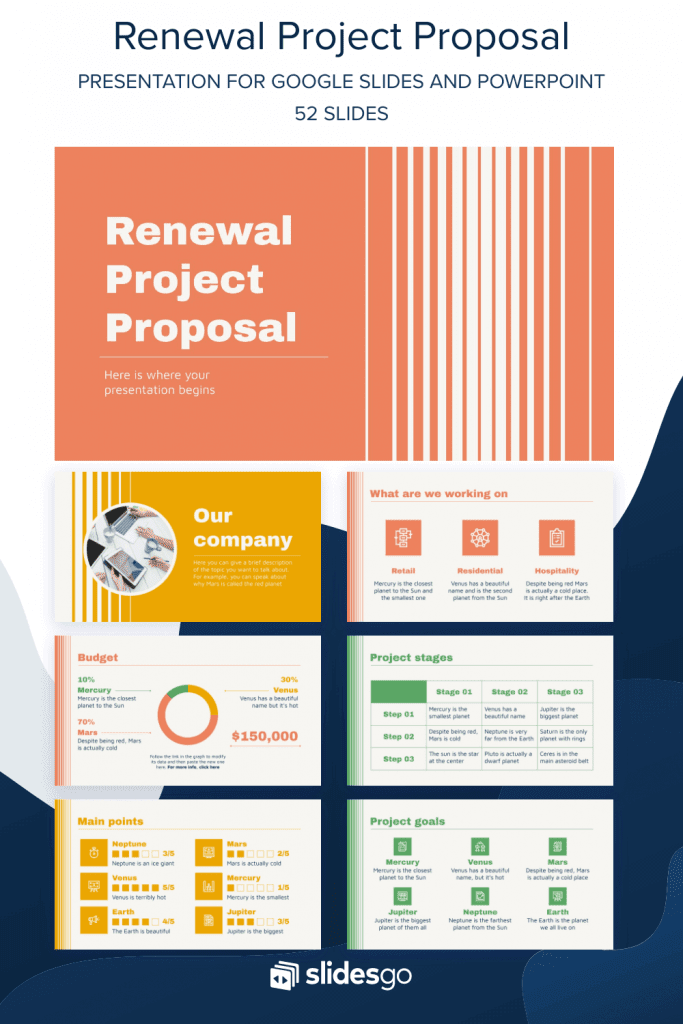
This proposal is written to clients or project sponsors with the hope that they will extend their engagement with your company.
For instance, let’s say you run a SaaS marketing agency. You can write a renewal proposal including why SaaS marketing is different from traditional strategiesto convince your clients to continue working with you.
Take time to emphasize your past results, milestones , and achievements that you’ve helped the client to achieve. This may persuade them that you’re the right fit for them to achieve even more success in the future.
5. Continuation
There’s no need to persuade or convince the stakeholders when writing a continuation proposal. It is simply a reminder to them that the project is kicking off.
This proposal is key to getting stakeholders to release the project funds they already approved. Here’s an example.
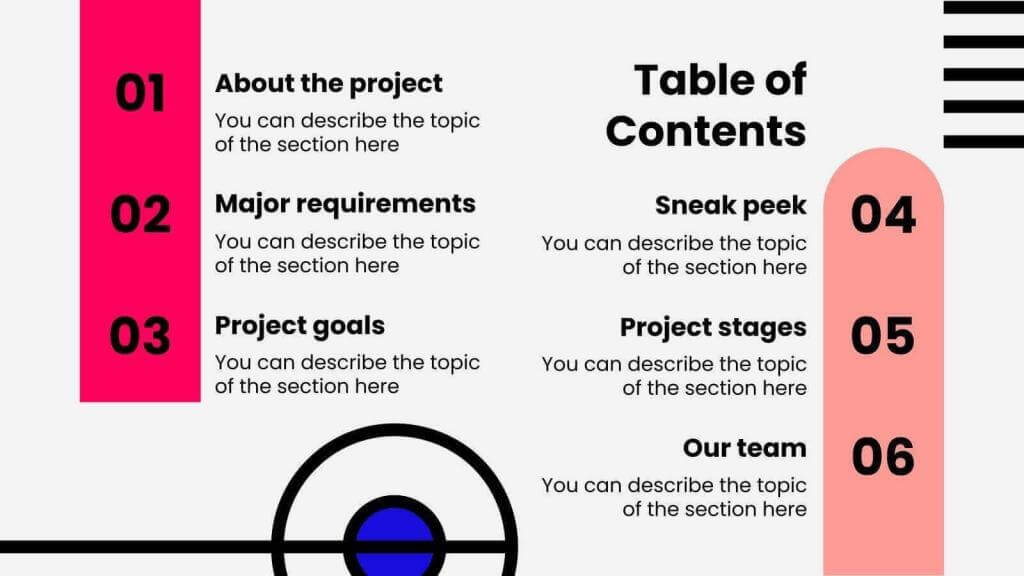
It can also act as a progress report and budget breakdown before they release additional funds for the project to continue.
However, keep in mind that continuation proposals can only be written for budget years that were already approved by the sponsors in the original award.
6. Supplemental
A supplemental project proposal is written to request increased support for a proposal already written, approved, and funded. The requested resource increase may result in the broadening of the project scope .
Additionally, a new budget must be written to include the supplementary resources included in this new arrangement.
Persuasion is vital when writing a supplementary proposal because you must convince the stakeholders of the importance of the additional resources you’ve requested.
5 Essential tips for writing a project proposal
A few important tips will guide you on how to write a project proposal effectively. Let’s look at the five top tips you should follow.
1. Know your audience
Your project proposal will have a positive impact on your stakeholders if you have a good understanding of who they are and what they’re looking for.
Get to know how familiar they are with the proposed project. This will guide you on how to communicate your idea to them.
It’ll also help you decide whether to provide supplemental information or materials to the stakeholders.
Remember to adjust the information and formalities you include in the proposal to suit each stakeholder and their preference. You may, therefore, need to write more than one version of the project proposal for each stakeholder.
2. Keep it simple
It’s advisable to use language that is easy to understand when writing a project proposal. Try and avoid jargon to ensure you don’t lose your audience in the process of trying to make an impression.
Remember also to use simple sentences and an easy-to-follow format to enhance the readability of your proposal further. Consider using a good content generator to help you with this. These content writing tools can help you detect complex sentences and words that can be simplified for your audience.
Additionally, keep the proposals short. Even if you’re the best writer in your region, you can only sustain your readers’ attention for so long. So know your limit and ensure your project proposal is not any longer than it needs to be.
3. Be persuasive
When talking about how to write a project proposal, persuasion is an invaluable asset to have. It helps you get the stakeholders to act favorably toward the project.
There are several persuasive tools that you can use to grab your sponsors’ attention. Use;
- Historical data from similar projects in the past
- Marketing predictions from trusted institutions
- Survey results from reputable sources
- Testimonials from previous studies
- Case studies from studies done in the past
Don’t be shy to highlight your past achievements and qualifications too. This will help instill confidence and trust in your readers, leading them to take action on your project proposal.
4. Do your research
Facts, graphs, figures, charts, and numbers are very important in helping you substantiate your project proposal. These also help prove that the project is a worthwhile investment for your sponsors.
So get your hands dirty and dig for all the information you can get about past projects. Look at both successful and unsuccessful projects alike. This data will serve as evidence and examples that you can follow to craft a convincing project proposal for your stakeholders and sponsors.
5. Use a template
You know what they say; when in doubt, use a template.
Okay, I made that up. But you get the point.
Templates help your company establish a consistent way of creating proposals while preventing anyone from missing any critical details. Here’s an example.
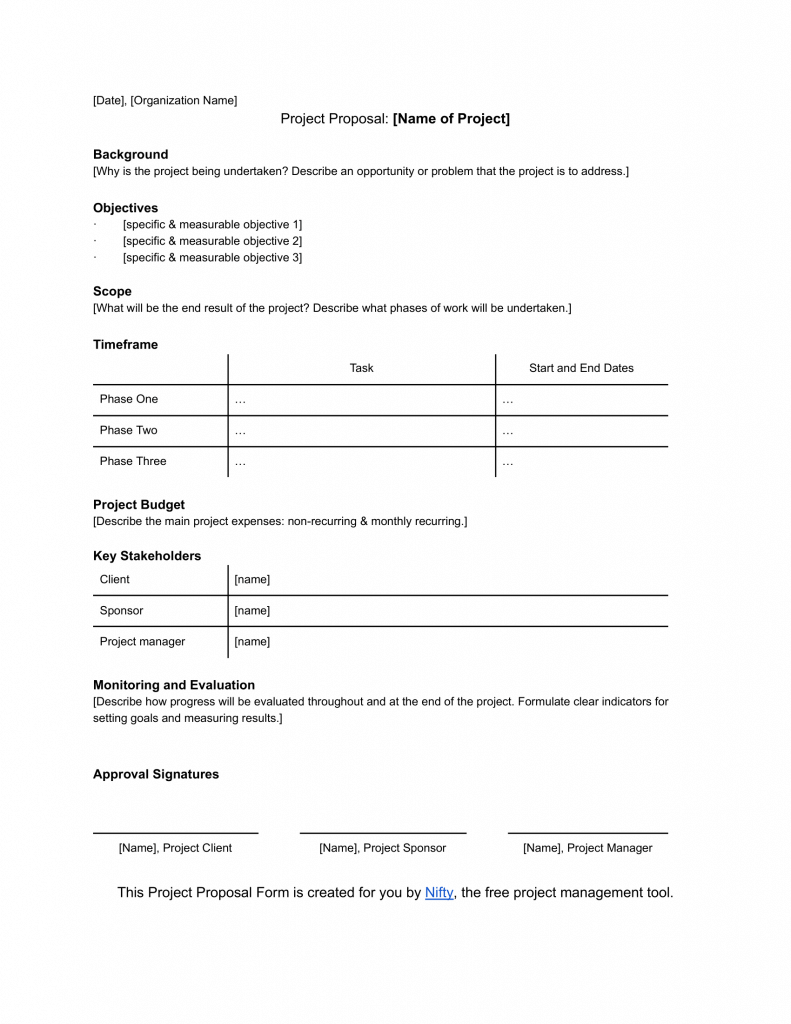
Templates also save time since anyone using them will know what details should be included and where each section should appear in the final draft.
6 Steps to writing a project proposal
Even though you need to customize each proposal for the intended audience and project in question, these six steps can act as guidelines to ensure you create a compelling project proposal.
1. Write the executive summary
Like an essay introduction or a report abstract, the executive summary briefly describes your project.
The executive summary is meant to give the reader an overview of the project and persuade them to keep reading until the end.
A great executive summary should include:
- The challenge or problem that your project seeks to solve
- The proposed solution to that problem
- The positive impact your project will have after solving the problem
- Who will benefit from the project outcome, and how
- The needed project resources, timeline, and budget
- How project success will be measured
The summary should be just a few paragraphs long. Remember, it’s not meant to be a detailed description of the project. You’ll get the chance to discuss the project in-depth later on in the proposal.
2. Explain the project background
When considering how to write a project proposal, a background check is an essential element to capture.
Here, make sure to write about the specific problem your project is looking to address and what is already known about it.
Include who has addressed the problem before, their research findings, and why this data is insufficient.
Here’s an example of a project background.
This is where you use your research data and statistics to bolster your project proposal. These numbers go a long way in convincing readers that your project and the problem you’re addressing are worthwhile undertakings.
In the end, let this section be about a page long (or less).
3. Introduce a solution
Since you’ve presented a problem in the project background section, it’s only logical that you present a solution in the next section.

This section provides an opportunity to reveal your project approach in more detail.
In this section, include;
- Your vision and mission statements
- Project scheduling and key milestones
- Project responsibilities and roles
- Project deliverables
- A risk register detailing how you’ll mitigate the risks
- The reporting tools to be used till the end of the project
This might turn out to be the longest section of your proposal. That’s because you need to explain everything involved in achieving your proposed solution in detail.
It’s also worth noting that you may not need all the items stated above in your solution statement. So depending on your project scope, you can choose what to include and what to leave out.
4. Define the project deliverables
Every stakeholder wants to know what the results of the project will be. Use this section to show them what their resources will ultimately achieve.
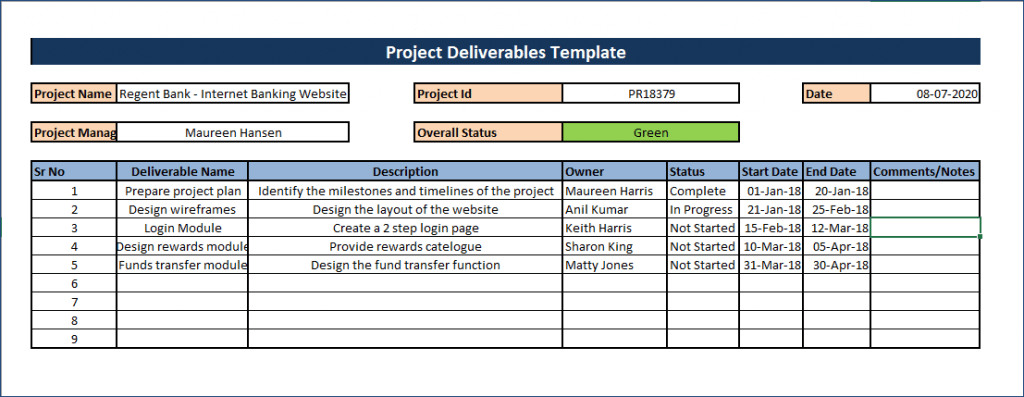
Project deliverables should include the final product or projected outcome, SMART goals that align with your deliverables, and a project timeline.
As important as the problem and solution statements are, stakeholders visualize the project more easily when the deliverables are clearly defined.
5. List what resources are required
By this point, every project manager hopes they’ve convinced the stakeholders that the project is worthwhile and needs to be implemented immediately. So the next natural step is to list what resources you need to undertake the project.
For example, this software development project proposal presents a breakdown of the costs required for the project.
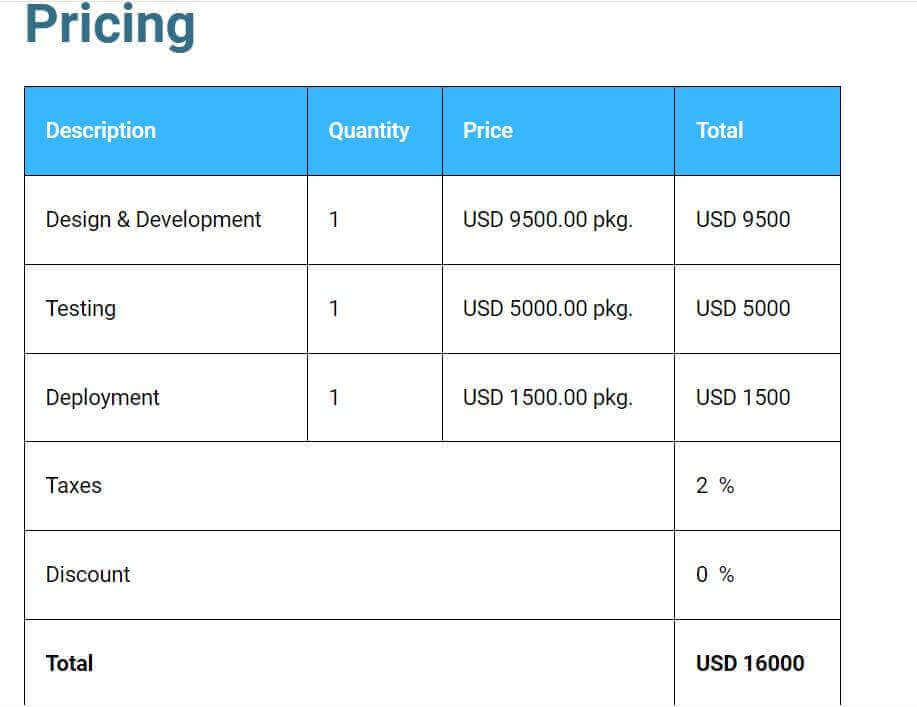
One of the key points on how to write a project proposal is to be clear about the resources you’ll need to deliver the desired products. So be sure to include:
- A detailed project budget
- A breakdown of the costs
- A resource allocation plan
It’s recommended that you save this section for the end of the project proposal to avoid bombarding and overwhelming your sponsors with requests too early.
Give your idea time to float and convince them of the project’s value before stating the costs.
6. Include a conclusion
The concluding section should give an overview of all the points discussed within the proposal . Make sure to write a persuasive and confident conclusion because this is your final chance to convince your reader to invest in the project.
Here’s a nice example.
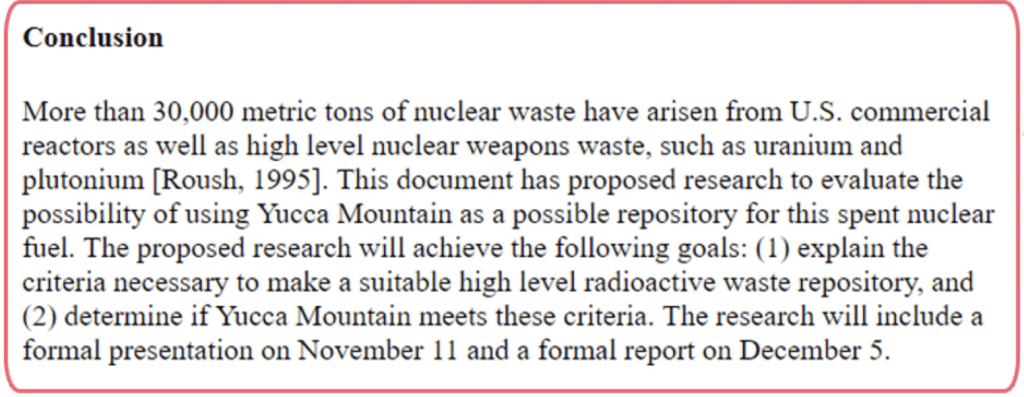
You can restate the problem your project seeks to solve, the proposed solution, and the impact the solution will have in the end. Just like a traditional essay, keep it relevant to the proposal.
If you are pitching or proposing the project to someone via email, we recommend going for plain text formatted email rather than spending time and designing email templates from scratch.
3 Examples of project proposal templates
Now that you know how to write a project proposal, let’s look into three templates you can use for your next proposal.
Business proposal template from Nifty
A business proposal is a written document aimed at helping a business gain clients and partners. This is done by describing the products and services offered, the potential outcomes of using the services, and the costs associated with them.
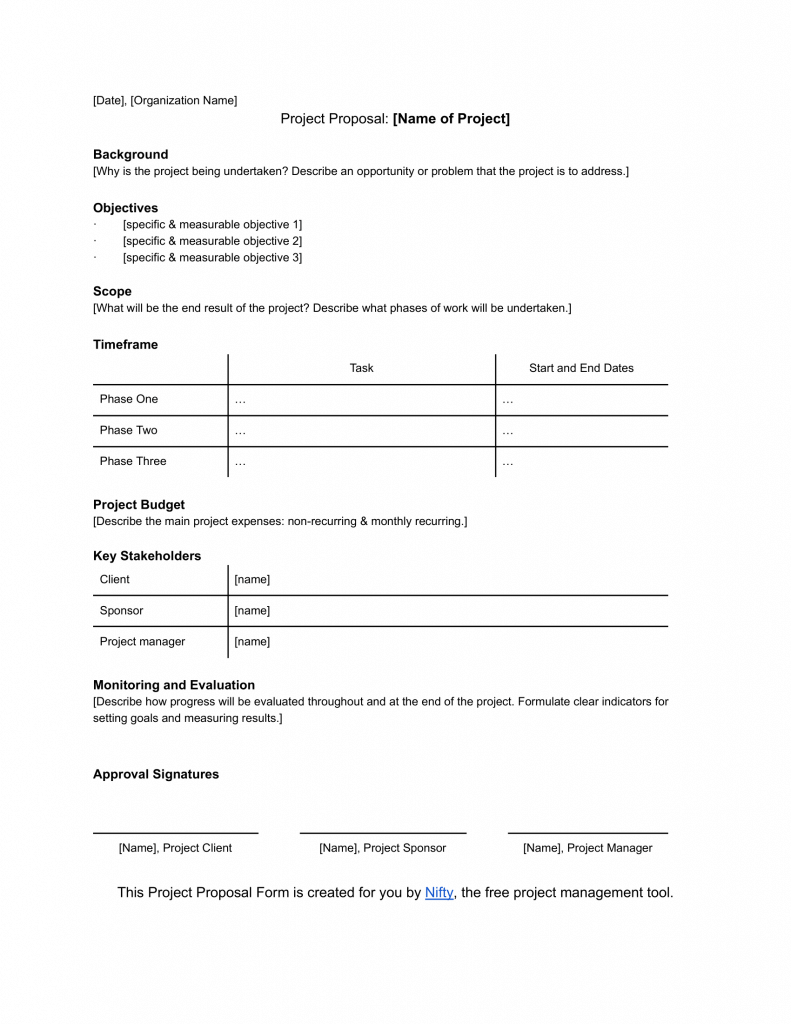
A business proposal template will help guide you into writing an effective proposal that is likely to win the approval of the intended sponsor.
Financial proposal template
A financial proposal is prepared to help organizations and businesses get funding from investors. It can also be used to suggest some changes in the budget and how much time is needed for the changes to be made.
Here’s a great example.
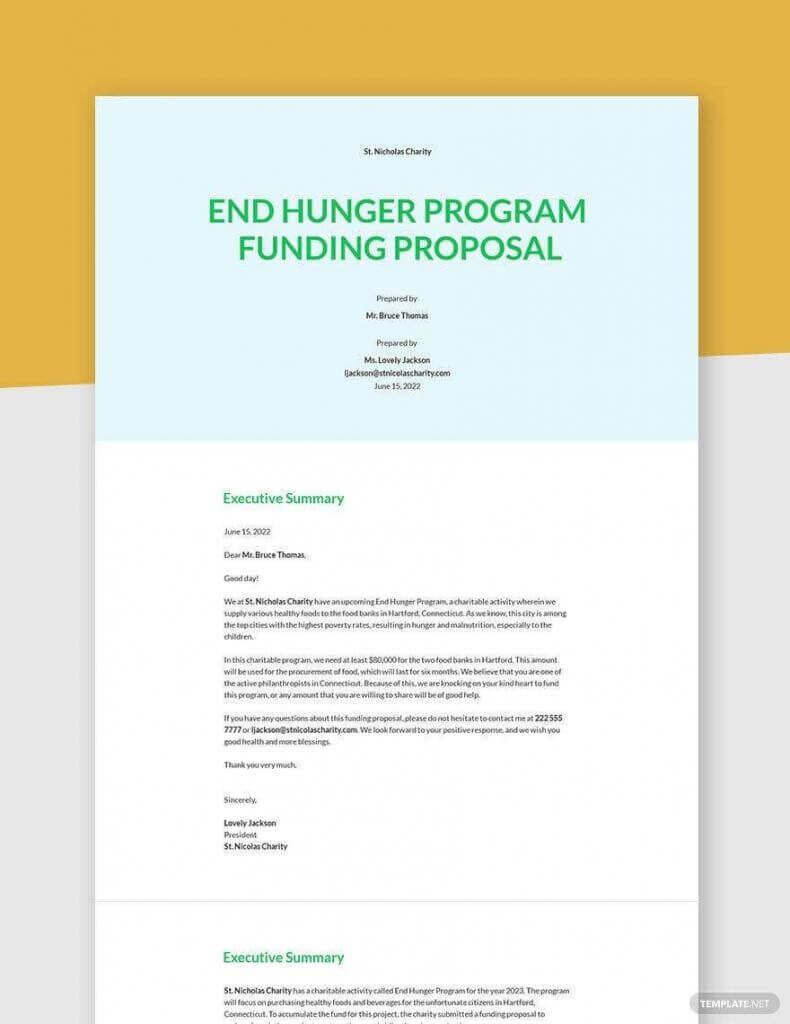
When using a financial proposal template, be sure to detail all the resources needed, why you need each resource, and how they will be used to achieve the desired outcome.
Since most of the financial proposals are to be sent in person, you can try experimenting with multiple formats like a Half-Fold template, trifold brochure template , or Gate-Fold, as these templates make reading the proposal a bit easy.
Nonprofit project proposal template
A nonprofit project proposal acts as a pitch letter that shows grantors the benefits of funding a nonprofit organization for a specified project. These grant proposals can be used to ask for funding from within the organization or from grantors outside the organization.
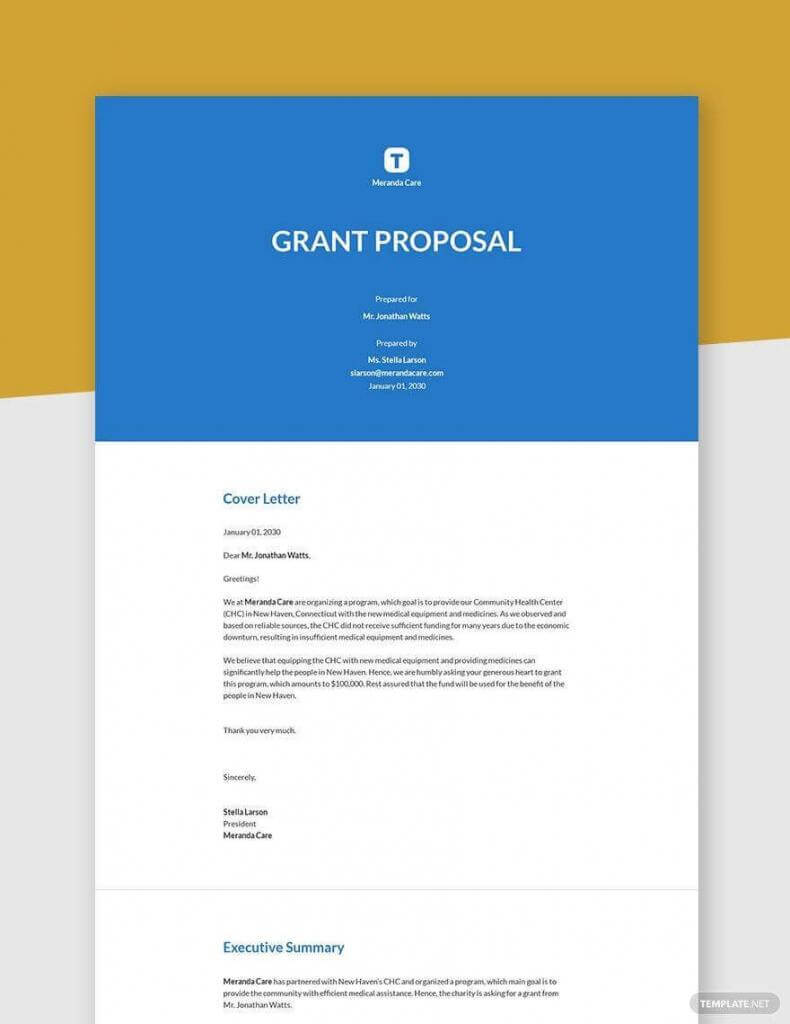
These kinds of proposals can be very detailed. Therefore, a nonprofit project proposal template (like the one shown above) can come in handy in ensuring you don’t miss any crucial details.
In this article, we have shown you how to write a project proposal effectively. You have learned about the six types of project proposals and the five essential tips to apply when writing a project proposal.
More importantly, you saw the six steps to writing a successful proposal. You can also use the three examples of project proposal templates for guidance.
You’re now equipped to write a winning proposal for all your subsequent projects. Remember to do lots of research into your chosen topic and add data and numbers to your proposal. This will further convince your sponsors and stakeholders to invest in the project. All the best!
Use Nifty to ease up the process. Sign up , it’s free forever!
Recent Articles:
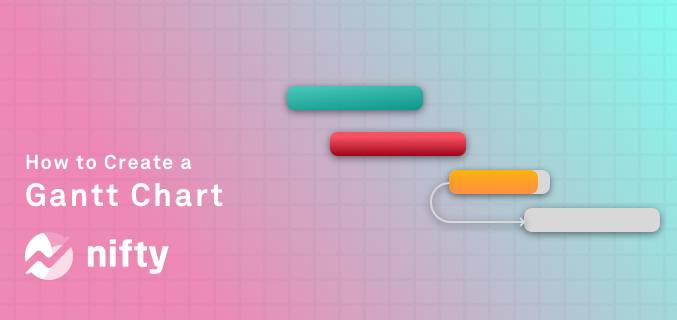
Alternatives
Wait before you go, do you really want to lose 5 productive hours a week, teams waste 5 hours a week on average juggling between tools. nifty is one app for chat, tasks, docs, and more. try it for free and see for yourself. we promise you’ll love it..
How To Write A Proposal: Data-backed Best Practices For 2022
Business proposals are sometimes perceived as a necessary evil in sales. Whether you're writing a proposal for a huge new contract or simply pitching to a potential lead, writing sales proposals can be daunting.
After all: with how hard you've worked to get the potential customer to this part of the process, a lot rides on your ability to get them to cross the finish line.
What if we told you that writing a smart, data informed business proposal could be the highlight of your sales process that also helps you to close more deals and increase revenue?

12 min. read
The purpose of this guide is to provide a clear set of rules when it comes to how to draft, format, and implement a successful, stress-free sales proposal.
We'll take a deep-dive into the elements that need to be included, why these elements are essential for success, and how to effectively structure your proposal so that it's easy for your customers to understand their problem, your proposed solution, and make them eager to start doing business with you.
What is a business proposal?
A business proposal is an offer from a seller to a prospective customer. It's a document that outlines the scope of work, costs and deliverables for a project. Unlike estimates and invoices, business proposals are written before any work has started and are used to win new clients. Business proposals can vary; however, there's one thing in common: their purpose is to convince potential customers to buy your products or services.

They can be grouped into two categories:
Solicited proposals:
This is also known as an RFP (Request for Proposal). It's sent in response to a request from an existing customer or when contacting a company you already know. This type of proposal is based on the specifications provided by the client and must include all the information they have requested.
Unsolicited proposals:
Unsolicited proposals are sent to companies you don't have an established relationship with. This type of proposal is more like a sales pitch as you don't have any specifications to follow. In this case, you need to include as much information about your products or services as possible in order for your potential client to assess whether you're the right fit for them.
Why putting time and effort into your business proposal will pay off
If you've just landed a new prospect, you're likely both excited about the opportunity and wanting to move forward.
A well-crafted business proposal is a step toward landing the deal. A poorly crafted one, on the other hand, might give them reason to take their business elsewhere.
The hardest part of writing a business proposal is making a compelling argument for your work.
You need to show that:
- you clearly understand the client's needs
- you have the right skills and experience to undertake the project
- your ideas are original and fresh
- you have the willpower and determination to follow through on your promises
- you have personality! (Nobody’s here for the boring business stuff)
With the world's information always quick search away, clients want to know why you're the absolute best solution to their problems, and that you're going to be worth investing in.
To ensure that you're always sending out top-quality proposals that will win over clients, use these data-backed best practices for writing business proposals in 2022.
Best Practices: What Should a Project Proposal Include?
A proposal’s structure and flow is like that of a story: it has a beginning, a middle and an end. Just like a good narrative, it is organized and tells a convincing story designed to captivate clients.
Most proposals follow similar patterns, but every proposal will be different depending on the company, industry, deal size, and the product or service in question.
The following sections detail the sections typically found in business proposals as well as explain how to include them.
1. Cover Page
It's hard to judge a book by its cover, but you can guess how well it will sell. A sales proposal cover page that is clean and informative, including the client’s name, your name and contact info, and the date submitted, is key to gaining and keeping a client’s attention. Consider including a table of contents to make it easy for the client to jump to the area they need to review.
2. Executive Summary
The executive summary isn't a brief rehashing of the whole proposal, it is a highlight of the most important elements of your business proposal. The goal is to show the client that you understand their background information, business plan and unique challenges--and that you are just the one to solve them. Pique their interest and give them a reason to continue reading.
For inspiration writing your executive summary, take a look at these three executive summary examples you can steal.
3. Approach/Solution
How do you solve your prospects’ problems better than your competitors? How can your company solve customers’ pain in ways that are unique and compelling to your reader? The key to successful proposal writing is to outline the ways in which you provide solutions and make yourself a winning choice.
4. About Us/Our Team
Introduce your leadership team, company founders, and team members who will be working with your new clients on their project. Better yet, show how the members of your team have had success handling similar situations in the past.
The goal of this section is to give your client confidence that they will be working with a competent, professional team and minimize any doubts they might have about hiring you. You can also include a custom logo or digital business card, created through Tailor Brands , to enhance your proposal's professional appearance.
Pro Tip: in marketing, it's well known that including real, human photos increases trust with a customer and as a result, higher conversion rates. Apply this insight to your about us/our team section to create a memorable impression with your reader.

5. Deliverables
The deliverables section of a business proposal is probably the most important section because it outlines exactly what will be delivered for the client.
It’s important to always include this section in your business proposals, as it gives the prospect a clear picture of what you are going to do and how you are going to do it.
The deliverables section should outline details like:
- The scope of the project includes recommendations based on research and analysis.
- What you will provide (content, design, strategy, etc.)
- How you will provide it (online, onsite, etc.)
- When you will provide it (timeline)
- Who will be responsible for what tasks and when they will be performed.
Aim to keep your pricing section succinct and straightforward. Explain how much their total investment is going to cost. List and describe all the project fees, taxes, discounts, and optional extras. If your client has any confusion or concern about hidden extra fees, they'll be more likely to trust you less — leading to a higher chance of rejection.
Highlight any additional costs that may arise during the project lifecycle. Clients tend to be sensitive about extra costs that weren't mentioned in the proposal. The more transparent you are with them, the more likely it is they will trust you and be willing to pay those additional costs if they crop up later on in the project. Make sure this is crystal clear in your business proposal price section so there's no confusion about what's included and what's not included in your pricing
Pro Tip : Instead of referring to your prices as fees or charges, label your pricing section Your Investment. This will remind people they’re making an investment in their own development and that of their team and organization.
7. Terms and Conditions/Sign Off
If you've gotten this far, you're on the home stretch. The closing of a business proposal should be the easiest part of creating it. You already did the hard work in the beginning and throughout, so it's time to wind down and push things over the finish line.
A clean, well-designed page is a great way to close out your proposal with confidence. Just make sure that you include all the necessary information: a place for your new client to esign, clear, up-to-date terms and conditions, and any other last-minute details they may need to review before making your partnership official.
8. Bonus: Case Studies
A case study is an in-depth look at a single example of a success story. It’s typically used to demonstrate how your offering has helped a customer overcome a key challenge they’ve been facing, and how it’s delivered tangible results as a result.
Case studies and testimonials are particularly useful in the closing stages of the deal cycle, when buyers are trying to determine whether or not a proposed solution is right for them. Social proof from a client who’s experienced success with your solution can go a long way in helping get your buyer over the line.
How Should A Business Proposal Look?
Given the high stakes of winning new business, you can’t afford to have a bad looking proposal. You’ve got to make it look good and fast.
Too many people focus on the content and forget about the design. The truth is both are equally important to the success of your proposal.
If you're not designing, you're losing out.
A well-designed proposal with engaging, high-quality images, graphics and video stands out from the competition and quickly communicates value to decision makers. Business proposals that stand out close deals.
Proposals with images close at a higher rate
In Proposify's annual State of Proposals report , we analyzed the data from the 1+ million business proposals sent through our software in 2021.
When it comes to images, the message is clear. Proposals that include images perform significantly better than those without. In fact, project proposals that contained images were 72% more likely to close, and they did so at a 20% faster rate.
If you’re looking for a way to make your proposals shine, adding images can be a real game-changer. They can help catch the attention of your prospect, while also allowing your company to show off its expertise and communicate ideas more effectively.
But which images should you include? Here are some suggestions:
Headshots of your team members:
If you’re offering services, it helps to let the prospect know who they’ll be working with. It also helps build trust — if they know who you are and can put faces to names, they’ll feel like they have an established relationship with you by the time they open the proposal.
Product shots to show off what you sell:
If you’re offering a specific product or service, including photos gives the prospect a better idea of what it entails. Product shots are particularly useful if you’re selling through an online marketplace such as Amazon or Etsy, because customers will already be used to seeing them there.
Images that illustrate your services in action:
For example, if you were pitching for a window cleaning job, showing images of past projects would serve as case studies that would help show off your skills and convince the prospect that you could create something similar for them.

Adding video to proposals increases close rates
Rather than just talking about how a proposal was constructed, proposal videos can show the reasoning behind their pricing. This makes the close much more effective, and greatly helps to close deals.
(Need help with video? Check out Vidyard .)
When your client shares your proposal internally, video makes it easy to have conversations where your voice is always present. Your client will love you because you’re explaining the deal yourself. Decision makers and buying committees will love you because you can demonstrate how you’ll solve their problem in 5 minutes, asynchronously, instead of 30 minutes over a scheduled call.

From Proposify's annual State of Proposals report :
"Video is quickly becoming a critical part of the closing process. In 2021, there was a 40.5% year-over-year increase in the use of proposal video. This is up from a 31% YOY increase in 2020. Despite this increase, however, only 21% of all proposals contain video."
As companies search for creative ways to engage potential buyers, you can capitalize on this strategy now to help your deals stand out.
For inspiration, check out these examples on winning proposal design .
Sales Proposal Follow-Up
The best way to follow up with leads is to use data, not guesswork.
Professional persistence is an important element of good salesmanship—and when done right it can go a long way. A cautious approach and a smart strategy, not to mention personal reliability, will pay off.
How you follow up after sending a proposal is just as important as the proposal itself, and the timing of your follow-up can be the deciding factor in getting a deal closed, so it's important to know when is best to reach out.
You’re more likely to succeed when you reach out with important information based on your prospect’s behavior. For example, if you know that prospects open a proposal an average of five times before they make a decision, build high-importance tasks into your process for reps to follow up on the proposal as soon as it has been opened for a fifth time.

To effectively use your follow-up process, you need to know the baseline metrics of your team. Once you know these numbers, you can identify patterns that indicate a deal may be in trouble and act before you miss your opportunity.
Ready to get started but need some inspiration?
Proposify's free Proposal Templates include everything you need to dominate your brand pitches and win more clients. Included are dozens of business proposal templates for businesses ranging from accounting firms, creative agencies, and architecture firms all the way to individual construction job proposal templates. If there’s a business that does it, there’s likely a template waiting for you inside.

A winning business proposal has a greater chance of success and can be the difference between getting that client, making that sale, or missing out on that opportunity. To get your proposal noticed in a sea of competitors, you need to work at creating a document that is easy and enjoyable to read.
Our best tip? Keep it short and concise, but don’t hesitate to include details in the most relevant sections.
Long story, short: create the proposal that you would be thrilled to get.

How to Structure a Proposal
May 18, 2021

How To Write an Executive Summary
May 20, 2021

It’s about more than just proposals—it’s about world domination.
Get a demo and start your team's total takeover.
Sandeep Kashyap
How to write a perfect project proposal in 2024?
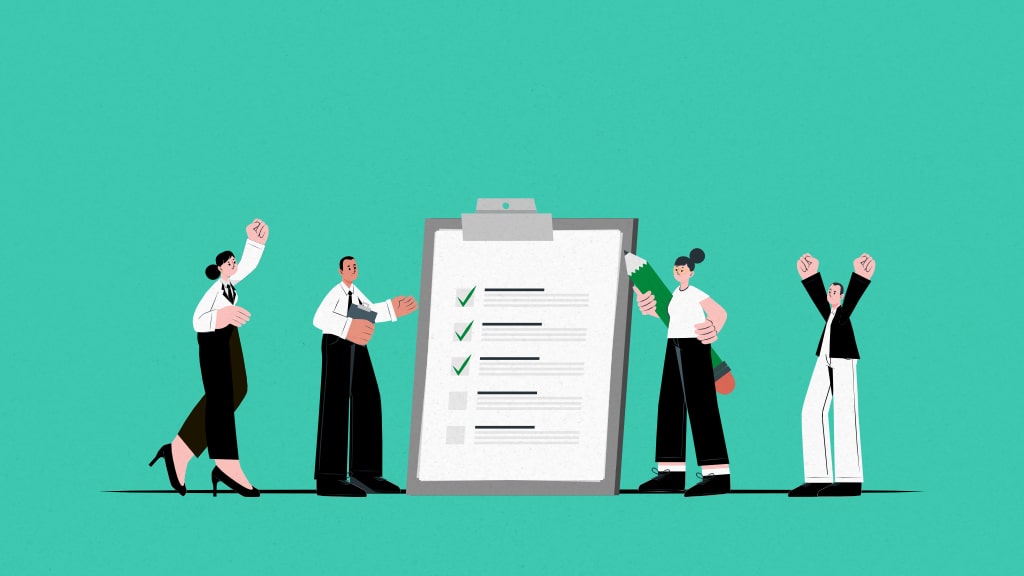
Introduction
The primary purpose of writing a project proposal is to secure funding, gain approval, or secure resources from the most important stakeholders of a project.
For that, you need to explain the following in simple terms in a project proposal:
- What do you want to do and what are your goals for the project?
- How are you going to achieve your goals?
- How are stakeholders going to benefit from the project?
- What do you want from stakeholders?
- How are you going to use the money and resources granted by stakeholders?
In this post, we will learn about all these about writing a perfect project proposal in 2024. We will look at different types of project proposals, a project proposal template, and a real-world example of a project proposal.
What is a project proposal?
A project proposal is a project management document that outlines a project’s objectives, timeline, budget, goals, and requirements.
It is primarily written for stakeholders to secure funding, gain approval, and secure resources. However, other types of project proposals are also sent to win projects from clients.
A project manager should have a good understanding of the project and its key stakeholders for writing an effective project proposal. It is because a manager needs to get into the heads of the project’s stakeholders to understand what they expect from a project and write an effective project proposal accordingly to ensure buy-in for the project.
Benefits of writing a strong project proposal
Writing a strong project proposal offers a surprising number of benefits beyond simply securing funding or approval. Here are five key benefits of writing an effective project proposal:
- Clearly defines the project to increase the chances of success
- Makes it easy for stakeholders to mutually understand the project
- Ensures everyone involved is on the same page about goals, roles, and expectations
- Helps identify potential roadblocks early for proactive planning of solutions
- It can attract funding, and talent, and even serve as a marketing tool
Difference between a project proposal, a project charter, and a project plan
It is important to note that a project proposal is different from a project charter and project plan. Let’s understand the difference between these terms.
Project proposal vs. project charter
A project charter is a formal document that outlines the project’s goals, objectives , and resource requirements for a shared understanding of the team. It can’t be created until the project proposal is approved. Whereas a project proposal is written during the initiation phase.
Project proposal vs. project plan
A project plan is a detailed guide that provides step-by-step instructions for executing, monitoring, and managing the approved project. It is created during the planning stage after the project charter and project scope is defined. Whereas, a project proposal is a persuasive tool for securing project approval and resources.
Read more: Project management plan – everything you need to know about
Project proposal types
Project proposals are of six different types. Each has a different goal. A manager may have to write a project proposal for external and internal stakeholders to run a project successfully. Therefore, it is important to know about the different types of project proposals.
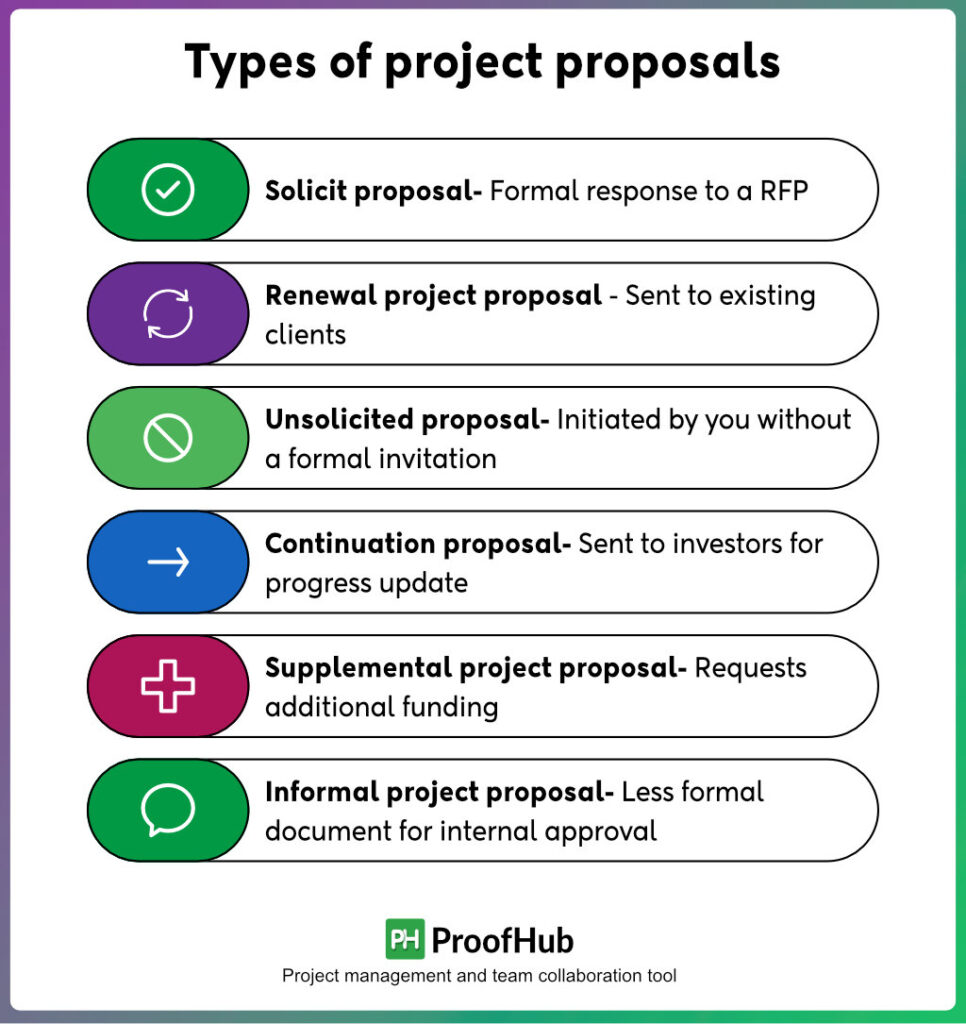
1. Solicited project proposal
A solicited project proposal is sent in response to a request for proposal (RFP). RFP is a document sent by a company to vendors to seek out resources required for a project. It includes the details of the scope of the work and the payment company pays for the resources.
RFP is sent to many vendors. Thus, while writing a solicited project proposal, you need to keep in mind that you may be competing against other vendors to secure a project. Thus, you need to keep your tone persuasive.

2. Unsolicited project proposal
This type of proposal is sent without having received a request for a proposal (RFP). A company has not sent a request for proposal to vendors but you know that the company is seeking resources from third-party vendors. You may or may not be competing against the other vendors in this type of proposal.
3. Informal project proposal
It is a type of project proposal that is created when a client makes an informal request for a project proposal from vendors. It means there is no formal RFP. Thus, the rules for writing a project proposal are less concrete. You can follow any format that can secure you a project.
4. Renewal project proposal
A project manager writes this type of proposal to existing clients to extend their services to the client. In this type of proposal, you focus on highlighting past achievements to secure a renewal for the future.
5. Continuation project proposal
The purpose of the continuation project proposal is to inform the client that the project is beginning and communicate the progress. You are not persuading the client with this type of proposal.
6. Supplemental project proposal
As the name suggests, this type of proposal is sent to the stakeholders who are already involved in a project to secure additional resources. The purpose is to convince the client to invest additional resources during the project execution phase.
How to write a winning project proposal?
You need to include certain elements in the project proposal to make sure it is good. Have a look at the steps to learn how to format a project proposal.
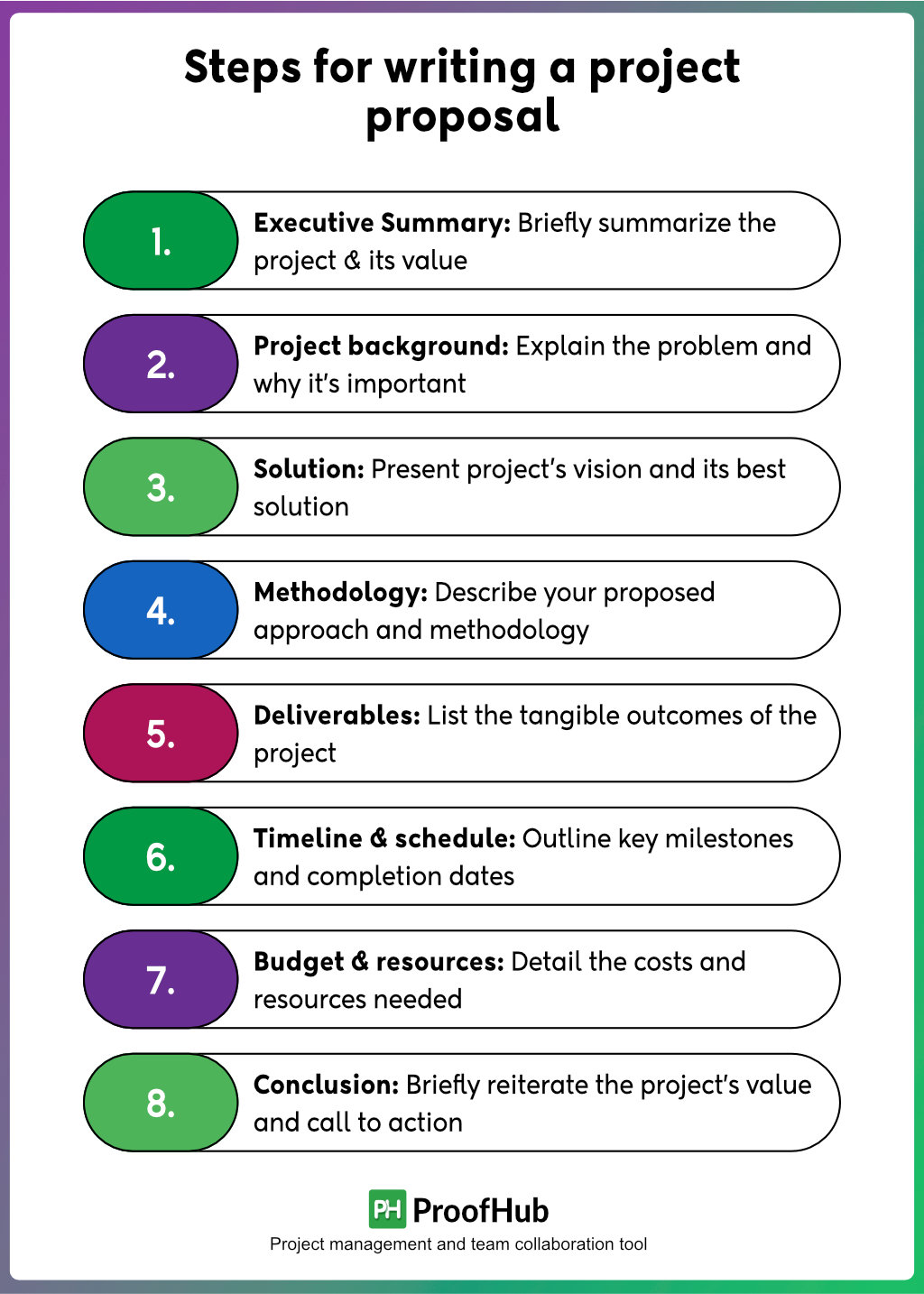
A. Pre-writing stage
The pre-writing stage is crucial for creating a compelling and successful project proposal. Here’s a breakdown of the key steps involved:
1. Understanding the audience
The first step is to identify decision-makers and understand the mindset of the audience for which you are writing a proposal. Thoroughly research the client’s needs, goals, and expectations. This includes understanding their industry, current challenges, and past projects.
Determine who will be reviewing and approving the proposal. This will help you adjust the tone, level of detail, and overall focus to cater to their expertise and interests. Tailor your proposal to directly address their specific concerns and priorities.
2. Project requirements gathering
To create an effective project proposal that has a higher chance of getting accepted, gather the project requirements. Usually, it is mentioned in the Request for Proposal (RFP) where specific requirements, evaluation criteria, submission deadlines, and any other instructions are provided.
If there is no RFP, schedule meetings or interviews with key stakeholders to gain a deeper understanding of the project requirements. This allows you to ask clarifying questions, gather feedback, and ensure your proposal aligns perfectly with their expectations.
3. Team brainstorming
Writing a project proposal is teamwork. Involve your team in brainstorming sessions to make a strong proposal. When a team is involved, it diversifies perspectives and expertise, leading to a more comprehensive and well-rounded proposal. Discuss the project goals, potential solutions, and resource needs with your team. Refine the proposal concept based on the collective knowledge and ensure everyone is aligned on the final approach.
B. Writing the proposal
1. start with writing an executive summary .
An executive summary is a concise overview of what a project is all about. It talks about the most important details or information of the project.
It primarily talks about the problem a project will solve, the solution a project will provide, and the benefits stakeholders will get from investing in this project.
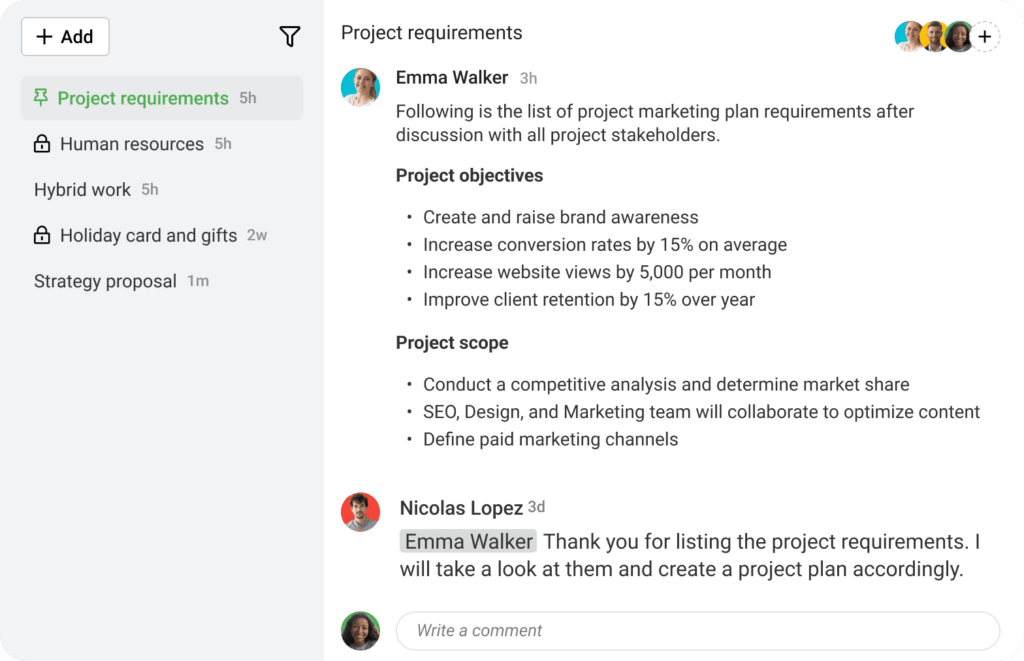
It is important to keep in mind to explain these items briefly as you are going to explain the problem and solution in detail later in your proposal.
The purpose of writing an executive summary is to pique the interest of the stakeholders in a project. It is like the elevator pitch of an entrepreneur whose purpose is to attract the stakeholders for further discussion.
2. Explain the problem in the project background
The project background is a one-page section that focuses on highlighting the opportunity by talking about the project problems you are going to solve. It talks about the problem and its history such as statistics, references, and start date.
It discusses what has been done so far to solve the problem by others or earlier projects. What is the current state of the problem, and how your project will focus on solving it?
This section indicates the opportunity and the next section of vision explains how you are going to seize the opportunity.
3. Project vision and solution
Project vision is the section where you present the solution to the problem. Vision statement defines your vision for the project, the solution you are going to work on, and how it will solve the problems.
This section tells what goals and objectives you are going to achieve from the project. Thus, it also acts as a north star or success criterion for your project.
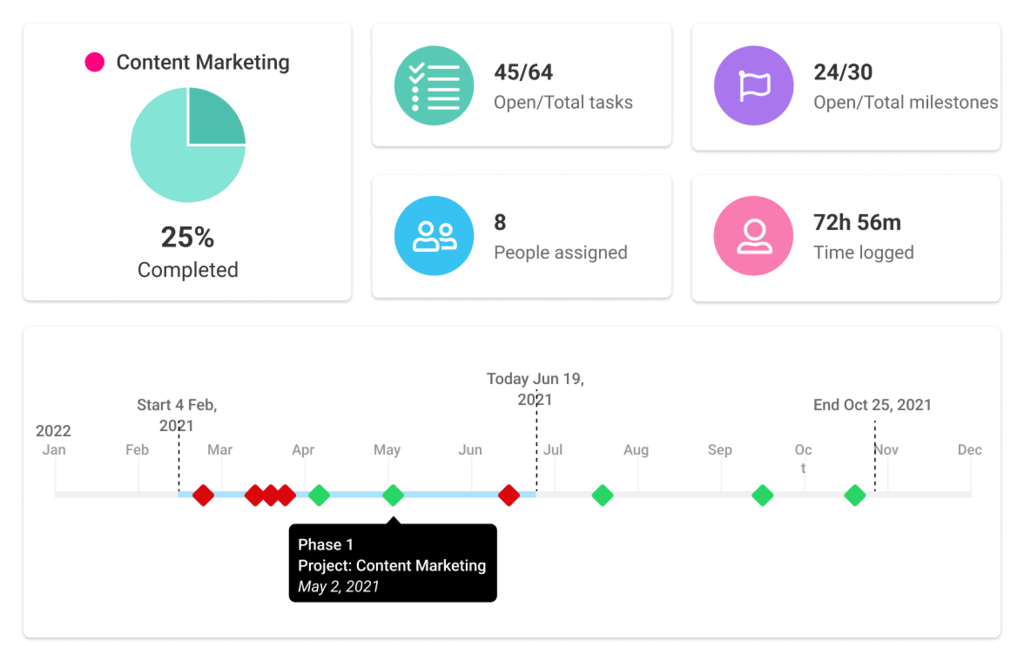
Now, stakeholders know what a project is all about; the problems, the solution, and the objectives. And they are interested to know how you will achieve the proposed objectives of a project.
The next sections of a project proposal talk about the project approach, scope, deliverables, milestones, budget, resources, and timeline.
Read more: Project objectives: learn how to write them for business growth
4. Project scope and deliverables
This section describes all the work items you need to work on a project. It involves breaking a large project into small tasks so that stakeholders can easily understand the project scope.
It also includes describing key milestones and project deliverables during the execution phase of your project life cycle.
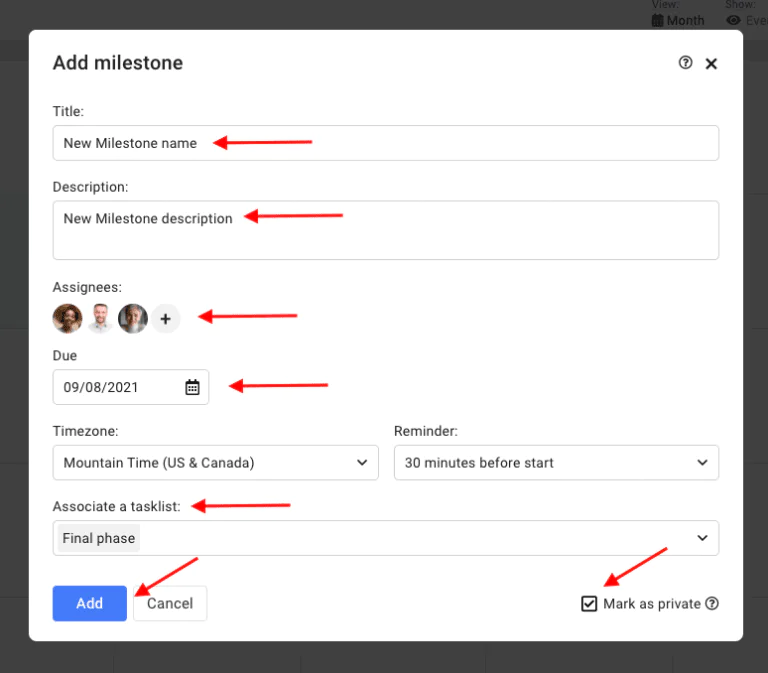
The purpose is to provide stakeholders with enough information to make decisions about funding and resources.
5. Project timeline
Project stakeholders have a clear idea about the scope of the project. But the very next question that comes to stakeholders’ minds is how much time a project will take to complete.
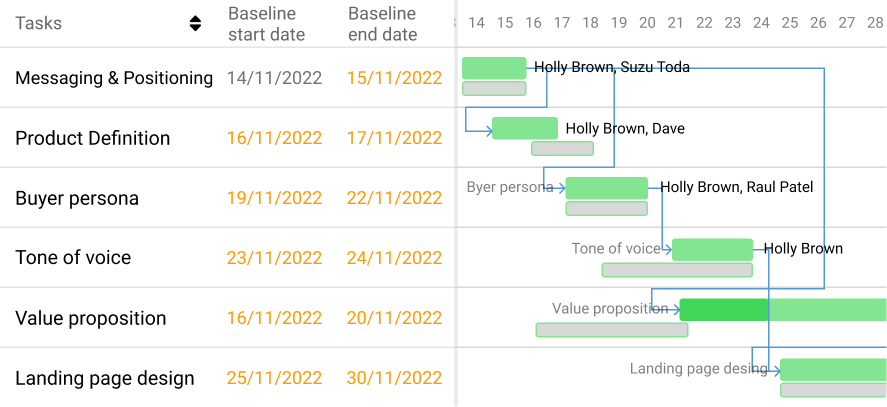
You need to propose an estimated timeline for the project describing when the key deliverables and milestones will be delivered and achieved.
6. Project methodology
With every project, the risks of cost, scope, time, and quality are associated. Thus, you need an effective project management approach to manage these risks.
In this section, you explain to stakeholders about the project approach you are going to use for project management . It includes defining project management methodology, tools, and governance for your project.
79% of teams worldwide use digital collaboration tools . The choice of your project management tool is going to influence how the project will be planned, executed, and managed and its potential risks are identified and mitigated successfully.
ProofHub is an all-in-one project management and team collaboration software that provides you with a centralized platform to collaborate with a team on a project proposal.
ProofHub strengthens your project proposal’s “Implementation Plan” by providing a platform to meticulously define tasks, assign roles, and track progress . Its work plan section allows for a detailed breakdown of the project with clear task dependencies and time estimates, visualized through a Gantt chart .
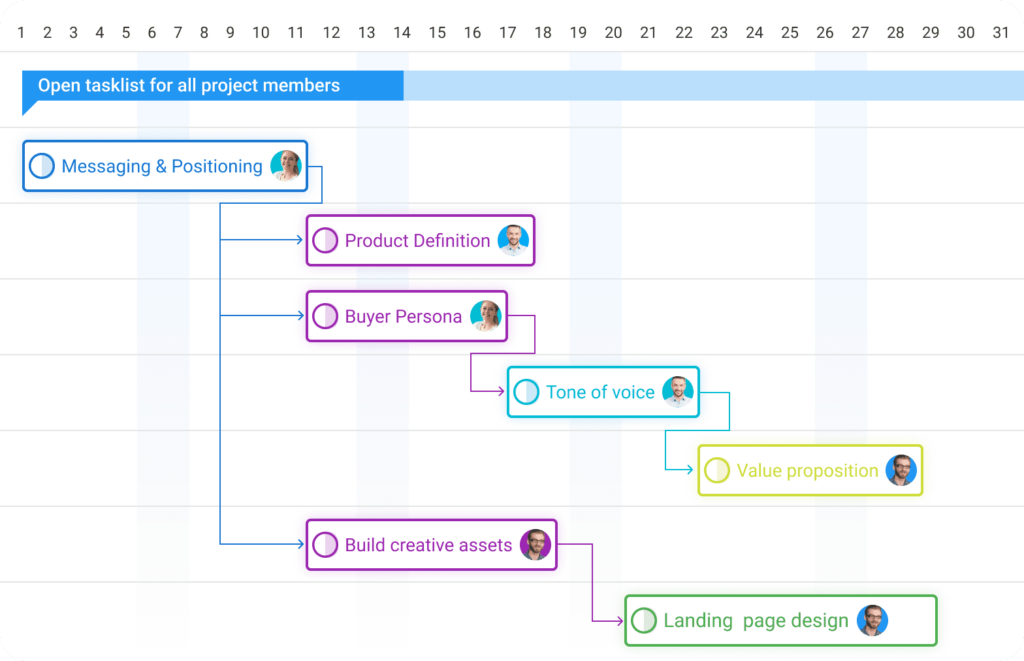
Team members can be assigned to specific tasks, ensuring accountability, while resource allocation demonstrates a well-planned approach.
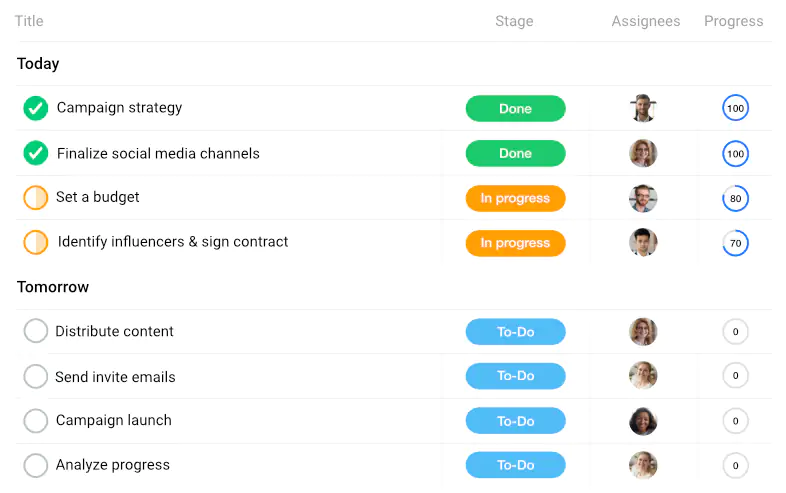
Real-time progress updates, collaborative discussions within tasks, and reporting capabilities showcase transparency and proactive management.
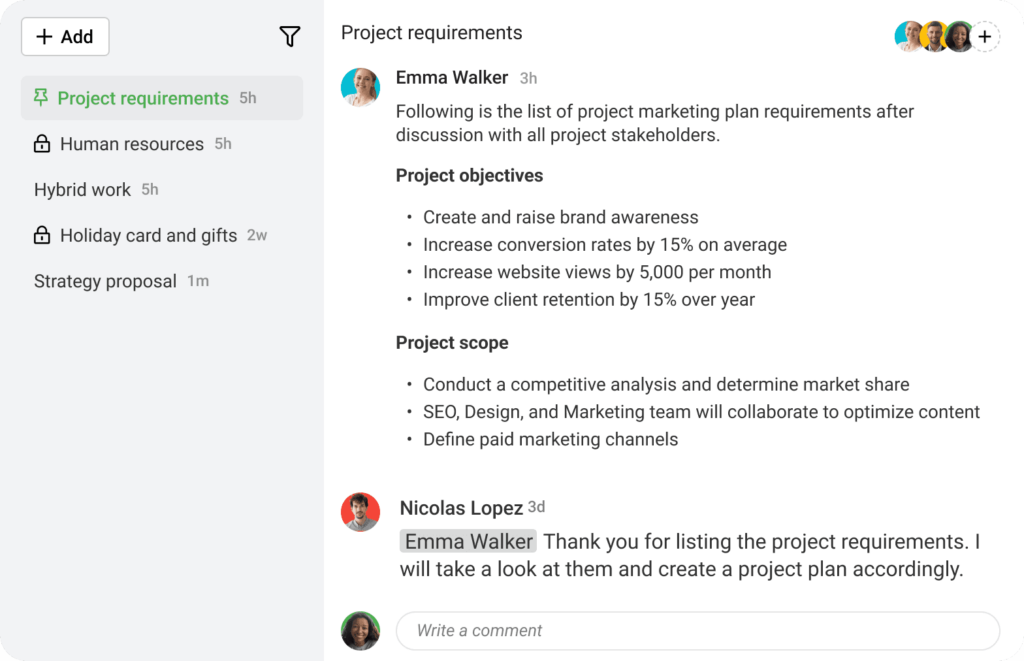
By incorporating ProofHub, your proposal presents a clear picture of efficient execution, giving the reader confidence in your ability to deliver the project successfully.
Learn more about ProofHub’s collaboration capabilities !
7. Project resource requirements
Project resource requirements talk about the resources you need to complete your project which includes materials, human resources, and technology. It is a key section that is crucial for the success of the project because every project needs resources to convert a plan into action.
This section of the project proposal briefly describes the project resources you need for the project and how you are going to utilize these resources.
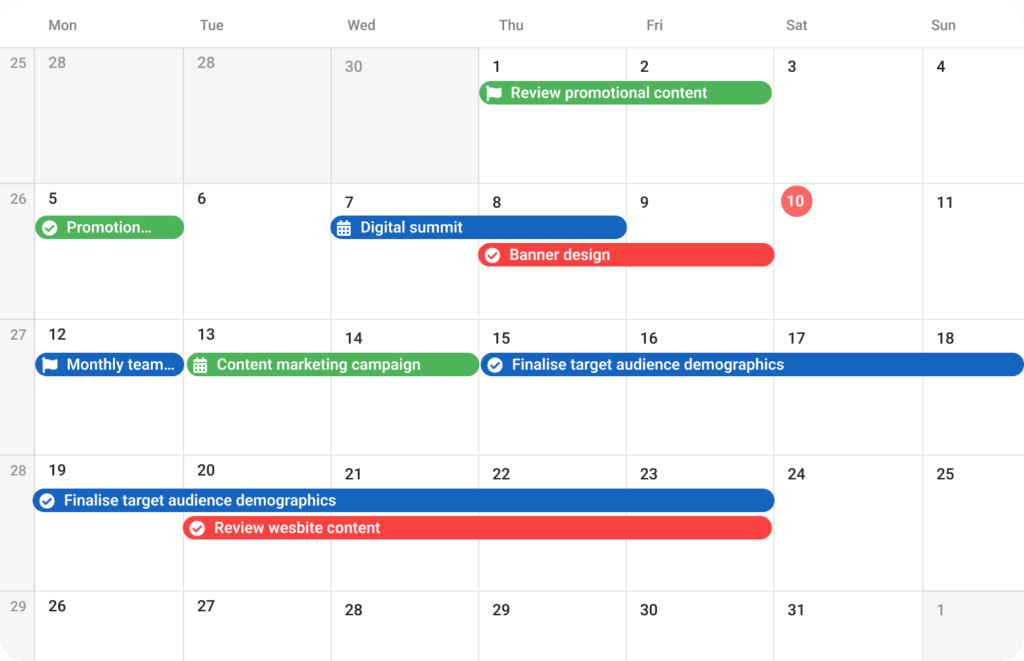
It does not explain the nitty gritty details of resource allocation. But, it gives a fair idea of why you need specific resources for your project and how these will be utilized.
Read more: 2024 guide to project resource management: processes, challenges & tools
8. Estimate project costs and budget
Project resources come at a price. Thus, in this section, you will define the project costs and create a project budget. It is the responsibility of a project manager to write this section in such a way that it covers all the project expenses.
At the same time, it also provides the opportunity for stakeholders to jump in and help you mitigate unexpected costs.
It also includes estimating project costs everything from the cost of project technology to team salaries and materials.
9. Closing statement
At this point of a project proposal, stakeholders have complete information about the project: scope, cost, time, objectives, and impact. You just have to briefly summarize the problem your project addresses and remind stakeholders about the benefits they will get from this project.
You can use cost-benefit analysis to demonstrate why your project is profitable. Thus, in this section, you wrap up your project proposal with a persuasive and confident conclusion to convince stakeholders to close the deal.
I hope these steps help you write a winning project proposal. Now, let’s have a look at some practical tips from experts to write a winning proposal.
Additional tips to write a perfect project proposal
Here are the five practical project proposal tips for writing a proposal:
- Clarity and conciseness: Do not use jargon or make your proposal overly complex. Keep it simple so that project sponsors can understand it easily.
- Strong value proposition: You want your project proposal to be accepted. Give strong emphasis on the benefits of your project and how it addresses the existing problems.
- Compelling visuals: Make your proposal compelling so that project sponsors read it. If it is not persuasive and visually interesting, project sponsors may not read it.
- Proofreading and editing: Do not make silly grammatical mistakes and fact check and proofread your proposal. Wherever required provide statistics to back your claims.
- Use collaboration tools: A project proposal involves explaining about project scope, cost, time, and resources. Use a project management tool like ProofHub to create a plan and collaborate with a team to create an effective project proposal.
Project proposal examples
A project proposal in project management is primarily sent to the stakeholders to secure funding, gain approvals, and request resources from stakeholders.
Here is a real-world example to get an idea of how to write a proposal for a project:
Project Proposal: Implementation of a CRM System to manage company customers, prospects, and leads
1. Executive
The Customer Success Manager at XYZ Corporation is proposing the implementation of a new Customer Relationship Management (CRM) system.
Currently, the company is using a legacy system that makes it difficult to manage data and ensure the alignment between the sales and marketing teams. It results in poor customer service to the customer and missed opportunities.
The new CRM system streamlines the company’s customer interactions, improves data management, and enhances overall customer satisfaction.
This results in enhanced customer relationships, improved operational efficiency, and increased business growth.
2. Background
- Lack of centralized data management system
- Lack of alignment between marketing and sales departments
- Not able to provide exceptional customer experience due to operational inefficiencies
3. Vision
- Implementing CRM to improve customer data management by centralizing all customer information into a single database
- Enhance communication and collaboration among sales, marketing, and customer service teams
- Increase customer satisfaction and retention through personalized and timely interaction
4. Project scope
- Researching and selecting a suitable CRM solution based on the specific needs and requirements of XYZ Corporation.
- Customizing the CRM system to align with the company’s business processes and workflows.
- Migrating existing customer data from legacy systems into the new CRM platform.
- Phase 1: Research and Selection (1 week)
- Phase 2: Customization and Configuration (2 weeks)
- Phase 3: Data Migration (1 week)
- Phase 4: Training and Adoption (2 weeks)
- Phase 5: Go-Live and Deployment (2 weeks)
5. Project management approach
Hybrid project management : Waterfall during the planning of each phase of the project and Agile during the implementation of the CRM.
6. Project resource and budget
The estimated budget for the CRM implementation project is $50,000, including software licensing fees, customization costs, training expenses, and implementation services.
7. Project risks and mitigation
- Potential resistance from employees toward adopting new technology
- Integration challenges with existing systems and applications:
Mitigation:
- Addressed through providing training sessions for employees to ensure hassle-free adoption of the CRM system.
- Managed through careful planning and coordination with IT vendors and stakeholders.
8. Conclusion
The implementation of a CRM system for XYZ Corporation enhances customer relationships, improves operational efficiency, and drives business growth. We seek approval from the executive management team to proceed with the implementation of the CRM system as outlined in this proposal.
Project management proposal template
Trying to manage a project without project management is like trying to play a football game without a game plan. – Karen Tate
A project management proposal template provides the framework and detailed proposal outlining to create a project proposal. It outlines the sections you need to include in a project proposal and the instructions in each section. By following the instructions in the template, you know how to make a project proposal, customized to your business needs.
Here is the project management proposal template:
1. Executive Summary
In this section, you will summarize the complete project proposal and add the most important details of the project.
Outline the following details in brief in the executive summary:
- Project background and vision
- Project goals and deliverables
- Project budget, timeframe, resource, and success criteria
2. Project Background
In this section, you will talk about the problem a project is going to solve or the business opportunity a project intends to grab. Explain it in-depth because it forms the basis of the project.
Here is what you need to include:
- Project history and stats of similar projects
- The basis upon which the project is created
3. Project vision
This section includes the project vision statement. You explain the solution to the project problem and define the goals of the project.
Here is what you need to do:
- Write a project vision
- Present a solution
- Write the SMART goals you want to achieve
4. Project plan
It includes multiple sections as below:
4.1 Project scope and deliverables
Project scope defines all the work you need to do to complete the project.
Project deliverable is something that is of the end-user or customer value.
4.2 Project timeline
Every project has a start and an end date. Similarly, there is a timeframe for each task and deliverable.
4.3 Project approach
Every project follows an approach to project management and uses project management tools. For example, construction projects follow the Waterfall methodology whereas software development projects follow the Agile methodology.
4.4 Project risks
A project risk is something that can impact the cost, time, and scope of the project.
List here all the project risks, likelihood, impact, mitigation plan, and risk owners in a table.
4.5 Project resource requirements
Project sponsors need to know about the details of the resources required to approve the budget for the Project Proposal.
Define the project resource requirements here in the table:
- Technology requirements
- Human resources requirements
- Material requirements
4.6 Project estimated cost and return on investment
A project sponsor wants to know the project costs and return on investments.
4.7 Project ownership and communication plan
This section includes the details of the key stakeholders of the project.
- Project sponsor: who owns the project
- Project customer: who the project is being delivered to
- Manager: who is responsible for managing the project and informing the status to stakeholders
5. Call to action
In this section, provide your contact details for the client to get in touch with any questions or allow the project sponsor to authorize the project if they are happy with the project proposal.
It is important to keep in mind the above-mentioned are the standard sections that are included in most project proposals. If you want to add some other elements to your project proposal, you can add the sections as per your needs to format a project proposal.
Create a winning project proposal with the right tool
A good project proposal convinces stakeholders why the project should be carried out. It should clearly describe project problems, project objectives, benefits for stakeholders, your requirements from stakeholders, and how you will utilize the secured resources. You need to have a good understanding of the project and project sponsors and stakeholders before writing a project proposal.
To create an effective project proposal, you need cross-collaboration between departments to gather key details and project management software to plan a project.
That’s where a feature-rich project management software, ProofHub, comes into play. It helps you with team collaboration and project planning for the project proposal. You can create a project plan using a Gantt chart , create tasks using task management software , and collaborate with the team using chat and a centralized file-sharing system .
Organize, manage, and collaborate seamlessly with ProofHub – All-in-one solution for projects, tasks, and teams
Related articles
- How to manage projects with a tool like ProofHub
- 10 Common project management challenges (and How to solve them)
- Project objectives: learn how to write them for business growth
- The 11 best project management software for your team
How long should a project proposal be?
A project proposal should not be too long. Ideally, a project proposal should take 1-2 pages but it also depends on the complexity of the project and the format you choose.
What section of a proposal presents a list of project costs?
Project costs are briefly covered in the Project Cost section. However, it depends on the template you choose. The detailed breakdown of the project costs is attached with the project proposal in the reference document.
What section of a proposal identifies the key issues and discusses the project goals?
Project background and project vision are the sections that talk about the key issues and project goals. However, it is explained in brief in the executive summary also.

- Share on LinkedIn
- Email this Page
- Share on Facebook
- Share on WhatsApp
Try ProofHub, our powerful project management and team collaboration software, for free !
No per user fee. No credit card required. Cancel anytime.
High Converting Proposal Templates (From 25,000 Winning Proposals)
Follow proven formulas to land more clients and simplify your proposal-writing process. tested in the real world. yours for free., what makes a winning proposal.
We researched over 25,000 proposals worth $270 million dollars to find the key differences between winning and losing proposals.
We've taken everything we learned about winning proposals and created this library with sample content, proposal stats, and free proposal templates that you can download.

Problem statement
A client must believe you understand their needs. Clearly listing the problems they face, in language they can understand, builds trust and makes the client want to read about the solution.
Recommended solution
Recommended solutions should directly address a client's needs. The best solutions talk about the problems they're solving and use language that makes sense to potential clients.
What are the specific benefits the client will receive from solutions you've recommended? It's important to spell out the benefits of your service (and be as specific as you can). These should be benefits that the client is looking for.
Project fees
Pricing information should be easy to digest, so keep it high level. Make sure the fee description is directly tied to the recommended solution. Think in "fee packages" instead of individual fee items.
Call to action
Ending with a call to action lets a client know exactly what they should do to get the project started. The best calls to action are simple and clear.
Proposal Templates and Samples

Marketing Proposal Template
It’s time to stand out from the pack and land the best marketing clients. The proposal template for marketing projects provides a persuasive, logical framework you can follow to save time and frustration on proposals while still landing the best clients.

Website Proposal Template
Writing website proposals takes can take a lot of trial and error. Check out the Bidsketch web design proposal template kit to get an idea how you should structure your content to give you the best chance of winning projects.

Social Media Proposal Template
You're an expert at building communities online. An awesome proposal will convey that to clients in an unforgettable way. Follow our proposal template step by step to showcase your expertise and land your dream clients.
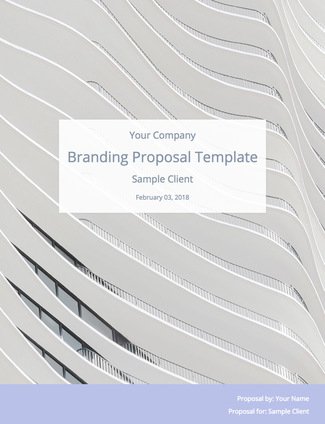
Branding Proposal Template
Ready to land the branding clients everyone wants to work with? Check out the Proposal Template for branding projects. It gives you a logical framework you can follow to land the best clients and save time and frustration.

Event Photography Proposal Template
Want to save time on your proposals and still land more photography clients? Check out the Event Photography Proposal. It gives you a framework and real-life examples to make a great impression and tackle proposals quickly and effectively.

Consulting Proposal Template
Want more high-quality consulting clients? Check out our sale consulting proposal template to make writing consulting proposals painless and more effective.

Project Proposal Template
Write better project proposals with the project proposal template. Stop writing proposals from scratch by using this easy-to-customize template, and follow our easy guidelines.

SEO Proposal Template
Want to write more effective SEO proposals in even less time? Check out our proposal template geared toward helping SEOs get their dream clients, and stand out from their competitors.

Web Development Proposal Template
A killer web development proposal gets you access to the clients that everyone wants. Check out our web development proposal template for a comprehensive framework to write better proposals and stop blending in with your competitors.

Mobile App Development Proposal Template
Your proposals need to stand out if you want to land the best mobile app clients. The Mobile App Development Proposal Template gives you the framework you need to save time, make a memorable impression, and land clients without all the hassle. Check it ou

PPC Proposal Template
How do you get the best PPC clients’ attention and convince them to hire you? It all comes down to your proposals. Check out the PPC Proposal Template for everything you need to save time, make a memorable impression, and land the clients you want.

Digital Agency Proposal Template
It’s time to show your dream clients you’re the best choice for their digital marketing needs. The Full Service Digital Agency Proposal Template gives you a framework so you can stop competing on price and start landing more clients. Check it out.

Graphic Design Proposal Template
As a designer, it's critical to make a great first impression. These professional looking (and persuasive) proposal templates will help you land high-end clients, and make that great first impression.
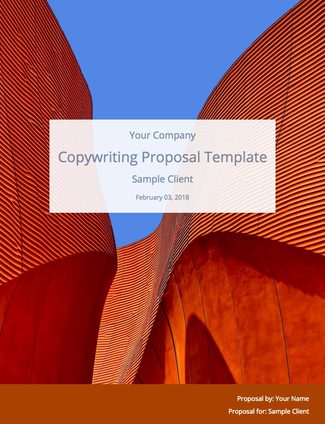
Copywriting Proposal Template
Want to spend less time writing copywriting proposals and appeal to your dream clients? Check out the Copywriting Proposal Template. It uses real-life examples to show you how to get attention, stand out from competitors, and land more clients.

CRO Proposal Template
It’s time to land the CRO clients you want without all the hassle. Check out the CRO Proposal Template for step-by-step instructions to get clients’ attention, stop competing on price, and turn your proposals from chores into persuasive sales tools.

Ecommerce Proposal Template
You can’t stop writing proposals, but you can start using them to make a killer first impression and attract the best clients. The E-Commerce Proposal Template helps you grab attention and stand out from competitors… without all the hassle. Check it out.

Content Marketing Proposal Template
The first step to landing dream clients is winning them over with your proposals. The Content Marketing Proposal Template gives you a framework, along with real-life examples, to help you do it in record time. Check it out.

Email Marketing Proposal Template
Your proposals can get your foot in the door with dream clients. Check out the Email Marketing Proposal Template. It gives you the tools you need to make an unforgettable impression, land the clients you want, and save time while you’re at it.

WordPress Website Proposal Template
Ready to get your foot in the door with the best WordPress clients? The WordPress Website Proposal Template by WPElevation will help you save time, showcase the full value of your skills, and stand out from all your competitors.

Event Planning Proposal Template
If you want to plan events for top clients, your proposals have to make a killer first impression. That’s where the Event Planning Template comes in. See how to stand out from competitors and attract the best clients. Check it out.

Freelance Writing Proposal Template
Want to stop wasting time and grow your writing business as fast as possible? Check out our freelance writing proposal template and use it to persuade clients to hire you instead of anyone else.

IT Consulting Proposal Template
It takes a special touch to break down your technical expertise in a way others can understand. The IT Consulting Proposal Template will help. Follow this simple, proven blueprint to save time and attract your dream clients. Check it out.

Product Photography Proposal Template
Tired of churning out proposals that make you invisible to the best photography clients? Check out the Product Photography Proposal Template. It gives you a framework to follow to separate yourself from the competition and land more clients in less time.
Why You Need a Winning Professional Proposal
Most of your competitors aren't sending proposals at all. They're sending estimates. Maybe you're even doing it yourself.
Do you know the difference?
Our research of over 25,000 client proposals (over $270 million) found that it's critical.
Estimates Focus on Price
Estimates and quotes are created to tell a client what will be done and how much it will cost.
They keep the client focused on cost instead of the value they'll receive.
Sending a client an estimate might seem like the perfect way to quote a price, but it comes with its own set of big problems.
First, only showing pricing takes the client's focus away from the results they're asking for, and emphasizes units of time or the cost required per task.
Also, labeling services in the way that most estimates are shown, invites clients to compare your prices with your competitors'.
You're commoditizing your service.
You offer a special service, a real solution for the client. But when you let the dollar value of your work become the focus of communication, you're lowering yourself into a vast pool of virtually identical competition.
In the commodity space, work drops straight to the lowest bidder.
Estimates tend use technical descriptions which can get complicated. A list of various services, each with its own dollar cost, quickly becomes confusing.
Tip: If a client is confused, they probably won’t hire you. Fees should be simple and communicate value. It's not about being creative as much as clearly showing value. This applies whether you're pitching small business or enterprise deals.
Business Proposals Are Sales Documents
Proposals are persuasive documents that also include price. They're written to show clients that you understand their company and know exactly how to solve the problems they face.
How to Land More Clients with Your Proposals
1. make them shorter.
Our research shows that proposals with less than 5 pages are 31% more likely to win .
A lot of sales proposals start out great but go on for too long. Knowing what to leave out is just as important as knowing what to include.
How can you give potential clients the information they need and remain compelling?
Following a proven structure will help you make your strongest points without carrying on too long.
Tip: Many clients will read proposals out of order or flip back and forth between sections. So every element should be carefully structured to persuade. Take a look at the proposal examples on this page for a good guide on length.
2. Use Revenue Power-ups (to Boost Sales)
Proposals with upsells generate 32% more revenue .
The key is to offer enhanced options. That way, you don't have to do any more selling. The prospective client is already sold on your service, you're just offering to make that service even better.
So if you were a creative working with a partner (offering website design), maybe you could offer the enhanced service of mobile-responsive site programming.
If you're a marketing agency running Google PPC ads for small business, offer the enhancement of creating the landing pages and drip campaigns that nurture those leads, for a higher ROI.
Don't sell the client on something new. Offer them a better version of something they’re already buying.
Here are a few power-up and upsell ideas to get you started:
3. Send them Sooner
Winning services proposals get to clients 26% faster.
We found that your turnaround time makes a big difference. Less than 24 hours separated our average winning turnaround time (2.7 days) from the average losing time (3.4 days).
It's a fine line to walk. You don't want to be sloppy, but you want to do everything you can to respond quickly.
Timing can often make the difference landing a client and missing out.
Project proposals can be tedious chores if you're starting from scratch every time. But they don't have to be.
Following the winning proposal templates below will save you time and streamline and proposal-writing process.
It's a proven recipe for more clients!
- World Version
- Page Version
- InDesign Version
- Retainer Proposal
- Multiple Templates
How to Write a Budget Proposal (+ Free Template)
Published: May 29, 2024
The first time I was assigned to write a budget proposal, I stared anxiously at a blank spreadsheet, wondering where to begin. What was a budget proposal supposed to include? Was there a specific structure to follow? How could I ensure it met all the necessary criteria?

My early attempts at writing a proposal taught me the challenges of building a convincing plan that turns rough ideas into fundable projects. I had to learn to align proposal details with business objectives and articulate the potential benefits in a way that resonated with stakeholders.

It was an overwhelming task at times — but with a strategic approach and a bit of guidance, my ability to synthesize financial data and communicate value gradually became second nature.
In this article, I'll guide you through how to write a simple budget proposal that delights your audience and secures funding. I’ll also provide practical tips, templates, and sample projects to streamline your planning process.
So, let’s get started.
Table of Contents
What is a budget proposal, and why is it important?
The anatomy of a budget proposal, how to create a simple budget proposal, building my own basic budget proposal, 8 budget proposal best practices.
A budget proposal outlines the financial plans for a project or initiative, detailing the expected costs and resources needed for successful completion.
Budget proposals also show potential funders or stakeholders how their money will be spent and the tangible benefits their investment will achieve.
While the content of your budget proposal will change depending on your project’s parameters and specific goals, a well-crafted plan leads to benefits like:
- Stakeholder buy-in. Providing a transparent breakdown of anticipated expenses instills confidence and trust, encouraging stakeholder support or investment.
- Efficient resource usage. Outlining a clear resource allocation plan ensures that funds are directed to the areas where they are needed most.
- Risk mitigation. Applying a risk management framework helps proactively identify potential costs and contingencies, ensuring that the project remains on track and within budget constraints.
- Project tracking. Identifying key project milestones and benchmarks promotes informed decision-making, maintaining efficient and agile progress.
.png)
Free Business Budget Templates
Manage your business, personal, and program spend on an annual, quarterly, and monthly basis.
- Personal Budget Template
- Annual Budget Template
- Program Budget Template
You're all set!
Click this link to access this resource at any time.
Before you begin drafting your budget proposal, it's helpful to first familiarize yourself with its key components and overarching structure.
Knowing which strategic points to emphasize — and the order in which to present them — improves your ability to create a logical and compelling argument, while also ensuring you effectively communicate your project’s feasibility.
So, let's examine five critical sections found in every effective budget proposal, drawing on the structure used in Hubspot’s Free Budget Proposal Template .
7. Build a story.
Weave in a strong storytelling narrative that provides context, explains assumptions, and addresses any potential concerns or questions. This adds depth to your proposal and helps guide readers through the document.
Pro tip: Incorporate data visualization techniques, such as graphs or infographics, to complement your narrative and enhance the clarity and persuasiveness of your budget proposal.
Don't forget to share this post!
Related articles.

How a Bottom-Up Budget Can Transform Your Company From Bottom to Top
![proposal writing with example Marketing Budget: How Much Should Your Team Spend in 2024? [By Industry]](https://blog.hubspot.com/hubfs/how%20to%20spend%20your%20marketing%20budget_featured.webp)
Marketing Budget: How Much Should Your Team Spend in 2024? [By Industry]

The Best Free Business Budget Templates
![proposal writing with example How Marketing Leaders are Navigating Recession [New Data]](https://blog.hubspot.com/hubfs/how%20marketing%20leaders%20are%20navigating%20recession.webp)
How Marketing Leaders are Navigating Recession [New Data]
![proposal writing with example 3 Ways Marketers are Already Navigating Potential Recession [Data]](https://blog.hubspot.com/hubfs/how-marketers-are-navigating-recession.jpg)
3 Ways Marketers are Already Navigating Potential Recession [Data]
![proposal writing with example Marketing Without a Budget? Use These 10 Tactics [Expert Tips]](https://blog.hubspot.com/hubfs/marketing%20without%20budget.jpg)
Marketing Without a Budget? Use These 10 Tactics [Expert Tips]

24 Ways to Spend Your Marketing Budget Next Quarter

Startup Marketing Budget: How to Write an Incredible Budget for 2023
![proposal writing with example How to Manage Your Entire Marketing Budget [Free Budget Planner Templates]](https://blog.hubspot.com/hubfs/free-marketing-budget-templates_5.webp)
How to Manage Your Entire Marketing Budget [Free Budget Planner Templates]

10 Best Free Project Management Budget Templates for Marketers
6 templates to manage your business, personal, and program spend on an annual, quarterly, and monthly basis.
Marketing software that helps you drive revenue, save time and resources, and measure and optimize your investments — all on one easy-to-use platform
Customizable, intuitive, and scalable registration forms to sign up attendees with ease.
End-to-end abstract management platform; submission, review, evaluation, program and proceeding export.
Build branded & stunning event websites to engage your attendees.
Personalize your event awarness to expand your reach and drive registrations.
Host interactive virtual events with networking, streaming, engagement tools, and more.
Take a peek at our case studies and other client successes.
Receive guidance, or learn more about troubleshooting.
- Event Registration
- Abstract Management
- Event Webpage
- Event Marketing
- Virtual Conferences
- Case Studies
- Knowledge Center
How to Write a Winning Event Proposal | Step-by-Step Guide

Introduction
In the competitive world of event planning, securing new clients often hinges on the quality of your proposal. A well-crafted proposal not only showcases your expertise and creativity but also demonstrates your understanding of the client's vision and needs. It serves as your first impression and a crucial factor in winning the job.
The purpose of this article is to guide you through the process of preparing and extending a compelling event proposal that stands out from the competition. We will provide a step-by-step framework to help you effectively communicate your ideas, present your services, and highlight the value you bring to the table. By following these guidelines, you can increase your chances of impressing potential clients and securing more event planning opportunities.
Whether you're a seasoned event planner or just starting out, this comprehensive guide will equip you with the knowledge and tools needed to create a winning proposal that resonates with clients and meets their expectations. Let's dive in and explore the essential components of a successful event proposal.
Understanding the Client's Needs

The foundation of a successful event proposal lies in understanding the client's needs and vision for the event. Before you start drafting your proposal, it is essential to gather as much information as possible about the client and their expectations. Here are some steps to help you achieve this:
Initial Research
Start by conducting thorough research on the client’s business, industry, and event history. Understanding their brand, mission, and previous events will provide valuable insights into their preferences and expectations. Look for the following information:
- Company Background: Learn about the client's history, values, and key products or services.
- Target Audience: Identify the primary audience for the event, including demographics, interests, and needs.
- Previous Events: Review past events organized by the client to understand their style, scale, and typical outcomes.
Client Communication
Effective communication with the client is crucial to grasp their specific needs and objectives. Schedule a meeting or call to discuss the event in detail. During this conversation, ask open-ended questions to gather information and clarify any ambiguities. Key areas to cover include:
- Event Goals and Objectives: What are the primary goals of the event? Is it to launch a new product, celebrate a milestone, foster team building, or something else?
- Event Theme and Vision: What is the client’s vision for the event? Are there any specific themes, colors, or styles they have in mind?
- Budget Constraints: What is the client’s budget for the event? Understanding their financial limitations will help you propose realistic and feasible solutions.
- Key Stakeholders: Who are the decision-makers and key stakeholders involved in the event planning process?
- Preferred Venues and Dates: Are there any specific venues or dates the client prefers or wants to avoid?
Aligning Expectations
Once you have gathered all the necessary information, summarize your understanding of the client's needs and confirm these details with them. This step ensures that both you and the client are on the same page and helps avoid any misunderstandings later in the planning process. Provide a brief outline of your proposed approach to demonstrate your alignment with their vision.
By thoroughly understanding the client's needs and expectations, you can tailor your proposal to address their specific requirements, making it more relevant and compelling. This client-centric approach is the first step towards creating a proposal that stands out and wins the job.
Structuring Your Event Proposal
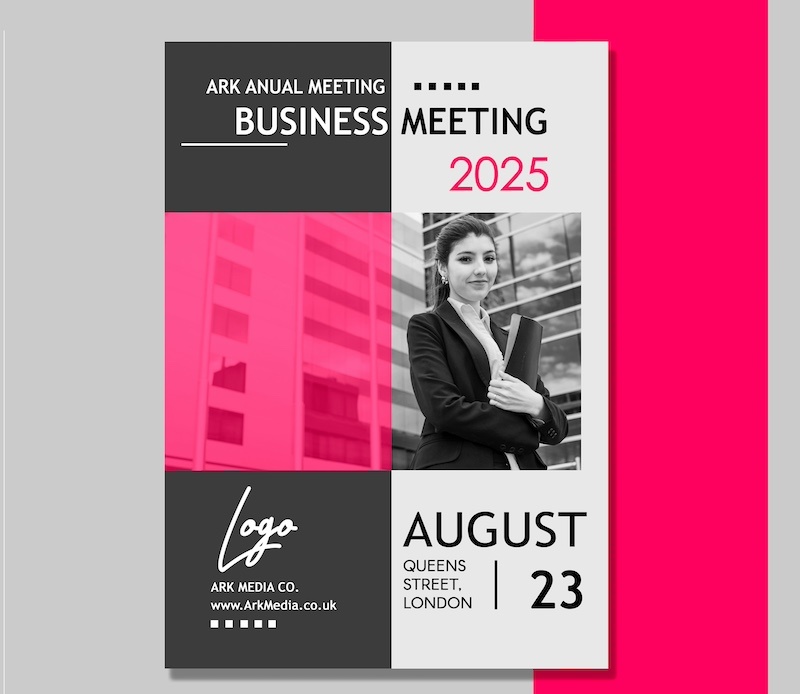
A well-structured event proposal not only looks professional but also makes it easy for the client to understand your ideas and services. Here’s how to organize your proposal to ensure clarity and impact:
Your cover page is the first thing the client will see, so make it visually appealing and informative. Include:
- Event Name: The name of the proposed event.
- Your Company’s Name and Logo: To reinforce your brand.
- Proposal Date: The date you are submitting the proposal.
- Client’s Name and Logo (if applicable): Personalize the proposal by including the client's details.
Table of Contents
A table of contents helps the client navigate through your proposal with ease. List all the sections and sub-sections along with their page numbers for quick reference.
Executive Summary
The executive summary is a brief overview of your proposal. It should highlight the key points and benefits of your proposal, enticing the client to read further. Include:
- Event Overview: A short description of the event and its objectives.
- Your Approach: How you plan to meet the client's needs and ensure the event's success.
- Key Benefits: The unique advantages and value you bring to the table.
Detailed Proposal Content
Introduction and background.
- Your Company Overview: Provide a brief overview of your company, its history, mission, and expertise in event planning. Highlight any relevant experience or accolades that add credibility.
- Understanding the Client’s Vision: Show that you have a clear understanding of the client's goals and the significance of the event. Mention any specific details the client has shared with you.
Event Concept and Objectives
- Event Concept: Describe the proposed event concept and how it aligns with the client’s objectives. Use descriptive language and visuals if possible.
- Goals and Objectives: Clearly outline the goals and expected outcomes of the event, such as brand awareness, product launch, employee engagement, etc.
Event Details
- Event Plan: Provide a detailed plan including the date, time, and location of the event. Mention why the chosen venue and timing are ideal.
- Agenda: Outline the event schedule with specific activities and timings. Include any special sessions, keynote speakers, or entertainment planned.
- Theme and Design: Describe the event theme, design elements, and how they enhance the event experience. Use mood boards or sample designs if available.
Services Offered
- Logistics Management: Detail your approach to managing logistics such as venue setup, equipment, and transportation.
- Catering and Hospitality: Explain your catering services, menu options, and hospitality arrangements.
- Entertainment and Activities: Describe the entertainment options and activities you plan to include.
- Technology and AV Support: Highlight the technology and audiovisual support you will provide, such as sound systems, lighting, and presentation equipment.
Budget and Pricing
- Detailed Budget: Provide a comprehensive budget breakdown, including all costs and fees. Make it clear and transparent.
- Value Proposition: Explain the value and benefits of your services relative to the costs. Highlight any cost-saving measures or added value you offer.
Team and Responsibilities
- Team Introduction: Introduce the key team members who will be involved in planning and executing the event. Include their roles and relevant experience.
- Roles and Responsibilities: Outline the specific roles and responsibilities of each team member to show your organized approach.
Timeline and Milestones
- Project Timeline: Provide a timeline of key milestones and deadlines leading up to the event. Include preparation, execution, and post-event follow-up.
- Milestone Deliverables: Specify the deliverables at each milestone to ensure transparency and accountability.
Risk Management
- Risk Assessment: Identify potential risks and challenges associated with the event. Mention how you plan to monitor and manage these risks.
- Contingency Plans: Outline your contingency plans to mitigate these risks. Show that you are prepared for unexpected situations.
Client Testimonials and Case Studies
- Testimonials: Include testimonials from past clients to build credibility and trust.
- Case Studies: Provide case studies of similar events you have successfully planned. Highlight the challenges faced and how you overcame them.
By structuring your event proposal in this way, you present a professional, thorough, and persuasive document that clearly communicates your capabilities and understanding of the client's needs. This approach significantly increases your chances of winning the job.
Proposal Presentation

A polished and professional presentation of your proposal can make a significant impact. Here are some tips to ensure your proposal is visually appealing and effectively communicates your ideas:
Design and Formatting
First impressions matter, so your proposal should look as good as it reads. Pay attention to the following aspects:
- Consistent Branding: Use your company’s colors, fonts, and logo throughout the proposal to maintain brand consistency.
- Professional Layout: Use a clean, professional layout with clear headings, bullet points, and plenty of white space to make the document easy to read.
- Visual Elements: Incorporate visuals such as images, charts, infographics, and mood boards to enhance the presentation and illustrate your ideas. High-quality images of past events can showcase your capabilities.
- Typography: Choose readable fonts and ensure that the font size is large enough for easy reading. Use bold and italics to highlight important points.
Customization
Customize the proposal to the client's specific needs and preferences. This shows that you have taken the time to understand their unique requirements:
- Personalization: Address the client by name and mention specific details about their business and event goals.
- Tailored Content: Modify the content to reflect the client’s vision, preferences, and budget. Avoid using a one-size-fits-all approach.
Follow-Up and Communication

After submitting your proposal, follow up with the client to demonstrate your enthusiasm and commitment. Effective follow-up can make a difference in securing the job:
Proposal Submission
- Submission Method: Depending on the client’s preference, submit the proposal digitally via email or through an online platform, or provide a printed copy in a professional binder.
- Submission Timing: Submit the proposal within the agreed timeline to show your reliability and punctuality.
Follow-Up Strategy
- Follow-Up Email: Send a follow-up email a few days after submitting the proposal to confirm receipt and express your continued interest. Offer to answer any questions they may have.
- Follow-Up Call: If appropriate, follow up with a phone call to discuss the proposal further and address any concerns. This personal touch can help build rapport.
- Be Persistent but Polite: If you don’t hear back immediately, follow up again after a reasonable period. Be persistent but always remain polite and professional.
In conclusion, preparing a winning event proposal requires a deep understanding of the client's needs, a well-structured document, and a professional presentation. By following the steps outlined in this guide, you can create a compelling proposal that showcases your expertise, aligns with the client’s vision, and significantly increases your chances of securing the job.
A strong event proposal not only sets you apart from the competition but also builds trust and confidence with potential clients. Remember to personalize each proposal, present it professionally, and follow up diligently. These practices will help you forge strong client relationships and grow your event planning business.
Images designed by FREEPIK
- Essay Editor
Proposal Essay Examples: Convincing Ideas for Your Research Paper or Essay

Struggling to craft a captivating and well-built proposal essay? Many students find it challenging to compose a proposal-based essay and struggle to generate convincing ideas. If this sounds familiar, read on. In this comprehensive guide, we streamline the process of brainstorming and composing work, offering resources like suggestions on how to write a proposal essay, suggested steps when writing, useful examples, and efficient essay-crafting tips.
Developed through several years of expertise in scholarly writing, our article is meticulously tailored to help you excel in your academic assignments. Join us as we explore crafting an exceptional proposal paper. With the right tools and assistance, you'll move from ambiguity to self-assurance, ready to write an impressive work. Let's master the art of creating an attention-grabbing essay.
What is a Proposal Essay?
A proposal essay succinctly outlines the key content and aim of your intended study, summarizing its primary points and overall intent. Unlike a thesis, which presents the main idea of your academic study, a proposal-focused assignment acts as a detailed plan addressing a specific problem. As a proposal writer, you identify an issue, suggest a possible solution, and then provide persuasive evidence for the audience to have them support your viewpoint. Your goal is to convince them that this view is exceptional and deserves implementation. When writing such an essay, consider it as a chance to immerse in practical issues and showcase analytical and creative thinking skills. These papers serve as strategic tools, allowing an author to present their ideas or beliefs compellingly. Beyond business or economics, they encourage solution-seeking and reasoning skills across a variety of disciplines.
In a nutshell, a proposal-driven assignment allows you to demonstrate your ability to think innovatively and critically, addressing real-life issues with practical solutions. Now that you understand what is a proposal essay, join us in exploring its specifics and revealing your writer’s potential.
How to Write a Proposal Essay
Creating a successful proposal-related paper necessitates thorough preparation and an understanding of your audience's needs. To write such an essay, observe these stages:
- Extensively investigate your assignment’s topic to identify a chosen problem.
- Develop a compelling thesis statement summarizing your suggested solution.
- Make a solid proposal essay outline to logically organize all your ideas and ensure unity and cohesion.
- Present solid proof to support your viewpoints and anticipate any objections.
- Refine your writing carefully to enhance content clarity and logic.
When you are occupied with thoughts on how to write a paper proposal, handy tools like the AI essay generator Aithor have become indispensable helpers. Aithor, our intuitive assistant, empowers writers by utilizing advanced technology to generate ideas, check accuracy, and offer alternative words, improving the piece of writing. Explore the innovative capabilities of our AI tool by visiting https://aithor.com/ai-essay-generator and let it assist you with your assignment.
Check out some additional tips to enhance your overall essay quality:
- Get to know your audience and tailor your planned proposal to its interests.
- Use convincing language to involve your audience to advocate for your notion.
- Incorporate relevant data, instances, and statistics to reinforce your position.
- Address possible counterarguments to demonstrate thorough consideration.
- Use a powerful summary to conclude and inspire to act, urging support for your concepts.
To wrap up, writing a decent proposal-based essay requires in-depth investigation, persuasive argumentation, and attention to detail. By following the mentioned guidelines and additional tips, you can smoothly write a solid solution-focused writing that inspires action.
Prewriting Stage
Setting for a journey of composing a proposal-related assignment can be overwhelming. How to start a proposal essay? To ease this process, academic writers advocate for a systematic approach to craft a captivating piece of writing.
Here's a full guide to guarantee your assignment paper stands out. Know Your Reader
Being sympathetic to your prospective listeners is paramount when writing a persuasive paper. Who will you write for? Identify their key roles, preferences, and concerns to efficiently customize your message. This ensures mutual resonance in your views and addresses their specific needs and expectations.
Research Academic investigation forms the foundation of a robust convincing paper. Even with a prior understanding of the material, delving deeper yields new insights and perspectives. Revising scholarly literature enhances arguments, lending authority and credibility to your message.
Set an Issue
State the topic and challenges precisely and clearly. Use evidence to accentuate its significance and establish your grasp of the matter. That step is pivotal in gaining the audience's sympathy and support.
Define a Solution
Offer a straightforward and practical way out to the identified problem. Ensure its clarity and usefulness, aligning with indicated requirements. Frame your resolution in terms of objectives, delineating primary goals and additional benefits your project will provide.
Write an Essay Proposal Outline
Crafting an outline for your persuasive paper is essential. This helps put your ideas in order and create a logical flow. When structuring your paper, begin with a catchy introduction that describes the problem. Outline your suggested resolution with strong evidence, facts, and illustrations. Finally, summarize the noteworthy aspects and emphasize the relevance of your proposal. This structured approach enhances coherence and persuasiveness.
Ø For executive proposals, add organizational data and budget analysis, maintaining clear and direct language, devoid of unnecessary jargon.
Structure of a Proposal Essay
Generating a credible proposal-focused essay involves several main components, each serving a definite purpose to efficiently convey your key idea. Here's a full breakdown of how to write an essay proposal:
Introduction
- Captivating Intro
Capture the readers' attention with an eye-catching hook. Precisely state your essay’s thesis statement, conveying your message succinctly and convincingly.
- Context and Background
Provide a solid background for your proposed idea, thus setting a stage for the topic matter and its validity.
- Research Relevance
State why your investigation is essential, drawing upon the background info provided.
- Problem Statement
Dive deeper into the presented issue, delineating its relevance and impact to deliver a captivating context for your written work.
- Proposal Statement
State your projected way out to the mentioned challenges. Emphasize its paybacks and mention potential shortcomings to showcase its viability.
- Implementation Plan
Clarify in detail how you wish to put your words into effect, addressing practical considerations and potential obstacles.
- Expected Outcome
Talk about the positive effects that you expect from executing your solution proposal, conveying distinctly its probable impact.
- Evaluation of Feasibility
Consider the proposal’s practicability considering the essential resources and would-be objections.
- Resource Management and Timeline
Indicate the demanded resources and generate a timeline for implementation if applicable.
- Research Queries and Objectives
List the goals of your inquiry and say how will addressing the challenges impact your audience. Utilize credible sources and data to reinforce your arguments.
- Study Design and Methodology
Explain your methodology for addressing the challenge, illustrating the rationale behind your selected approach, and predicting the anticipated outcomes.
- Key Points Summary
Recap the main points from the intro, background, and topic relevance, along with the hypotheses/research questions sections.
- Importance and Potential Impact
Accentuate how your investigation can hypothetically contribute to addressing the mentioned issue and consider potential consequences if the proposal is not implemented.
- Call to Action and Close
Restate the proposal’s relevance, leaving the audience with a convincing call to action. Express gratitude for the committee's consideration and leave readers with a sense of anticipation for the proposed research.
- Bibliography (Optional)
Include a literature list that references the materials used and displays the work’s contents to demonstrate the depth of the investigation. It is usually placed at the end of the whole text as a separate section.
Remember to refine your final draft for clarity and conciseness, testing if the paper proposal format is well-constructed. Consider seeking some feedback from others to enhance the presentation and proposal actuality. Additionally, ensure each paragraph flows smoothly and plausibly and supports your general argument. This ensures content clarity and cohesion throughout your text.
Academic Research Study Proposal Sample 2024
Here is a sample idea for an interesting proposal paper:
- The proposed research study will investigate the risks of sending messages while driving and explore measures to mitigate this hazardous behavior.
- Texting when driving continues to be a widespread issue despite various awareness campaigns and legal restrictions.
- The study will focus on examining the mental and physical distractions caused by this activity. Also, the proposal will delve into the increased likelihood of mishaps and fatalities associated with such behavior.
- Utilizing a mixed-methods approach, the investigation will gather data through surveys, interviews, and driving simulations from a diverse sample of drivers across different age groups and regions.
- Data analysis will include statistical analysis of accident rates, qualitative coding of interview responses, and thematic analysis of driving simulation outcomes.
- The essay's findings aim to raise awareness among policymakers, law enforcement agencies, and the public about the grave dangers of texting when driving.
- Additionally, the investigation will propose recommendations for interventions such as stricter enforcement of existing regulations, educational programs targeting drivers of all ages, and the creation of technological solutions to prevent distraction-related cases.
- Ultimately, this study seeks to add to the lessening of crashes and fatalities caused by texting in a car and encourage safer driving habits in society.
Final Remarks
In composing a robust proposal essay, the journey from beginning to culmination is marked by strategic planning and scrupulous work. If you embrace a methodical approach, a captivating paper will emerge. Such vital details as understanding the audience, conducting in-depth research, describing the challenges, proposing possible way-outs, and structuring your arguments are vital elements of a successfully written work. Each phase of this process contributes to the clarity and persuasiveness of the text, ensuring resonance with readers. Using illustrative examples adds depth and relatability to the proposal.
Ultimately, the proposal paper showcases not only analytical prowess and solution-seeking acumen but also adept communication of intricate concepts. With unwavering dedication and meticulous focus on details, the proposal essay becomes a testament to effective persuasion and insightful discourse.
Related articles
How to write reflection essays.
How often do you contemplate how the tapestry of your experiences shapes your thoughts? A reflection paper lets you explore that. It's like deep diving into your life’s precious moments, examining how stories, books, events, or even lectures have influenced your views. This type of academic essay integrates a personal perspective, allowing you to openly express your opinions. In this guide, we will delve into the specifics of reflective writing, share some tips, and show some self-reflection es ...
Will I Get Caught Using Chat GPT?
ChatGPT has been around for a little over a year but already found popularity among all groups of users. School and college students have taken a particular liking to it. However, many students avoid using the chatbot for fear that their teacher might catch them. Read this article to learn more about ChatGPT, its features, and whether your teacher can actually find out if you use it for your homework. What is Chat GPT? ChatGPT was first introduced to the world in November 2022. At the time, ...
How to Write an Evaluation Essay That Engages and Persuades: Helpful Tips and Inspiring Examples
Are you feeling unsure about how to effectively evaluate a subject from your own perspective in an evaluation essay? If you're struggling to understand how to present a balanced assessment, don't worry! We're here to guide you through the process of writing an evaluation that showcases your critical thinking skills. What Is an Evaluation Essay? An evaluation essay is a type of writing in which the writer gives their opinion on a topic. You look at something carefully and think about how good ...
Biographical Essay: Tips and Tricks for Writing a Perfect Biography
Biographical essays are some of the most common texts you can find on the Internet. When you browse a Wiki article about your favorite singer, you are basically reading a biography paper. However, in academia, there are certain rules students need to follow to get perfect marks for their papers. In this article, we will explore what a biographical essay is, why it matters, and how to write an essay about a person. What is a biographical essay? A biographical essay is a paper that focuses on ...
Create a Perfect Essay Structure
Hello Aithors! We're back again with another feature highlight. Today, we want to talk about a tool that can be a game-changer for your essay writing process - our Table of Contents tool. Writing an essay isn't just about getting your ideas down on paper. It's about presenting them in a clear, structured way that makes sense to your reader. However, figuring out the best structure for your essay can sometimes be a tough nut to crack. That's why we developed the Table of Contents feature. The b ...
Literary Analysis Essay Example: Discover How to Analyze Literature and Improve Your Writing Skills
Creating a literary analysis essay is one of the most interesting assignments during college and high school studies. It needs both good text interpreting and analytical skills. The number of proper forms is great, including short stories and novels, poems and ballads, comedies and dramas. Any literary work may be analyzed. In brief, when writing this paper a student should give a summary of the text and a detailed review of the language, structure, and other stuff the author used to express hi ...
APA or MLA: Choosing the Right Citation Style for Your Paper
When it comes to academic writing, properly citing your sources is crucial. It not only helps you avoid plagiarism but also adds credibility to your work by showing that you've done your research. However, with various citation styles out there, it can be tricky to know which one to use. Two of the most common styles are APA (American Psychological Association) and MLA (Modern Language Association). In this article, we'll take a closer look at the APA vs MLA format to help you decide which is ri ...
Ace Your Graduation Speech with Aithor
Hello, Aithors! Can you feel it? That's the buzz of graduation season in the air:) And while we're all about the caps flying and the proud smiles, we also know that being asked to write a graduation speech can feel a bit like being handed a mountain to climb. Crafting a graduation speech is all about capturing the spirit of the journey you've been on, from the triumphs to the trials, and everything in between. It's a reflection of where you've been, and a beacon of light pointing towards where ...

Grant Proposal
Proposal maker.
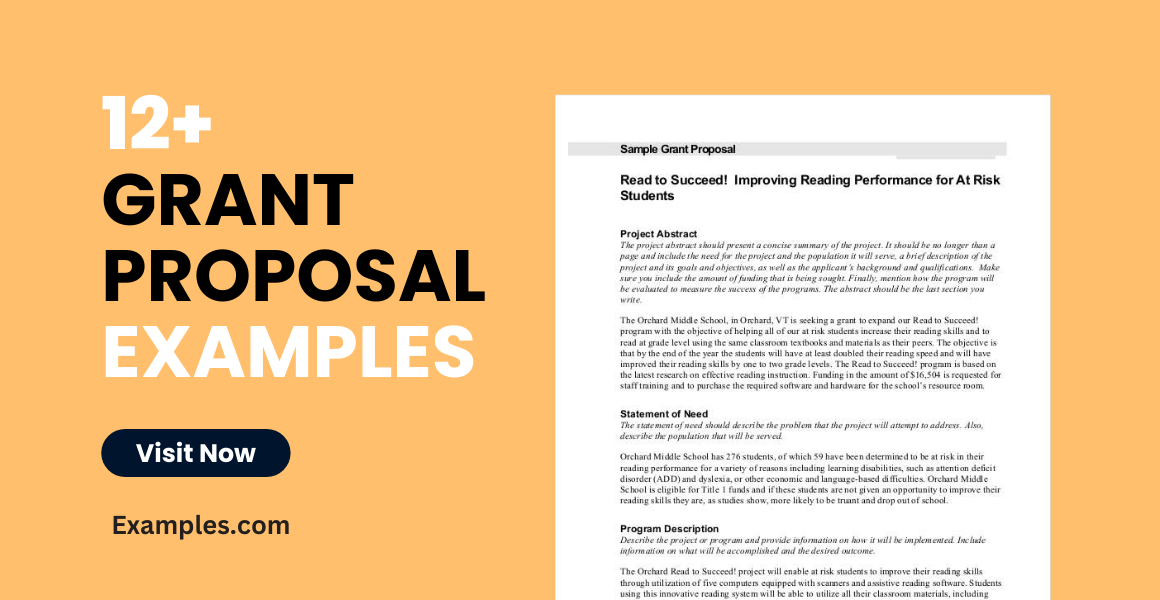
To guarantee funding for a program your non-profit has made, one has to come up with writing a proposal that not only describes the program but also justifies and substantiates the existence of your non-profit. A well laid out proposal details your strategy in connection to the purpose of the proposal and the funding needed to achieve it.
Grant Proposal Template
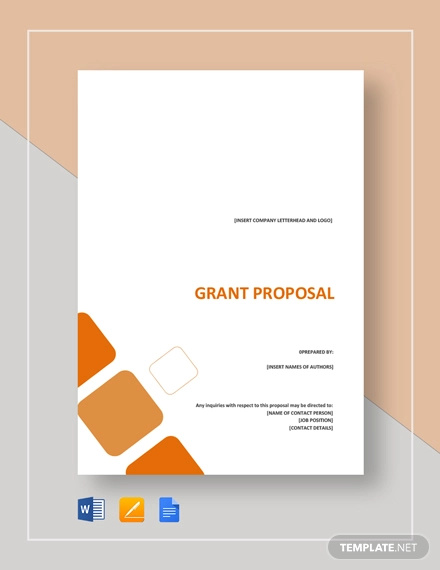
- Google Docs
Size: A4, US
If you are in search of a proposal that will help you assemble the needed resources to aid the organization in fulfilling its purpose, then you are in the right place. The above proposal template is one such template that can help you take the stress off creating a proposal from scratch. You can instantly download this, edit and customize it the way you like best. Outline your proposed project, the problems that you think should be solved, the methods of the project, the objectives, evaluations, etc.
Developing a Grant Proposal Example
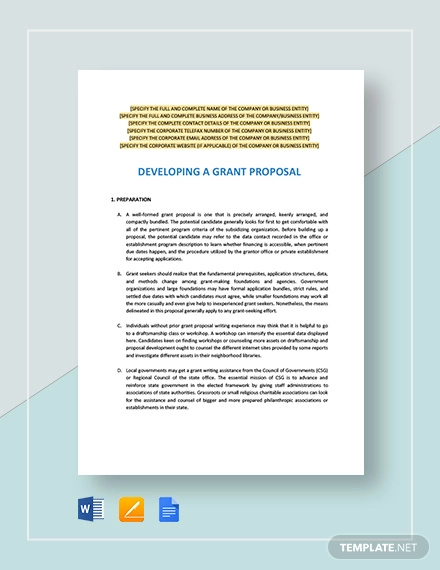
Writing a grant proposal is not easy. Learn how to write a grant proposal in a professional way with the help of the above template we have, specially designed for you. It’s essential to make your proposal shine among others to entice investors. With your incredibly busy schedule, drafting your own proposal might take longer than planned. That’s why we’re here to assist you and make your life a lot easier with our well-written template. All you have to do is download, customize and edit it to suit your needs best.
Restaurant Developing a Grant Proposal Exa.mple
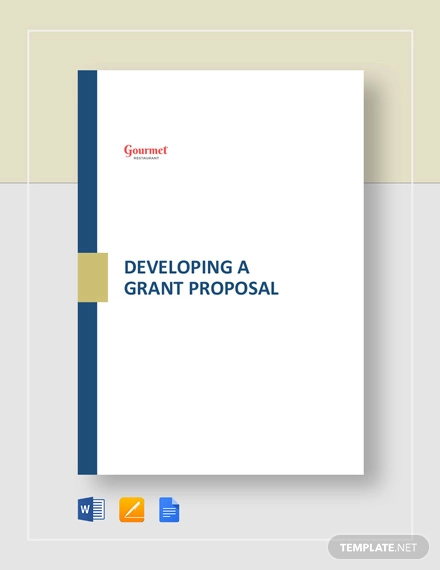
If you are looking for funding for your restaurant’s business idea and are in search of the right proposal, then we got just the right thing for you. The above writing example template will be of great help to you. Download the file at any given time and place to get immediate access. Clearly show your target market, its size, and other information you simply have to fill in. Edit the template further by removing or adding sections to custom fit to your specific purpose of the grant. Ensure acceptance of your grant proposal by using our template.
Grant Budget Proposal Template

Developing a Grant Proposal Template

Developing a grant proposal is not an easy task, especially if you need to make one from scratch. We got you here. Prepare to have your proposal accepted with the help of the above grant proposal template. Check free proposal examples for more. It can be easily edited and customized to suit your needs and requirements perfectly. Simply replace highlighted sections with your information and you’re done.
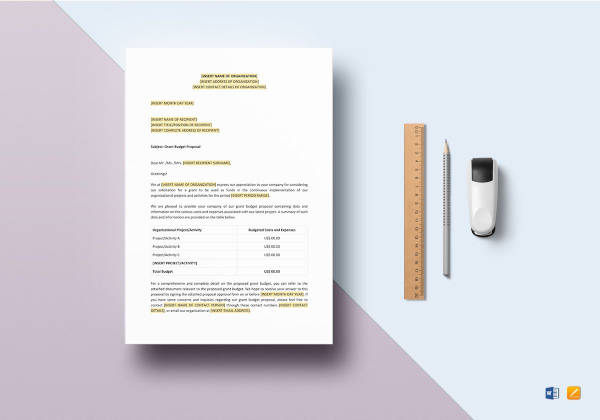
The goals and objectives of a grant proposal help you make the right goals and objectives that need to be made in the grant proposal. This grant budget proposal template allows an organization to study the necessary costs needed to operate. It can easily be edited and customized to suit your needs and requirements perfectly. It is not only limited to a computer, but you can download it on any electronic device easily. Check it out now!
Writing the Grant Proposal Template

The above template is a grant proposal template that can be instantly downloaded and edited to suit your company’s needs best. Easy to use, simply replace the highlighted text with the necessary detail. Grant proposal writing can help you write the best proposals.
Grant Research Proposal
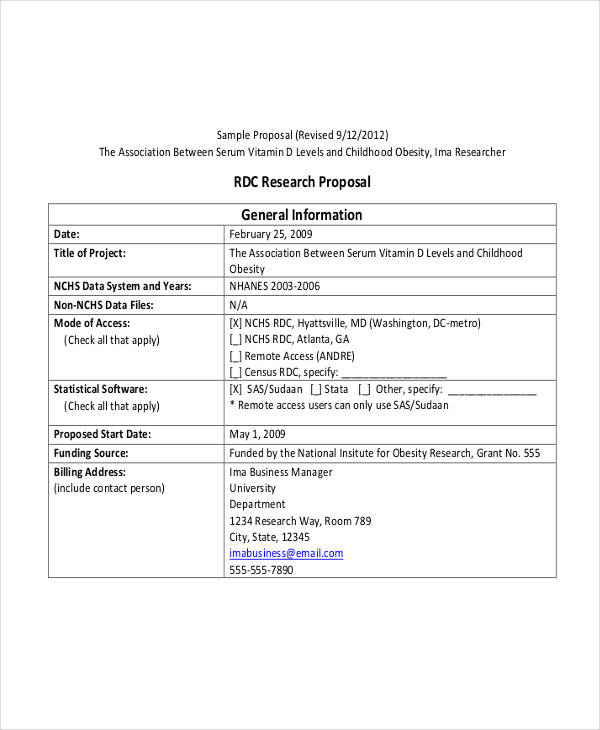
Size: 365 KB
Steps to Create a Grant Proposal:
Step 1: goals and objectives.
The first thing you need to do is to know what are your goals and objectives, so that you can easily make the right proposal, including all of them in it. This way everyone involved will know what is their main goal and how can they possibly achieve it in the best way possible.
Step 2: Requirements of the Proposal
Firstly, you should be through with the industry and market you are in. This way you can make the best use of the research in your proposal. Since clients or any potential investors will first look as to how much you know of what you are doing, it is always better to have a thorough research of the market you are in, knowing the strengths and weaknesses.
Step 3: Documentation
If there are any important documents that you need to make sure to add, then add them, This will add weight to the proposal, just in case needed. Investment proposal examples can be seen on the page to provide added information regarding the writing of such proposals. Be sure to click on any download link to access the samples. There are key points you need to highlight to make your proposal stand out.
Step 4: Budget
Budget proposal examples can be of great help to you while creating proposals of any kind and you need help when creating budgets for your organization, no matter which industry you work in. The budget here is basically to show how much the project will possibly cost. Mention all the details in the budget, so that it is easier for the others to understand what and where the expenses and the incomes would possibly come from.
Step 5: Proofread
It is very important to proofread the proposal throughout, just so you can make sure that you did not miss any important details. Review your proposal and make any changes that need to be made. Follow up with the clients you have produced your proposal so that they will know that you are actually interested in cracking this deal with them, but do not annoy or pressurize them. Patience is the key, so be patient to get any kind of feedback from the client.
Business Grant Proposal
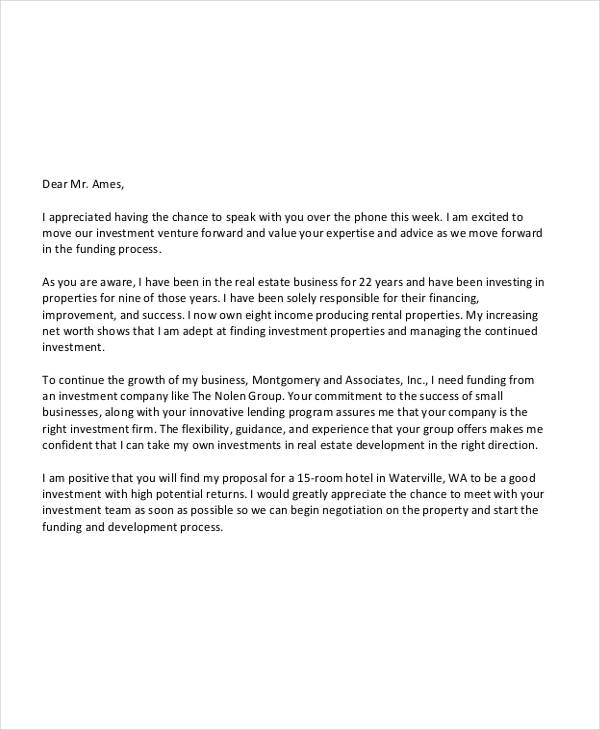
Size: 526 KB
What Is a Grant Proposal?
A grant proposal can be defined as a proposal for funding a project and is a request proposal for doing so. It can also be defined as a proposal that represents support for the parties involved in the proposal, mainly the funder and the nonprofit organization involved in it. It mainly represents a call to action on issues that the parties involved care more about. They are tools that advocate and invest in change.
Tips for Writing a Grant Proposal
- Identify a problem and agree on it.
- Define what needs to be done or achieved.
- Design the program tailored to meet the demands of the problem.
- Identify funding sources. It is a good idea to involve potential funder in the project.
- Professional proposal for review in accordance with requirements from the funding source and submit on or before the submission deadline.
Sample Grant
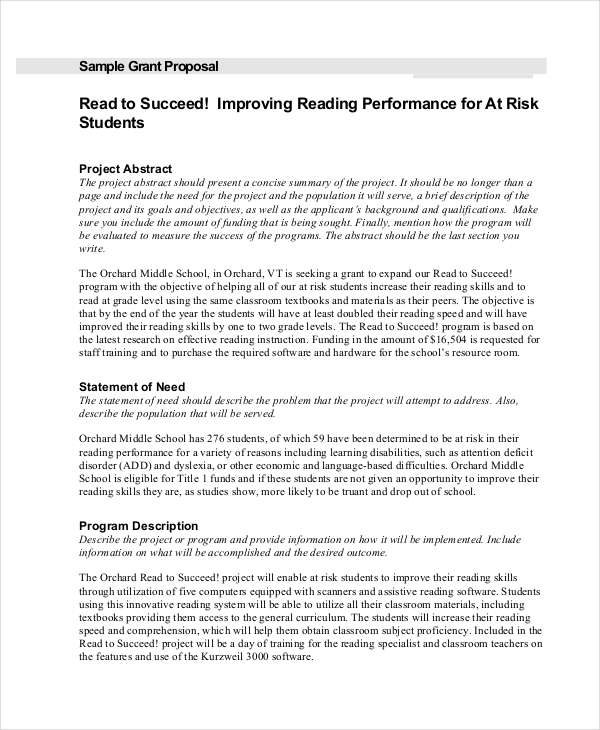
Size: 201 KB
Grant Planning Proposal
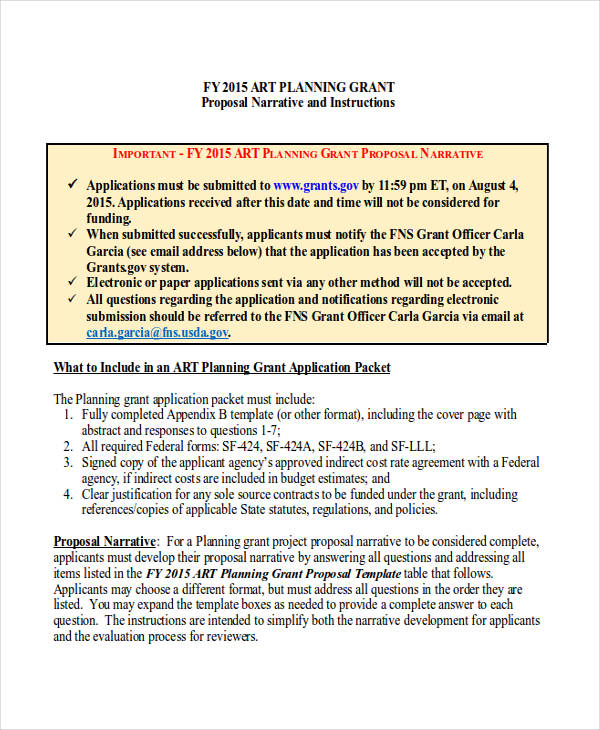
Size: 21 KB
Women Political Empowerment Grant Proposal

Size: 551 KB
Educational Grant
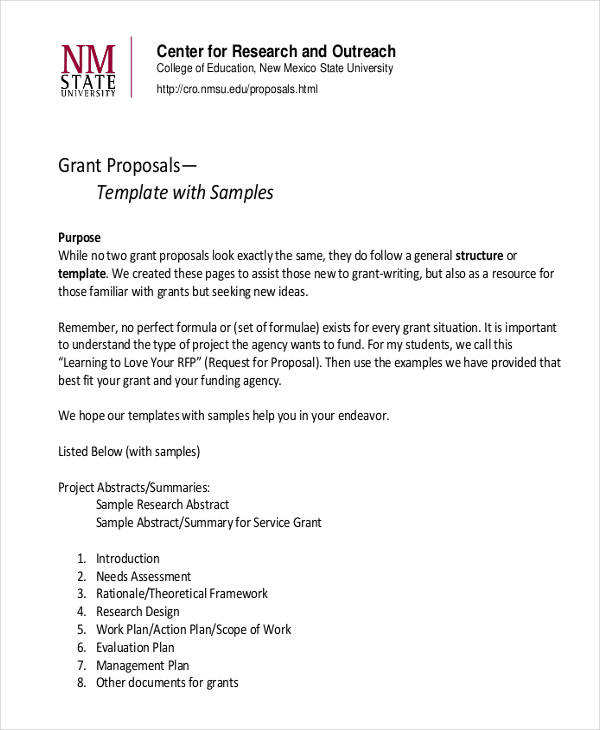
How to Develop a Grant Proposal?
Marketing proposal examples in the site provide further information regarding proposals and proposal writing. Be sure to check out samples by doing a search on our home page for the particular example you are looking for.
In developing a grant proposal, a standard format is usually made in the following order:
- Title page – The title of the proposal should be short and clear. It should be to the point and give a gist of what the proposal is about.
- Abstract – Should contain key elements of the project namely general purpose, specific smart goals , research design and methods, and significance.
- Introduction – An introduction basically acts as a cover statement of the problem, the main purpose of the research, the goals, etc.
- Literature discussion or review – Discusses the details of the project, procedures, and deliverables.
- Narrative of the project – Should answer all the reviewer’s questions.
- Personnel involved – A brief explanation of staffing requirements and skill sets needed or already have to fill in the need.
- Budget and justification of budget – Details of the budget and explanation in coming up with the budget.
Research proposal examples are also available on our site. Just go to our home page and do a search for the proposal you like. Feel free to download any or our samples by clicking on the download link button beneath each sample.
Text prompt
- Instructive
- Professional
Generate a proposal for a new school recycling program
Compose a proposal for a school field trip to a science museum.

IMAGES
VIDEO
COMMENTS
1. Title Page: Include the title of your proposal, your name or organization's name, the date, and any other relevant information specified by the guidelines. 2. Executive Summary: Provide a concise overview of your proposal, highlighting the key points and objectives.
Explain step-by-step in detail. Who: Identify the personnel you need, along with their prior experience to add persuasion to the proposal. 4. Conclusion: costs, benefits and wrap-up. Reiterate: The purpose and main argument. Costs: Break down the projected costs involved for different elements of the project.
Get verbal agreement from the client on your pitch and approach before putting it in writing with a proposal. Step 2. Create the cover page. Kick off your proposal writing with a compelling cover page (also known as the title page). The visuals and style take center stage here—it's your first impression after all.
A project proposal is a written document that describes a project you intend to execute. It usually includes your project's goals, methods, timeline, budget, deliverables, and resource requirements. Depending on the type and the scope of your project, you can choose what to include and what not to include in your proposal.
Step 9: Proofread and edit. Before sending your proposal out into the world, give it a thorough once-over. Take the time to meticulously proofread every nook and cranny, hunting down grammar slip-ups, punctuation quirks and sneaky spelling errors. A second perspective can catch things you might have overlooked.
Step 1: Write the Executive Summary. Coming up with an executive summary is the first step to take when writing a project proposal. It's a relatively shorter section designed to give investors and stakeholders a brief overview of the most important information about the project.
This free project proposal template for Word will provide you with everything you need to write an excellent project proposal. It will help you with the executive summary, project process, deliverables, costs—even terms and conditions. Download your free template today. ProjectManager's project proposal template.
Read on to find proposal writing examples for the most popular proposal sections, including the cover page, executive summary, deliverables, pricing, and more. Proposals are how you show the client what your business has to offer, and how you convince them that you're the one for the job. Writing a proposal can seem daunting at first, but it ...
1. Discover the client's needs. The first step is to understand the client's current challenges and goals. As part of your discovery process, you might conduct a single sales call, or several. Some companies actually charge for a longer discovery or audit process, and use a proposal to sell that introductory service.
Your project proposal should summarize your project details and sell your idea so stakeholders feel inclined to get involved in the initiative. The goal of your project proposal is to: Secure external funding. Allocate company resources to your project. Gain stakeholder buy-in. Build momentum and excitement.
Here's an example of what a business proposal template looks like when done right: 2. Explain your "why" with an executive summary. The executive summary details exactly why you're sending the proposal and why your solution is the best for the prospective client. Specificity is key here.
This proposal template makes it easy to input a map to showcase your business's various locations, your team, your workflow and more. Simply plug in your information, find relevant photos, change the fonts and colors, and complete your proposal design. Design Tip: Play with columns or rows in your proposal.
Research proposal examples. Writing a research proposal can be quite challenging, but a good starting point could be to look at some examples. We've included a few for you below. Example research proposal #1: "A Conceptual Framework for Scheduling Constraint Management".
Section 1: Executive summary. Write an introductory section, called the executive summary, to summarize your project. Just like the introduction of an essay, this section should aim to catch your recipient's attention and encourage them to read on. Your executive summary should include details about the following:
Below, you can see business proposal examples that demonstrate how to include these 10 sections. 1. Create a compelling business proposal title. A compelling title could mean the difference between someone reading your proposal or ignoring it in favor of a competitor's .
Critique: There are no clear financials or pricing details, which is often what clients are looking for in a proposal. 4. Engineering Services Proposal. Here, the Project Background sections clearly outline the work process for the client. Each task is clarified and seems to respond to the specifications of an RFP.
A project proposal helps you get a buy-in at your organization. It creates clarity about the goals, priorities, and requirements of the project. It forces the project initiator to think through the project details before pitching it. After the project proposal is approved by all the stakeholders, it becomes the foundation of the project plan.
6 Steps to writing a project proposal. Even though you need to customize each proposal for the intended audience and project in question, these six steps can act as guidelines to ensure you create a compelling project proposal. 1. Write the executive summary.
3. Table of contents. A table of contents is an important, but often overlooked, part of any longer document because it helps the reader know what they can expect to find in the proposal. Unless your business proposal is very brief, include a table of contents that outlines the basic structure of your document.
1. Cover Page. It's hard to judge a book by its cover, but you can guess how well it will sell. A sales proposal cover page that is clean and informative, including the client's name, your name and contact info, and the date submitted, is key to gaining and keeping a client's attention.
Writing a business proposal that wins clients over is tough work. It gets even tougher when you're competing against multiple vendors for the same contract. According to a recent report by Loopio, teams on average win only 44% of their Request for Proposals (RFPs). Here's the silver lining.
Project proposal examples . A project proposal in project management is primarily sent to the stakeholders to secure funding, gain approvals, and request resources from stakeholders. Here is a real-world example to get an idea of how to write a proposal for a project: Project Proposal: Implementation of a CRM System to manage company customers ...
You can't stop writing proposals, but you can start using them to make a killer first impression and attract the best clients. ... Take a look at the proposal examples on this page for a good guide on length. 2. Use Revenue Power-ups (to Boost Sales) Proposals with upsells generate 32% more revenue. The key is to offer enhanced options. That ...
Step 1. Define your project goals. When I make a budget, I start my proposal by defining the specific objectives and expected outcomes of your project. This step is crucial for setting the tone for the entire proposal by immediately conveying to stakeholders the significance and feasibility of my project.
Mention why the chosen venue and timing are ideal. Agenda: Outline the event schedule with specific activities and timings. Include any special sessions, keynote speakers, or entertainment planned. Theme and Design: Describe the event theme, design elements, and how they enhance the event experience.
Learn how to write a perfect proposal essay with our full guide. You will find tips for essay preparation and structure, as well as some samples for inspiration. Essay Editor; ... Academic Research Study Proposal Sample 2024. Here is a sample idea for an interesting proposal paper:
Developing a Grant Proposal Example. Details. File Format. Google Docs; MS Word; Pages; Size: A4, US. Download. Writing a grant proposal is not easy. Learn how to write a grant proposal in a professional way with the help of the above template we have, specially designed for you.
Add quotes and statistics. Proofread carefully. 1. Write a compelling headline. The headline is the first — and sometimes the only — thing people read. Your headline should be concise, specific, and attention-grabbing. If you could summarize the whole press release in one sentence, it would be the headline.